Port Laing Submarine Mining Station
The Port Laing Submarine Mining Station – 1898 to 1906
Introduction
 The Guv’y Pier
The Guv’y Pier
The “Guv’y Pier” is a much-photographed landmark lying just off the coast at Port Laing.
Circa 1898-1900. Remains of submarine mining pier. Remnants of concrete substructure to coast; substantial remains of platform pier cut off from land with cast-iron supports and wrought-iron cross-bracing; metal railings to top.
The War Department acquired the land related to this pier in 1898. The pier went on to play an important role in World War I and II Forth Bridge and Rosyth defences. The Carlingnose pier was used for handling mines and is related to the former submarine mining station which had observation and gun posts for controlling and defending the minefield.
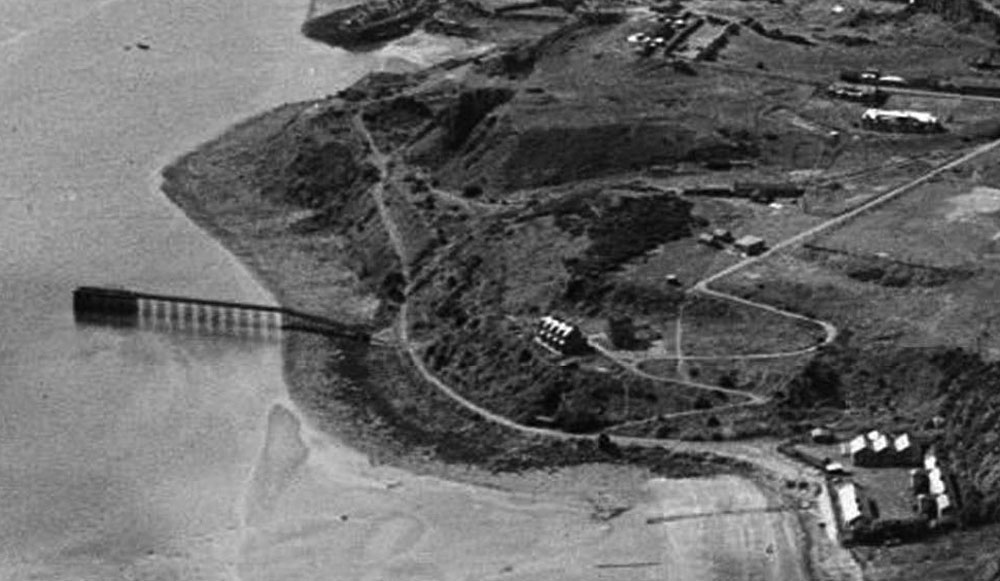
Also in close proximity is the scheduled Carlingnose Battery used during the First World War. Map evidence shows a former tramway line which connected the pier to the mining station located at the south end of Port Laing (this site now demolished). The 1913 map also indicates that there were cranes on the platform pier to lift the mines.
A category B listing has been given as this pier exists as a fragment.
All a bit vague – what was a “submarine mining station”?
First of all a “submarine mining station” has nothing to do with submarines, or with coal mining.
A submarine mine is an underwater explosive mine, moored to the sea-bed.
Submarine Mining – a history lesson
The submarine mining service of the British Army operated from 1863 to 1906, as a low-cost and efficient part of the defence of our naval and commercial ports.
The idea of destroying ships by means of sea-borne devices (torpedoes and mines) as opposed to gun-fire dates back to the 16th century. Free-floating drifting mines were deployed by the British Navy against the French Fleet off Rochelle in 1682.
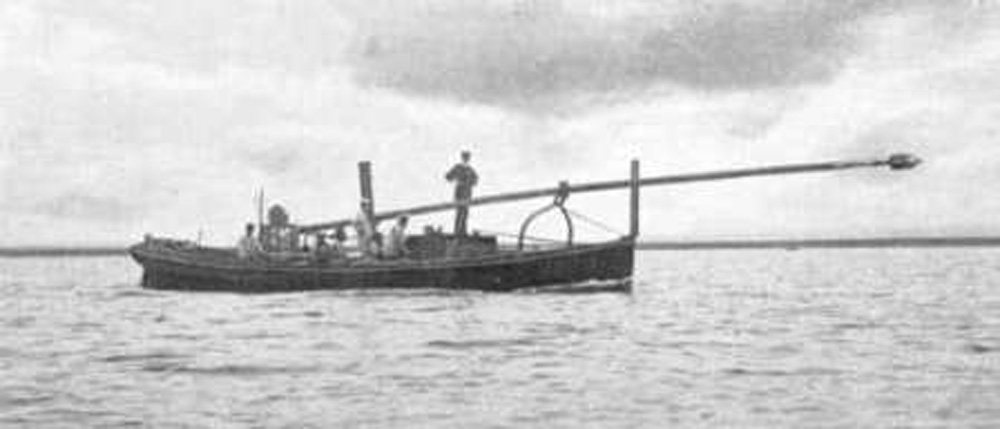 A spar-mounted torpedo was attached to the bow of a surface-ship as shown here, or a submarine.
A spar-mounted torpedo was attached to the bow of a surface-ship as shown here, or a submarine.
The spar was lowered from its transport position so that the explosive charge could be rammed against the side of an enemy ship. Spar-mounted torpedoes were used in the 19th century, being widely deployed by the Confederation Army during the American Civil War.
The self-propelled torpedo, launched from a surface-ship, submarine or aeroplane was a later development, perfected by the British engineer Robert Whitehead in 1866.
A “mine” was any device that was either moored in a fixed location, or drifted with the water.
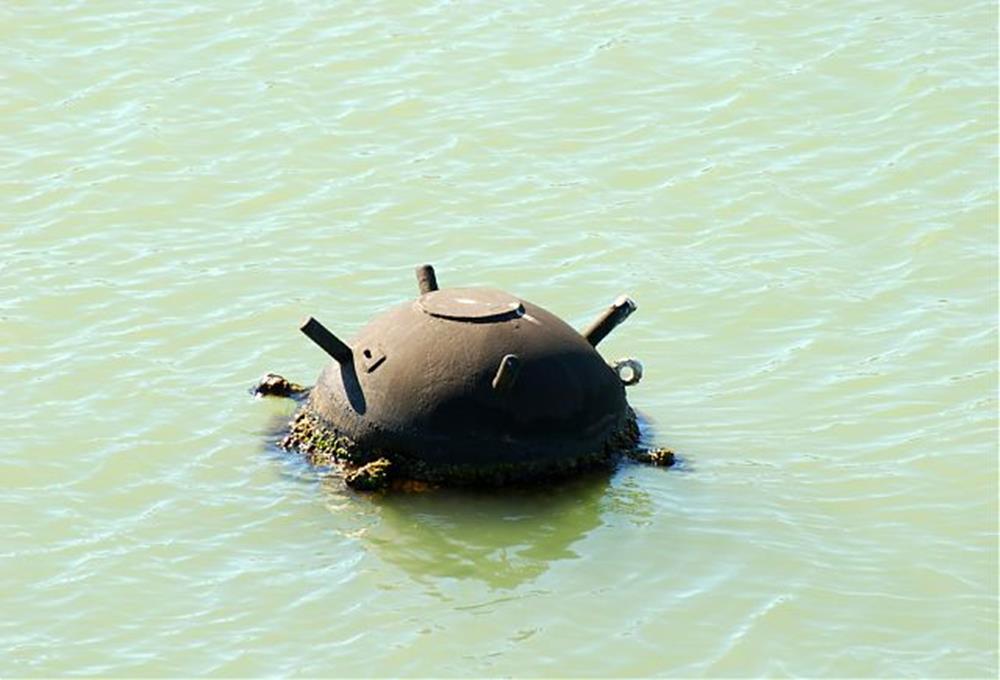 My mental image of a mine is a big ball covered with horns, bobbing on the sea waiting for an enemy ship to hit one of the horns, triggering a devastating explosion.
My mental image of a mine is a big ball covered with horns, bobbing on the sea waiting for an enemy ship to hit one of the horns, triggering a devastating explosion.And that indeed is how an offensive mine operates. Laid in the path of enemy shipping it sits passively until triggered by a collision, or by proximity in the case of magnetic mines.
But how can a mine be used as a defensive weapon to safeguard a port? How could it be made to distinguish between enemy and friendly ships? The solution is to have a controllable mine that can be switched on and off. Switched off during the day a defensive minefield allows ships to pass safely overhead, but once switched on – at night, or on spotting an invading force – it forms a protective screen.
And that was the task of a submarine mining station. In the event of a war being imminent, they would deploy the mines; test them to ensure they were correctly connected, replace any that were fired, and control the mines, either firing a mine directly when an enemy ship was overhead its location (an observation system), or arming the whole minefield to be triggered by collision sensors in each mine (a circuit closer system.)
These mines and associated mooring systems and connecting cables were held on shore in store rooms adjacent to the minefield control room. In case of an impending threat, an entire minefield could be deployed in less than 48 hours.
War Office Investigations
In 1863, the War Office established a committee to investigate the potential of controlled mines in defending “our channels.” A number of experiments and trials were conducted to determine the best type of explosive, the amount required, the depth of deployment and the nature of the coastline and tidal flow.
Recommendation
By 1870 they concluded that electrically controlled minefields should be deployed to protect the Royal Navy bases on The Medway (including the Thames), at Portsmouth, Plymouth, Pembroke and Cork. They were also to be deployed at our overseas naval base: Bermuda, Malta, Halifax (Nova Scotia), Jamaica, Mauritius, Trincomalee (Sri Lanka), Singapore and Hong-Kong. And finally to protect commercial and other ports at home: Aberdeen, the Tay, the Forth, the Clyde, the Tyne, Hull, Yarmouth, Harwich, Falmouth, the Severn and Liverpool.
They decreed that:
1. Mines should only be placed under the protection of the guns of ships or forts.
2. They should be placed about 1000 yards in front of these guns.
3. The minefield should be protected by armed vessels to safeguard against sabotage.
4. The controlling electrical cables should be protected on the seabed with parallel chains, to prevent then being dragged out of position.
5. The locations of mines and stations should be kept secret from charts and maps.
6. Dummy mines should be liberally deployed to deceive the enemy.
7. Electric lights should be deployed for night-time operations.
8. The most important must have diving apparatus and divers to examine deployed mines without the time and expense of raising and redeploying them.
A series of experiments in from 1874 to 1876 was conducted at Gosport near Portsmouth using an old hulk, the Oberon. She was fitted out with equipment to simulate a state-of-the-art war ship, and used to determine the best way to destroy such a ship using a minefield. This resulted is a standardized set of specifications for the types of mine, size of charge and layout of the minefield.
The initial focus was on the Royal Navy bases, and over the period 1870 to 1880, five Royal Engineer companies were established. They set-up mining stations on the Medway at Chatham (the Headquarters of the submarine mining service), Sheerness, and Gillingham; the Thames at Gravesend; Portsmouth; Pembroke; and Cork, and overseas stations at Bermuda, Halifax and Malta. Central stores were established at Woolwich, and 1,800 mines were purchased by the end of 1872.
Further experiments were undertaken to determine the speed at which minefields could be deployed, how effective they were against wooden- and iron-hulled ships, how to defend them against attacks by mine-sweepers, and how reliable individual mines were once deployed in a minefield.
These experiments highlighted the need for powerful searchlights to spot enemy ships and minesweepers at night. Initially the electricity to power the searchlights was produced on-site using steam-driven generators. It took about 2-3 hours for the boilers to raise the necessary head of steam. In 1894, paraffin-oil-powered engines were introduced to drive the generators. These could be started and brought up to speed in about 20 minutes.
In 1897, parabolic reflectors and improved lenses were introduced for the searchlights.
Finally “it was determined that as the role of the Royal Navy was the active defence of Great Britain, no Naval vessels should be tied to the shore, so the sedentary defence of the sea and ports should be in the hands of the Army, and in particular the Royal Engineers.”
The Royal Engineers invented military diving in 1838, and taught the first Royal Navy divers.
In 1911, the Air Battalion of the Royal Engineers became the first unit responsible for manned balloons, airships and kites. The Air Battalion became the Royal Flying Corps in 1912, and subsequently the Royal Air Force in 1918.]
Manpower issues – Militia and Volunteers
The nature of the submarine mining service created some manpower issues. The service required a number of dedicated teams trained and regularly practised in a particular set of skills, each tied to a specific geographical location. These teams were on long-term standby, as the minefields would only be deployed in time of war. Not an efficient use of full-time soldiers.
This problem was eventually solved by the raising of Militia units to defend the Navy bases, and Volunteer Corps to defend commercial ports, both overseen by a dedicated unit of full-time Royal Engineers, the Coast battalion.
[The Militia were originally reinforcements for the regular standing army, with each county being obliged to provide a number of men. By the 19th century, the element of compulsion had disappeared; men would volunteer and undertake basic training for several months at an army depot. Thereafter, they would return to civilian life, but report for regular periods of military training (usually on the weapons ranges) and an annual two-week training camp. In return, they would receive military pay and a financial retainer, a useful addition to their civilian wage. Traditionally the militia were trained as infantry, but in 1852 artillery units were formed.]
Submarine Mining Militia units were formed in Portsmouth, the Needles, Plymouth, the Thames, Medway, Harwich, Milford Haven, the Humber, Falmouth and Cork. They went through a simplified training program, with annual exercises which lasted up to 55 days. Officers were trained in the deployment and management of the mines, while NCOs and men were trained as boatmen and focussed on water work.
25% of the total strength of the officers of a militia division could be attached annually to the local Royal Engineer Company for defence practice of two months during which they took their full share of regimental and mining work.
Officers and men were initially paid Militia pay according to rank. In 1893 they were placed under the general Regulations for Engineer pay, and given rates of pay according to their trade proficiency.
As well as training in the handling of mines, the men had 77 days of preliminary drill including musketry, and then had 55 days annual training – the maximum permissible for the Militia. They were part-time soldiers.
Volunteers
In 1880, with the Royal Navy bases covered, the topic of minefields to protect commercial ports was again on the agenda. The manpower problem was tackled by the formation of a Coast Corps of the Royal Engineers who then trained and oversaw local Volunteer Corps, and the Militia.
Volunteers and Militia went through the same standardised three part training course.
1. Shore work (one month’s duration)
2. Water work (one month’s duration)
3. Electrical work (two month’s duration)
Volunteer officers and men were paid 10s and 5s a day respectively during this training.
By the end of 1891, the Submarine Mining Service comprised:
Regulars: 92 officers and 1272 other ranks
Militia: 68 officers and 1260 other ranks
Volunteers: 1,806 in total (all ranks)
There were volunteer divisions at the Tay, Forth, Clyde, Humber, Tyne, Tees, Mersey and Severn. Submarine Mining defences manned by regulars and militia were eventually in place at 28 Royal Navy bases around the world.
There were 31 mine-layers, 31 launches, 56 other vessels and 47 electric lights sets.
In addition to the specialist mine-laying vessels, open boats were hired from local fishermen to make connections and test the electrical cables that connected the mines to the controlling shore station in each minefield. About 3 or 4 of these boats were required for each mine-layer.
In 1897 a specialised Corps of Electrical Engineer Volunteers was formed to manage the rapidly-growing deployment of electric lights at the Mining Stations.
Practice Sessions
As well as introductory training and annual drill sessions, a vital element of training involved practice sessions. The object of these was to rehearse as far as possible the actual work of laying out a minefield.
Plans of a special minefield were prepared. Mines were drawn from stores, loaded with sand and gravel instead of guncotton. The firing apparatus (detonator in the mine) was prepared and tested. Cables were cut to size. The mines were then deployed, with cable running to the shore station all connected up and tested. Every operation except the actual handling of guncotton and detonation of mines was carefully rehearsed, so that every man was familiar with the various tasks allocated to each work party.
These annual practices usually lasted about three months. At the end of a practice all items were cleaned and returned to stores.
The practice area was usually part of where a live minefield would be deployed, but the actual location of each mine field was kept secret. Plans were held by the War Office and would be issued if war was imminent.
Submarine Mining divisions round the British Isles
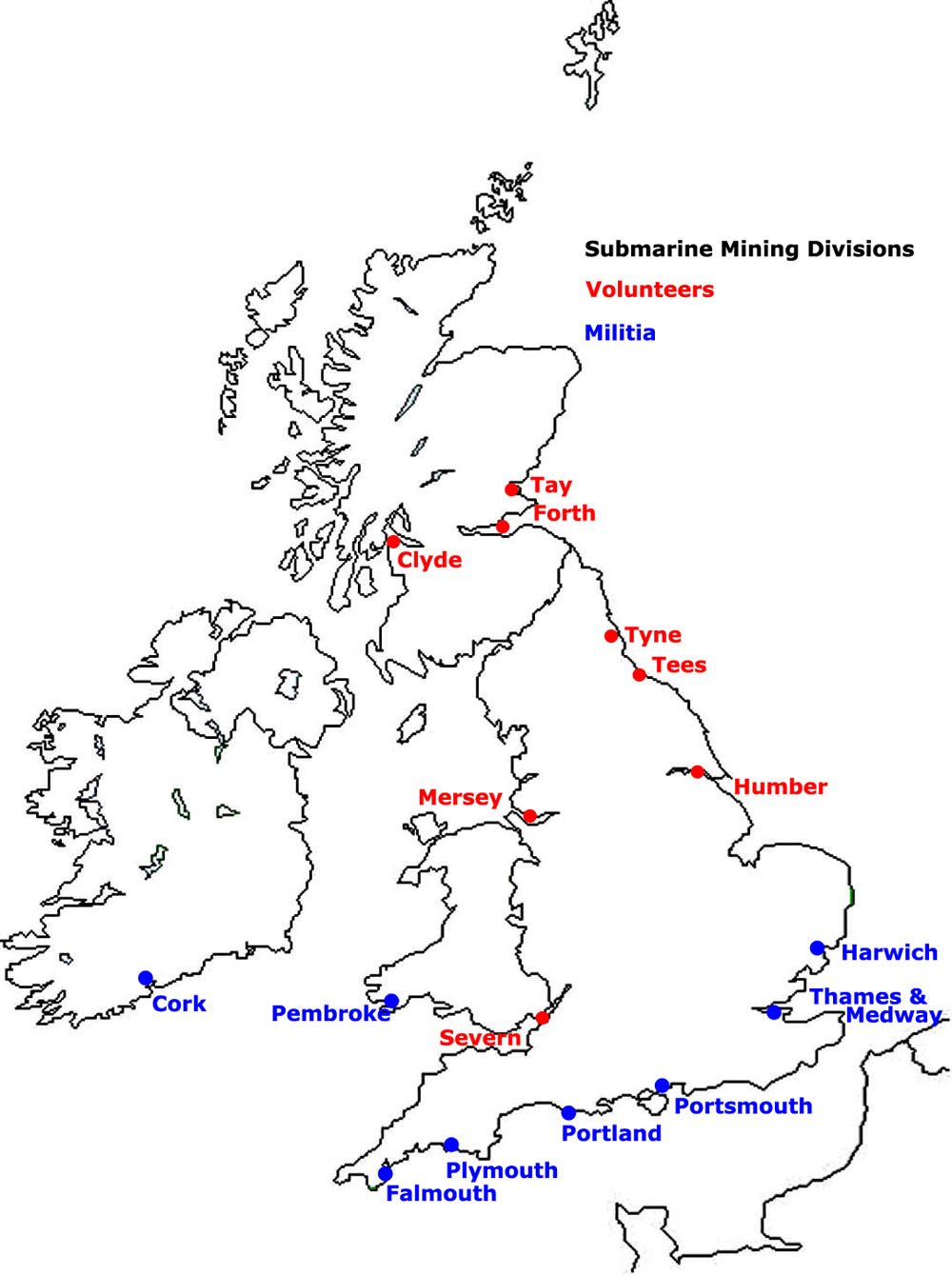
Submarine Mining divisions around the world (all at naval bases)
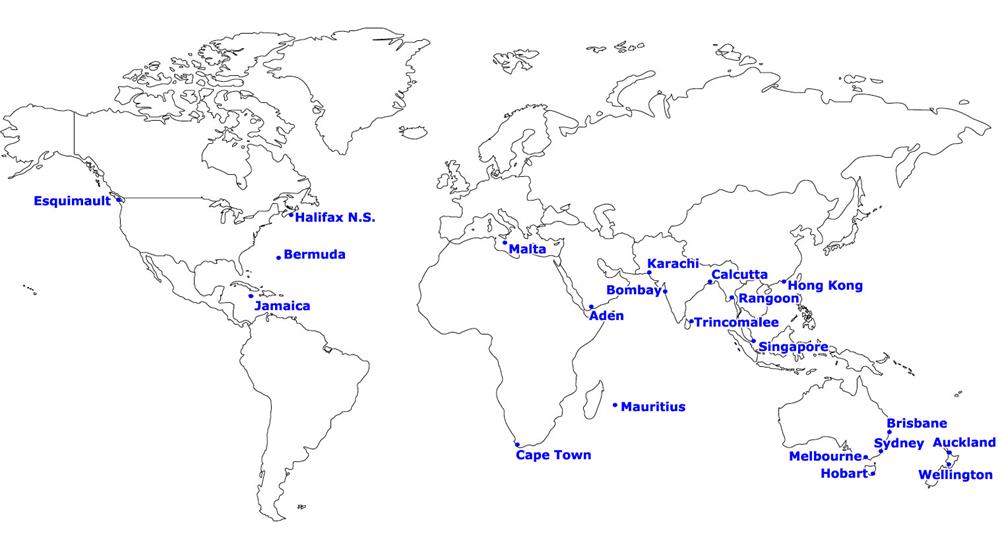
A minefield defending an estuary

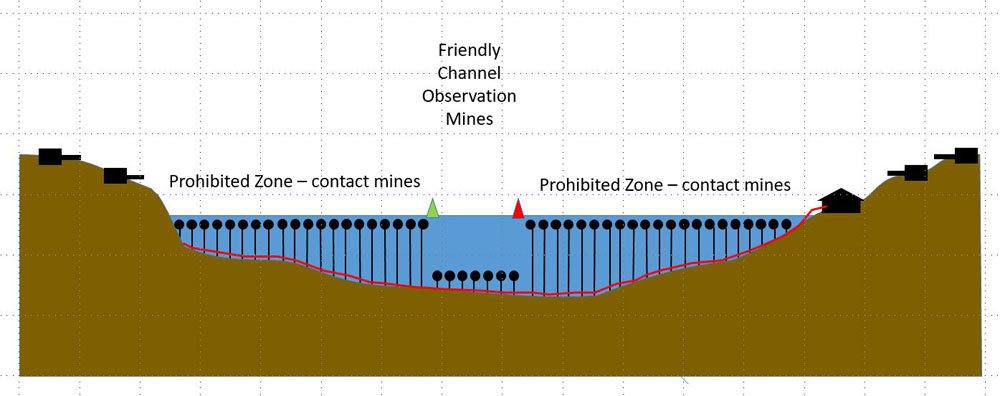
This diagram shows how a typical minefield was laid out across an estuary. A 400 yard [365 metres] wide “friendly channel” was marked with red and green buoys. The friendly channel was flanked with no-go prohibited zones seeded with contact mines.
These contact mines were electrically operated. They could be turned off, so that friendly ships would not be destroyed if they strayed into the no-go zone. The contact mines were anchored to the sea bed and set at a depth of a few feet below sea level. They were laid out in off-set lines, so that there was effectively one mine every 25 feet [7.5 metres] making this an impenetrable zone for enemy ships, which would trigger an explosion on making contact with one of these mines. Contact mines are effective at night or in fog or smokescreens, but are at risk of being snagged by friendly shipping and dragged out of position.
The friendly channel was protected by Observation Mines resting generally moored at a depth of 30 to 60 Feet [10 to 20 metres] or resting on the sea-bed in shallow waters. These mines could be detonated by an observer on shore when an enemy ship passed overhead. These observation mines carried a large explosive charge, sufficient to sink a ship, despite not being in contact with it.
The friendly channel was also the target of the shore-based gun batteries, and electric search lights. Enemy ships heading towards a port or up an estuary were forced to sail into the friendly channel or be destroyed by the contact mines. The shore batteries and their associated search lights were able to focus on the friendly channel making it impassable to enemy ships.
The Submarine Miners deployed and managed the minefield and the Searchlights, while the Royal Artillery manned the guns.
Submarine Mining in the Forth
The Forth Volunteer Division was raised at the end of 1887 by Capt. F. Grant Ogilvie with Mr Theodore Salvesen, of Leith, as First Subaltern, and Lieut. (later Major) James Organ, Coast Battalion R.E. as Adjutant and Instructor.
In the beginning of 1888, three more officers were gazetted as 2nd Lieutenants:
Mr. Henry M. Cadell, of Grange, Bo’ness, J.P.;
Mr James Currie, jun., ship-owner, of Leith, and
Prof. T. Hudson Beare, of Edinburgh,
while Lord Hopetoun (afterwards Marquis of Linlithgow), a large riparian proprietor on the Forth, showed his good-will by becoming Hon. Colonel.
Of these, only Cadell, who had served previously for six years in the Queen’s Edinburgh Rifle Volunteer Regiment, remained till the end of submarine mining, commanding the corps at the time of the Royal Review in 1905. He kept a diary of the Corps activities from 1888 to 1905, and photographs of some of the training camps.
When the submarine mining service ended in 1907, the corps comprised 16 officers and 243 other ranks.
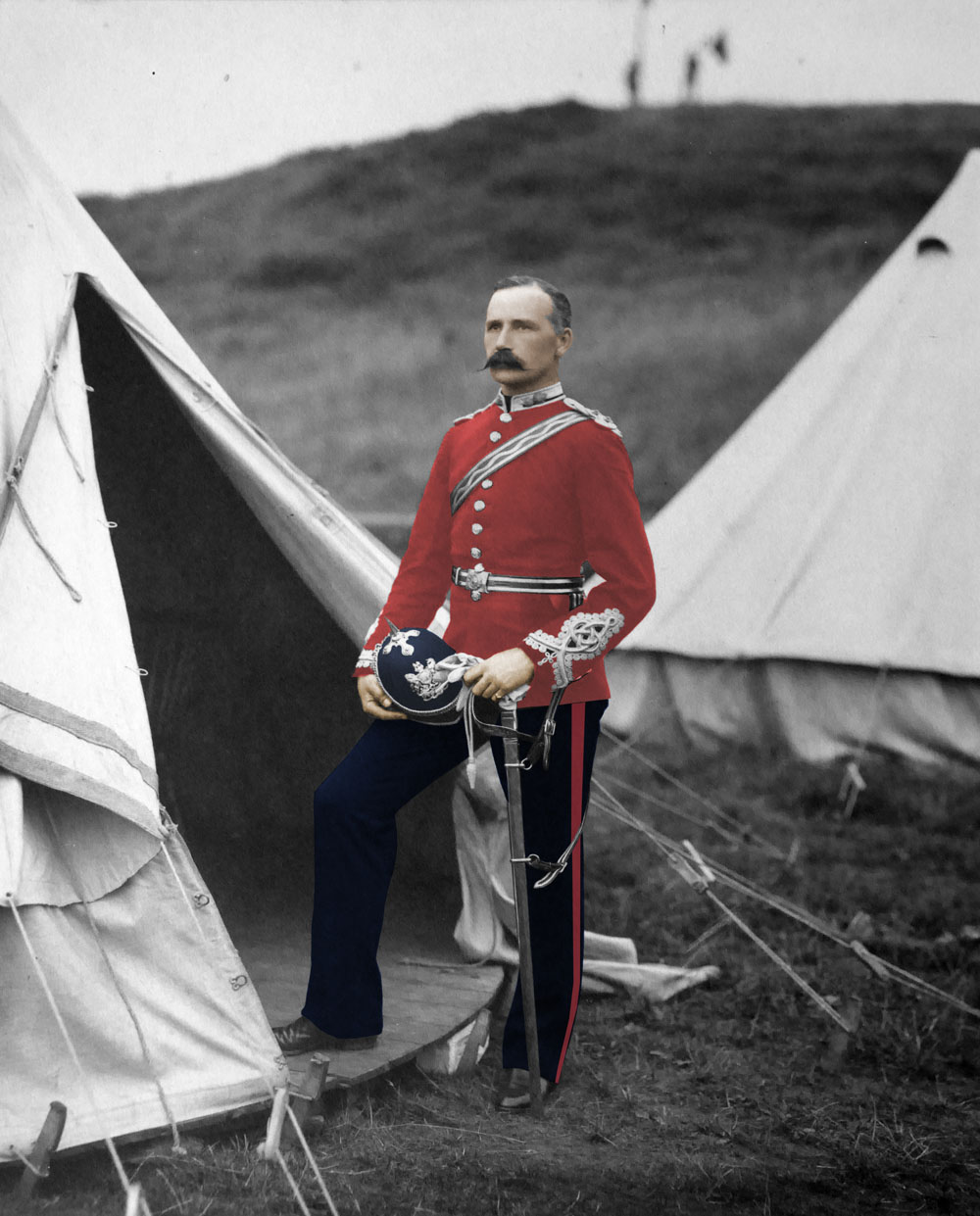 Captain Henry M Cadell in full dress uniform at a training camp in North Queensferry, 1900.
Captain Henry M Cadell in full dress uniform at a training camp in North Queensferry, 1900.
Names of Field Officers and Captains
Hon. Colonel Commandant Right Hon. Lord Hopetoun . . . 1888 Commanding
F. G. Ogilvie (Major 31st Mar. 1888. Retired 1890) In Command, 1888 – 1900
T. Salvesen (Capt. 2nd Apr 1888, Major 12th Dec 1900,
Lieut-Colonel 1st Apr 1903, Retired 1904) In Command, 1900 – 1904
H. M. Cadell, V.D. (Capt. 4th May 1889, Major 1st April 1903,
Lieut.-Colonel 28th Jan 1905, Retired 1906.) In Command, 1905 – 1906
C. D. Murray (Capt. 20th Sep 1899, Major 25th Mar 1905) In Command 1907 – 1907
Other Officers
T. H. Beare (Capt. 31st Mar. 1888.) Resigned 1899
S. Smith (Capt. 6th Jun 1900)
A. Ogilvie (Capt. 16th Feb 1901)
J. Cowan (Capt. 17th Feb 1906
The Post Office Edinburgh and Leith directory 1893-1894 provides a few more names
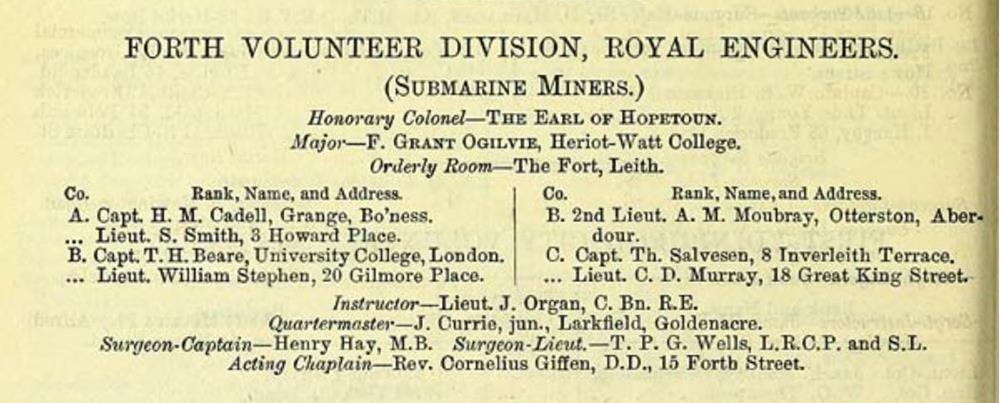
FORTH VOLUNTEER DIVISION, ROYAL ENGINEERS.
(Submarine Miners.)
Honorary Colonel — The Earl of Hopetoun.
Major — F. Grant Ogilvie, Heriot-Watt College.
Orderly Room — The Port, Leith.
Co. A
Capt. H. M. Cadell, Grange, Bo’ness.
Lieut. S. Smith, 3 Howard Place.
Co. B
Capt. T. H. Beare, University College, London.
2nd Lieut. A. M. Moubray, Otterston, Aberdour.
Co. C
Capt. Th. Salvesen, 8 Inverleith Terrace.
Lieut. William Stephen, 20 Gilmore Place.
Lieut. C. D. Murray, 18 Great King Street
Instructor — Lieut. J. Organ, C. Bn. R.E.
Quartermaster — J. Currie, jun., Larkfield, Goldenacre.
Surgeon-Captain — Henry Hay, M.B. Surgeon-Lieut. — T. P. G. Wells, L.R.C.P. and S.L.
Acting Chaplain — Rev. Cornelius Giffen, D.D., 15 Forth Street.
These were a distinguished collection of men, who could spare the time to be volunteer officers.
Lord Hopetoun (Marquis of Linlithgow) went on to become the Governer of Australia
Theodore Salvesen was the son of Christian Frederik Salvesen (1827–1911), the Norwegian born founder of the Christian Salvesen shipping line of Leith. Theodore studied Law, becoming a Queen’s Counsel in 1899.
Mr James Currie, jun. MA FRSE of Larkfield, Goldenacre, was owner and senior partner of the international shipping company, the Currie Line plus a keen amateur botanist, mineralogist and archaeologist becoming secretary of the Edinburgh Geological Society.
F. Grant Ogilvie was Principal of Heriot-Watt College, and Director of the Edinburgh Museum of Science and Art, in 1914, Ogilvie was appointed as a scientific advisor to the Munitions Invention Department of the Ministry of Munitions.
Prof. T. Hudson Beare was successively Professor of Engineering at Heriot-Watt University, then, at University College, London and finally Regius Professor of Engineering at Edinburgh University.
Henry M. Cadell was a Scottish geologist and geographer, noted for his work on the Moine Thrust, the oil-shale fields of West Lothian, and his experiments in mountain building published in 1888. He also travelled extensively abroad, for example in 1899 he travelled the length of the Irrawaddy River in Burma. He is especially remembered for his working models, explaining geomorphology, the science relating to the folding of rock beds. He was a member of the Edinburgh Geological Society, and the Royal Scottish Geographical Society and elected a Fellow of the Royal Society of Edinburgh in 1887.
A.M. Moubray – the Moubrays of Otterson, Aberdour are an old Fife military family who first settled here in 1511.
First Enrolment
The first enrolment of recruits took place in May 1888. This pamphlet explained the conditions of service and the work involved.

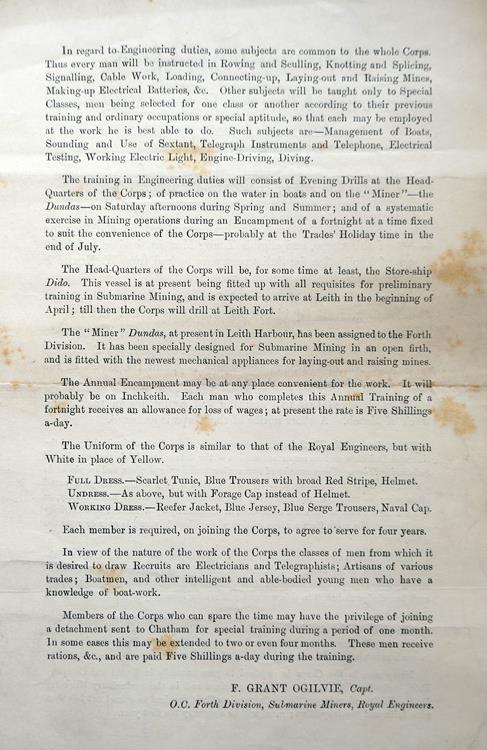
ENGINEER VOLUNTEERS.
Submarine miners, Royal Engineers.
________________________________________
FORTH DIVISION
Honorary Commandant –
THE RIGHT HON. THE EARL OF HOPETOUN.
____________________________________________
Arrangements have now been completed for the Training of this Corps, and eligible Young Men are invited to join it. Forms of Application for Enlistment may be had from W. Nimmo & Co. Stationers, 42 Constitiution Street, Leith.
Those ought to be filled up and forwarded at once to the Officer Commanding, Forth Division, Submarine Miners, R.E., Leith Fort.
All who give in their names will be summoned to an early Meeting, when the Officer Commanding will complete the Enrolment of those whose applications are satisfactory, and the Rules of the Corps will be submitted to the members.
It is expected that the training will commence in the second week of March. A short notice of the Corps is annexed.
The defence of the Forth has been considered by the Authorities in charge of the National Defences, and an important section of the defences resolved upon consists of Submarine Mines. These consist of iron cases containing explosives, and are placed in a waterway in such positions that by their explosion they would damage a vessel attempting to use the passage. The explosion is caused either mechanically, as when a vessel bumps against a mine-case, or electrically by a current of electricity sent through the mine from a shore station when a hostile vessel is over or near the mine.
Should war become imminent it will devolve upon the Forth Division, Sunmarine Miners, to lay out all the Submarine Mines necessary in the Firth, and to have all the shore arrangements ready for their use. It is the duty of the Corps to acquire such knowledge and skill in this work as will render it worty of the trust conferred upon it.
The plans for the distribution of the mines will be retained by the War Office until it may become necessary to apply them, but the Corps will be practised annually in work involving all the essential features of the system.
Every man in the Corps is required to pass annually in Squad and Company Drill, including the Manual and Firing exercises, and in the prliminary Musketry Drill. With a view to practice in these points he is required to attend not less than nine drills and the Inspection; more will be necessary the first year.
In regard to Engineering duties, some subjects are common to the whole Corps. Thus every man will be instructed in Rowing and Sculling, Knotting and Splicing, Signalling, Cable Work, Loading, Connecting-up, Laying-out and Raising Mines, Making-up Electrical Batteries, etc. Other subjects will be taught only to Special Classes, men being selected for one class or another according to their previous training and ordinary occupations or special aptitude, so that each may be employed at the work he is best able to do. Such subjects are – Management of Boats, Sounding and Use of Sextant, Telegraph Instruments and Telephone, Electrical Testing, Working Electric Light, Engine-Driving, Diving.
The training in Engineering duties will consist of Evening Drills at the Head-Quarters of the Corps; of practice on the water in boats and on the “miner” – the Dundas – on Saturday afternoons during Spring and Summer; and of a systematic exercise in Mining operations during an encampment of a fortnight at a time fixed to suit the convenience of the Corps – probably at the Trades’ Holiday time in the end of July.
The Head-Quarters of the Corps will be, for some time at least, the Store-ship Dido. This vessel is at present being fitted up with all requisites for preliminary training in Submarine Mining, and is expected to arrive in Leith in the beginning of April; till then the Corps will drill at Leith Fort.
The “Miner” Dundas, at present at Leith Harbour, has been assigned to the Forth Division. It has been specially designed for Submarine Mining in an open firth, and is fitted with the newest mechanical appliances for laying-out and raising mines.
The Annual Encampment may be at any place convenient for the work. It will probably be on Inchkeith. Each man who completes this Annual Training of a fortnight receives an allowance for loss of wages; at present the rate is Five Shillings a-day.
The Uniform of the Corps is similar to that of the Royal Engineers, but with White in place of Yellow.
FULL DRESS – Scarlet Tunic, Blue Trousers with broad Red Stripe, Helmet.
UNDRESS – As above, but with Forage Cap instead of Helmet.
WORKING DRESS – Reefer Jacket, Blue Jersey, Blue Serge Trousers, Naval Cap.
Each member is required on joining the Corps, to agree to serve for four years.
In view of the nature of the work of the Corps the classes of men from which it is desired to draw Recruits are Electricians and Telegraphists; Artisans of various trades, Boatmen and other intelligent and able-bodies young men who have a knowledge of boat-work.
Members of the Corps who can spare the time may have the privilege of joining the detachment sent to Chatham for special training during a period of one month. In some cases this may be extended to two or even four months. These men receive rations, etc., and are paid Five Shilling a day during the training.
F. GRANT OGILVIE. Capt.
O.C. Forth Division, Submarine Miners, Royal Engineers.
First Training Camp Inchkeith 1888
The first camp was held on Inchkeith, the island fortress in the centre of the Firth of Forth opposite Leith, in a very wet and stormy fortnight in 1888, and for many years the hulk of H.M.S. Dido, lent by the Royal Navy, was used as a store-ship, office and headquarters, and was moored at the minefield during the training in the Firth, pending the construction of a permanent shore establishment. The Dido lay in Leith Docks during the non-training period.
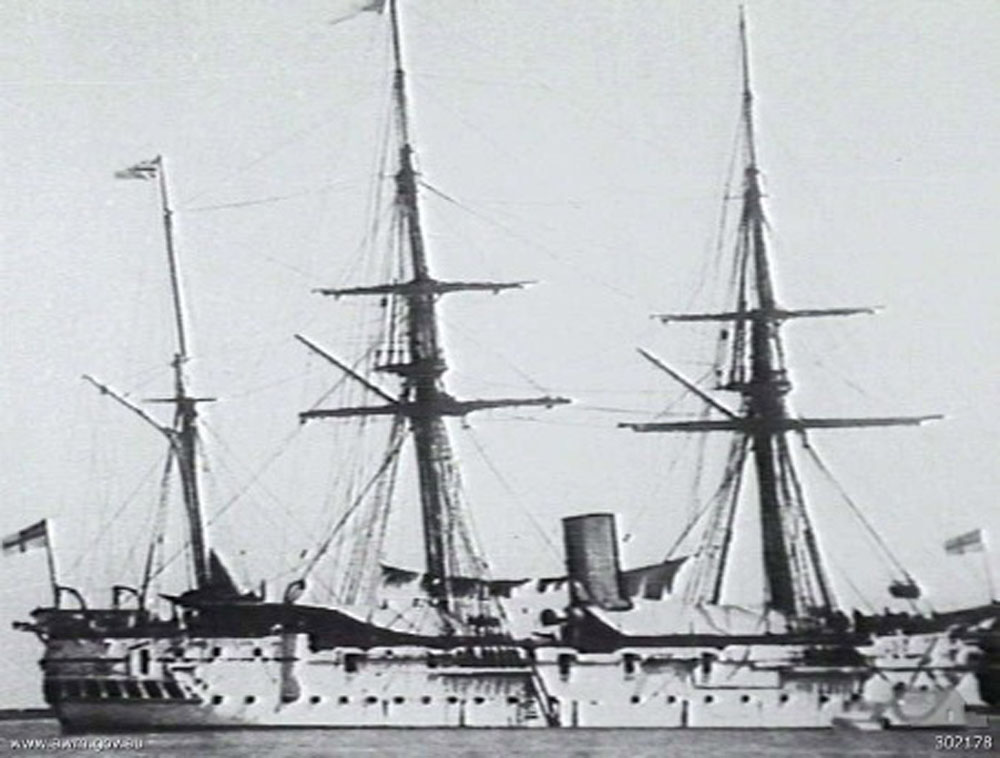
HMS Dido
Henry Cadell’s diary
Henry Cadell kept a regular diary and then wrote up entries in his annual journal. These records give a first-hand account of the organization and the work involved.
1888 Volunteering
In connection with the new War Dept. plans for the Defence of the Forth, a Corps of Submarine Miners was formed this year.
Frank Grant Ogilvie of Aberdeen, an old college companion now Principal of Heriot Watt College in Edinburgh undertook to organise & raise the Corps whose headquarters are at Leith.
The Corps is under the Royal Engineers and is on a different footing from ordinary volunteers as the men receive 5/- per day when at training (for a fortnight yearly,) and have to attain great proficiency in the special work they have to do.
The work consists in loading and laying a large series of submarine explosive mines fired from the shore by electricity and connected with the batteries by an elaborate system of single and multiple cables. The mines are laid across the fairway of the Firth so that ships cannot pass without striking them. In the event of war, friendly ships will be warned off or directed to sail through a secret friendly channel unknown to the enemy. Enemy ships may strike and in doing so ring an electric bell on shore. When the firing circuit may, if desired, be turned on which will cause the mine with its 25- 600 lbs of gun-cotton to explode with terrific violence and injure or totally disable or sink the intruder.
As the new corps was in want of officers, I joined in April as 2nd lieutenant and the course of instruction was begun on 10th April, when along with Ogilvie and Capt. H Beare, I received a lesson in making Knots.
The course of instruction was continued this summer and culminated in the Camp on Inchkeith which began on 21st July and lasted a fortnight.
1888 First Camp on Inchkeith
The first encampment of the Volunteer Engineers Forth Division Submarine Miners R.E. was inaugurated under very unfavourable conditions. The weather was wet and miserable nearly all the time and there being no shelter but canvas the life was anything but comfortable. Nevertheless the corps behaved very well and I for one enjoyed it well.
The party to which I was detailed was that devoted to indication of alignments. As there was not much special work to be done in this department I was detailed off to make a series of soundings for a proposed new harbour which was very much needed. In addition to this work which was satisfactorily carried out by the party of sappers under me, I had my share of ordinary camp routine work and company drill before breakfast at 8. And by the end of the time I managed to learn a great deal of military business.
The officers of the camp were:-
Major F Grant Ogilvie
Capts. T. H. Beare and Theodore Salvesen
Lieuts. H. M. Cadell and Jas. Currie jun.
Adjt Lieut J Organ Coast Battalion R.E.
As it is necessary for Officers to pass in Submarine Mining at Chatham, Major Ogilvie and I went there on 7th September and were examined in Part I of the course. We remained at Chatham a week and passed well in the following subjects included in Part I:
1. Knotting
2. Splicing
3. Crowning Cables
4. Jointing
5. Loading Mines
6. Bending Thimbles to wire ropes
7. Hydraulic testing of mines
8. Connecting up Electro Contact, Bury out and Ground Mines
9. Signalling with flags Part I
All these were done practically and there was no written paper. I passed well in everything except signalling. To read flag signals is very difficult and will require much more practice than I have as yet had.
We had quarters in rooms in Brompton but we messed with the Submarine Miners R.E. officers St Mary’s Barracks. These we found very pleasant fellows.
The early emphasis on Knotting might smack of “Boy Scouts” but was a very important skill, as mines had to be lashed securely when being transported.

Splicing, Crowning and Jointing are related to the electrical cables that connected each mine to the control station on shore. These cables were copper-cored, insulated with layers of India rubber, and protected by an outer sheath of steel wires.
To join two lengths of cable together, the copper cores were Jointed (initially they tried solder joints, but these were tricky in an open boat, so they used twisted joints, wrapped in insulating tape, and the armoured wires in the outer sheath were Spliced together.
When cables were attached to junction boxes, as shown on the left, or to the body of a mine, the wires of the outer sheath are folded back over a lashing of cord to create a “crown” which would be gripped securely when the sealing gland was tightened up.
Loading mines onto the mine-laying ship is self-explanatory.
Wire ropes were used to attach mines to their sinkers.
Eyes are formed in the end of a cable, by Bending the cable round a Thimble and securing it with a shackle or clamp.
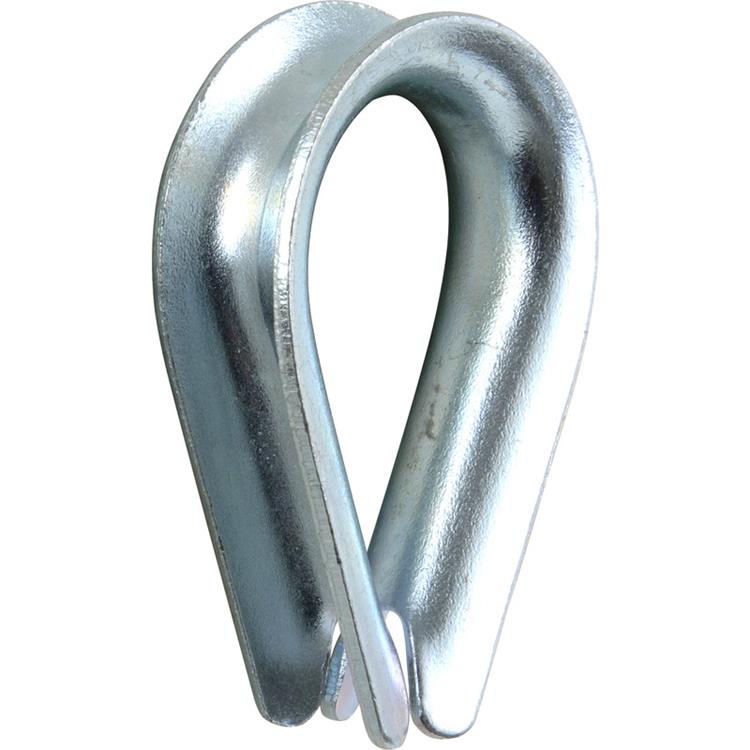
a thimble
Hydraulic testing ensured that the mines remained water-tight.
Connecting up Electro Contact, Bury out and Ground Mines referred to making and testing the electrical connections to the various types of mine.
Signaling with flags was necessary for communication between the shore station and the mine-laying ship, to relay messages relating to the position of each mine, and the results of electrical tests of the connection from each mine to the shore station.
There were lots of new skills for officers and men to learn and then to practise in subsequent training camps.
1889 Camp on Inchkeith
The 2nd annual Camp of the Forth Vol. Div. R.E. began on 20th July. This year we were favoured with better weather than last year although we had several rather windy days. The arrangements were much better and altogether we did more work and got better into the way of it than before. I passed my drill exam for my captaincy which I obtained and was promoted to the command of No. 1 Coy.
Major Ogilvie gave a silver cup to the corps to be won by the best drilled company. In the competition which was held on the 26th, Col. Malcolm awarded the cup to my company which behaved with more steadiness than the others. On the 3rd of August the Camp ended and we left the Island in pouring rain, having had a very enjoyable fortnight in which our skill in laying and raising submarine mines has been greatly increased.
1890 – Training at Chatham
As I was prevented last year from going to Chatham to pass Part II in Submarine Mining, I arranged to make it out this summer. After practising diligently signalling and laying out, I left for Chatham along with Lieut. Stephen on 5th April (Sat).
After having some practice on Tuesday and Wednesday were examined on Thursday and Friday morning. We passed all right in the following subjects:-
1. Slinging
2. Laying out Electro Contact, Ground and Buoyant Mines on Fork and Line System
3. Picking up
4. Rowing
5. Sculling
6. Signalling Part II
In Signalling with the Flag I had two shots at it and on second trial passed fairly well, making only 11 out of a max of 14 mistakes allowed in a message consisting of alphabets signalled within 5 minutes.
Having now passed Parts I & II, I am entitled to have “P.S” put before my name in the army list.
Part III is optional and is chiefly on the electrical department of submarine Mining. I mean however to go up for it too, later on if I can.
Slinging refers to carrying mines and their associated sinkers, wire ropes and electrical cables on the sides of the mine-laying ship, using manila rope slings.
As well as Laying-out the individual mines when a minefield is first deployed, any faulty mines (the electrical connections from the shore station to each mine were tested daily) had to be picked-up and replaced.
This involved skilful boat handling. Each minelaying ship was accompanied by several small boats, which were used to make the electrical connections and perform the final positioning of each mine. Hence the need for rowing and sculling skills.
Submarine Mining Inchkeith 1890
The Camp on Inchkeith lasted from Sat 19 July till 2nd August.
The weather was dry but very windy and for several days almost nothing could be done in the water. I was not very well satisfied with myself with all our work and we were very much inconvenienced by the want of a decent harbour.
The War Dept. has never done anything towards making a decent harbour and a vast amount of time is lost in landing at low tide and in stormy weather from our steamers in boats.
One advance has however been made in the erection of stone huts for the men. The Officers have still to live under canvas but we shall get more permanent quarters later on.
As the Corps was in want of a submarine mining song I managed with the favour of the muse to compose a ditty which was sung with great applause at the Corps gathering in Junction Street Hall Leith on 28th February, and was printed for the use of the Corps.
A copy is given on opposite page alongside of a simple sketch of the Camp, with diagram of the mines and picture of harbour and mens’ huts.
This was the first of two submarine mining songs that Cadell wrote for the Corps.
1890 – The First Company Song
The Hundred Sappers
CORPS SONG, FORTH VOL. DIV. R.E., 1890
Chorus.- Wi’ a hundred Sappers an’ a’, an’ a’,
Wi’ a hundred mines in a raw, a raw ;
We’ll up an’ gi’e them a blaw, a blaw,
Wi’ our hundred Sappers an’ a’, an’ a’.
1. We ha’e steamed awa’ fra’ the Port o’ Leith,
An’ crossed the sea to the wild Inchkeith,
To fear the foeman awa, awa,
For a week an’ a bittock or twa, or twa.
2. Had the foe been by they micht weel hae fled
At the sicht o’ our fleet as it onward sped,
Wi’ its haik clamjamfrie o’ junction box boats,
Gigs, cutters, and Sappers wi’ braw red coats.
3. Our Corps contains about ten score men;
We’re few in numbers, but then, but then,
Gude gear gangs aye intil bundles sma’
An’ we’re nae exception at a’, at a’.
4. We can kep the foeman wi’ bowline lines,
Mak fast clovehitches about their throats,
An’ stopper their shankies to sinkers deep,
Whaur they’ll ne’er rise up to disturb our sleep.
5. At wide open order, in fours deep, deep,
Our Submarine warlocks they soom asleep,
Wi’ yin ee open, aye ready to jump,
Gin enemies middle them, bump ! bump ! bump !
6. Wi’ a fearsome bang, and a fell guffaw,
Like a muckle Scott Monument smoored wi’ snaw,
Ilk warlock flees up, gies a blaw, a blaw,
And dichts them like stour a’ awa’ awa.
7. Then here’s to the Sappers, hurra ! hurra !
Wha’ll fear our foemen awa, awa,
Gin they fash the auld lion that sleeps in the North,
An’ poke their nibs intil the Firth o’ Forth
H. M. Cadell.
Sketch of the Camp on Inchkeith 1890
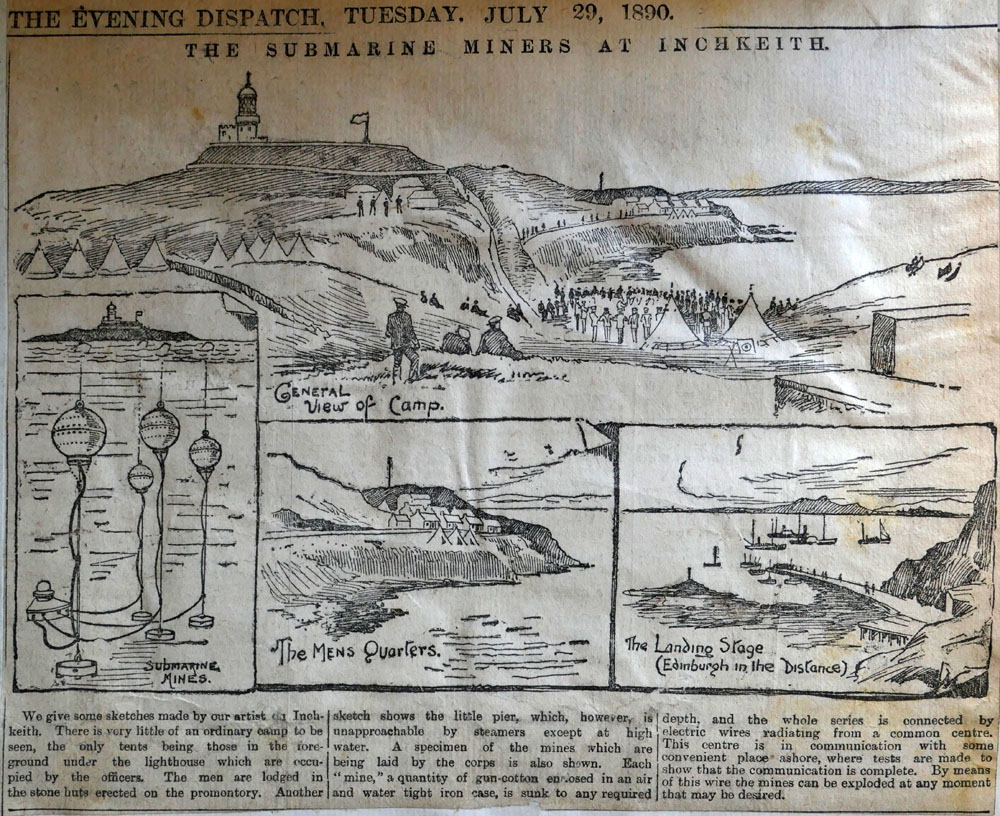
We give some sketches made by our artist on Inchkeith. There is very little of an ordinary camp to be seen, the only tents being those in the foreground under the lighthouse which are occupied by the officers. The men are lodged in the stone huts erected on the promontory. Another
sketch shows the pier, which, however is unapproachable by steamers except at high water. A specimen of the mines which are being laid by the corps is also shown. Each “mine,” a quantity of gun-cotton enclosed in an air and water tight iron case, is sunk to any required depth, and the whole series is connected by electric wires radiating from a common centre. This centre is in communication with some convenient place ashore, where tests are made to show that the communication is complete. By means of this wire the mines may be exploded at any moment that may be desired.
The work of the Submarine Miners was settling into a steady rhythm.
1892 Camp on Inchkeith
I went to the Camp on 16th held this year on Inchkeith again.
Nothing worthy of much note occurred.
The Corps went out for three weeks and I put in most of my time the first fortnight. This made it rather quiet as all the officers were present only for a short time.
The weather was fine however and we made fair progress with our work.
1893 Submarine Mining
We camped again amid good weather on Inchkeith.
The new harbour is now half-completed and is being built of concrete and rails brought back from the historical Suakin and Berber Railway.
The camp was a good one and so was the work.
We had however to dismiss 2 company sergt. majors for an attempt at a mutiny, they having ineffectually incited the Sappers to refuse to do some extra work one evening before the inspection.
In the annual 12-oared cutter race on 1st July, the Forth men won by a long distance over the Clyde and Tay boats.
[Note: The Suakin-Berber railway in Sudan was a short-lived military project that never reached completion. Its construction began in February 1885, being intended to provide a connection between Berber on the River Nile and Suakin on the Red Sea littoral for the rapid deployment of troops and military equipment in Britain’s involvement in the Mahdist war.
In May 1885, after barely three of months of work during which only 20 of the intended 280 miles of track had been laid, at a cost approaching £1 million, Britain suspended its war with the Mahdi, pulled out of the Sudan and terminated the Suakin-Berber railway.
The escalating difficulties and costs of building the railway served to provide ammunition to Gladstone’s opponents in Parliament and in so doing helped in bringing down his second administration.]
There are no diary entries for 1894 to 1896, but 1897 brought an unexpected scare.
1897 Camp on Inchkeith
The usual camp of the Submarine Miners was held at Inchkeith and while there I made a detailed geological map of the island on the scale of 25 inches to the mile for the War Dept. and received the thanks of the CRE for this work.
On the 4th August a tremendous thunderstorm came on.
I was in my tent for refuge from the downpour and Lieut. C Murray whose tent was only 10 yards off, had just left it for shelter in the officers’ mess hut on the shore, when suddenly there was a terrific flash and crash, which I was certain had done some damage.
When the storm passed shortly after we found that Murray’s tent had been struck. The lightning had blown a small hole in the top, run down the pole, shattered to slivers a small looking glass hanging on it, then burnt a large hole in his military cape and run down a sword also hanging on the pole. The plating on the point of the scabbard was melted and the current had passed from thence to the bed and burnt a round hole in the clothes and mattress finally passing to earth down the legs burning small holes in the matting on which they rested. I was profoundly thankful to God that my tent had been spared when the destroyer was so near me.
In 1898, the camp moved from Inchkeith to temporary quarters at South Queensferry, served by the harbour at Port Edgar. This highlighted the deficiencies of Inchkeith as a Submarine Mining base.
Submarine Mining 1898
Camp at [South] Queensferry
Owing to Inchkeith being occupied by workmen fitting up the new batteries for the big guns to be mounted at Inchkeith, the Submarine Miners camped at Butlaw near Port Edgar and we practised laying mines on the north side opposite Inverkeithing. Although not so romantic the camp was more convenient and we had a good time altogether this year and personally for the first time I felt some confidence in the utility of submarine mining as a branch of our defences. I felt that we could now trust ourselves to get a minefield laid out ready for the enemy within a reasonable time. At Inchkeith the War Dept. have not yet provided a decent harbour and much needless time is lost and worry is caused by this, which is entirely saved by the good harbour at Port Edgar.
Photographs from the 1898 Camp at South Queensferry.
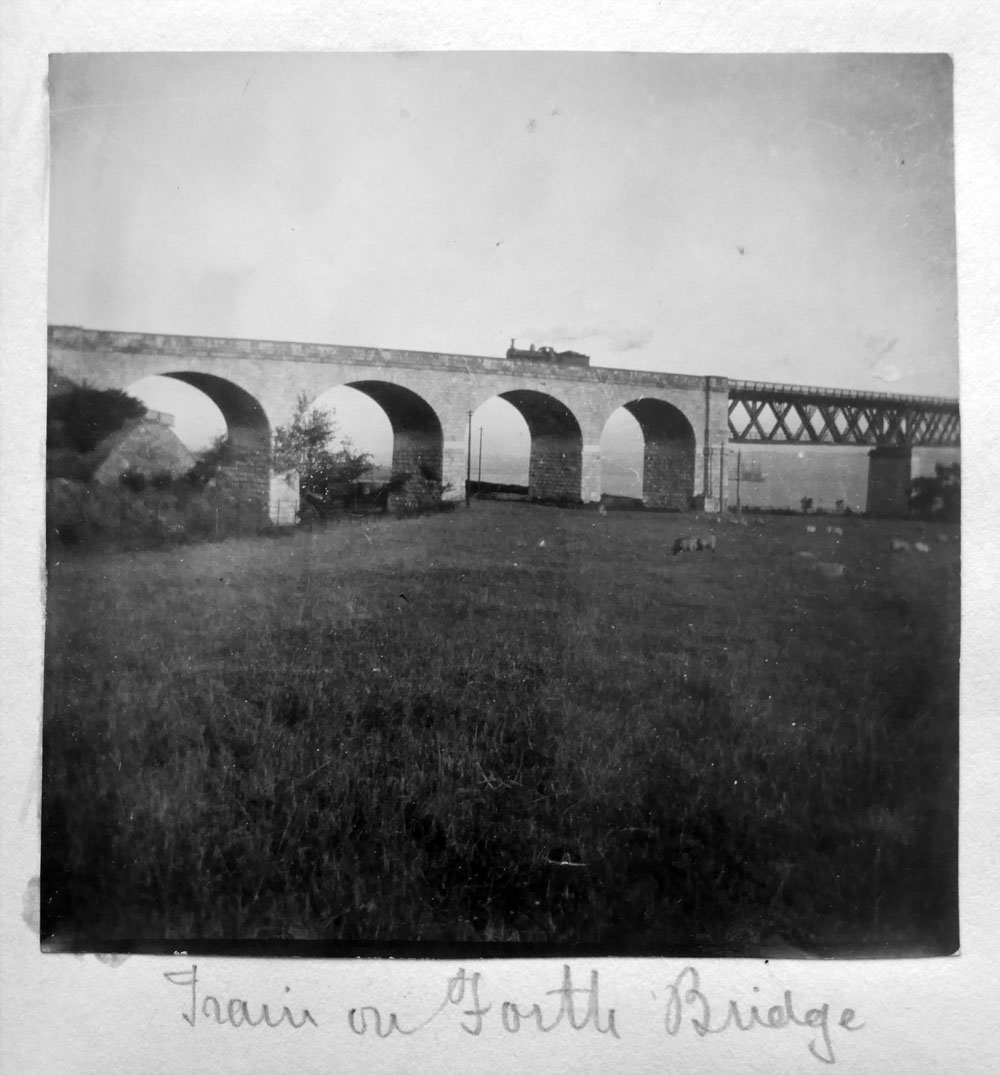
Train on Forth Bridge
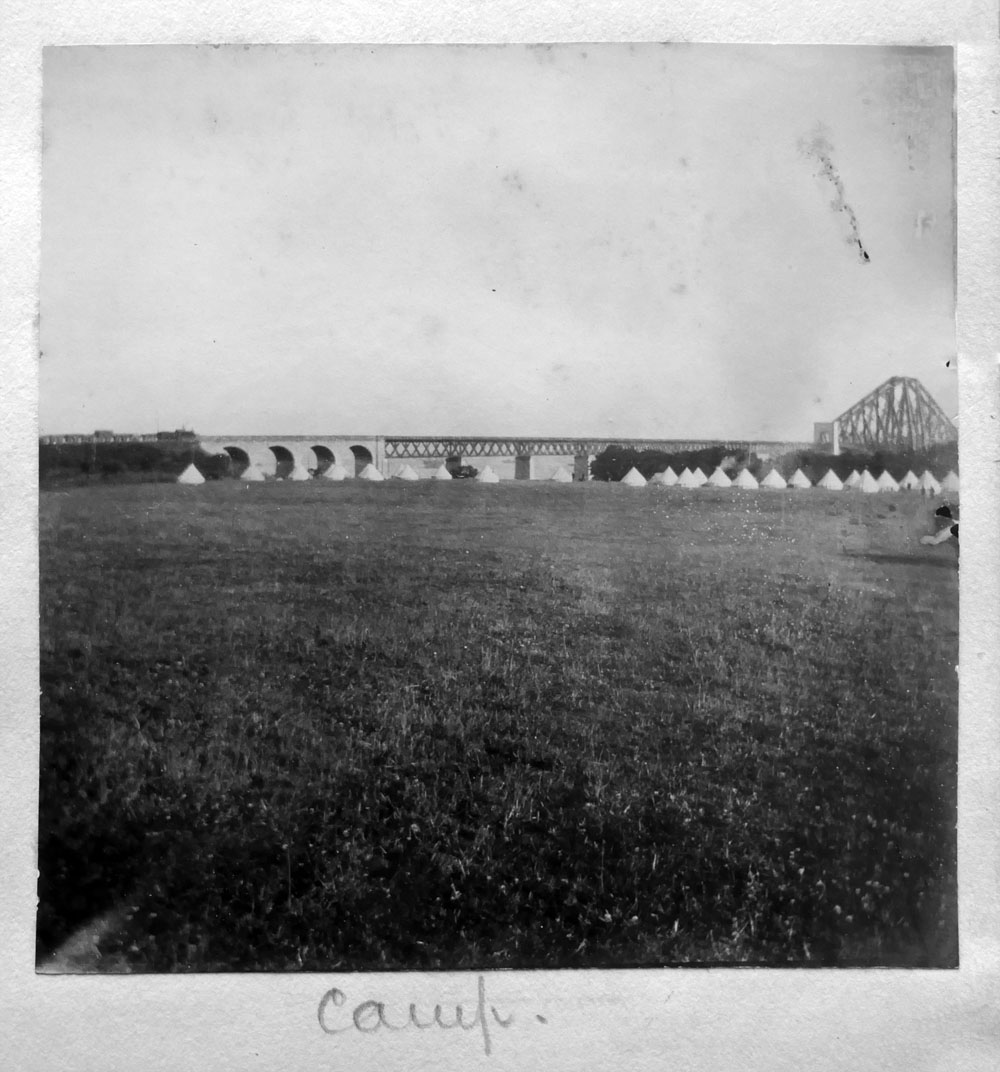
Camp
Camp South Queensferry 1898
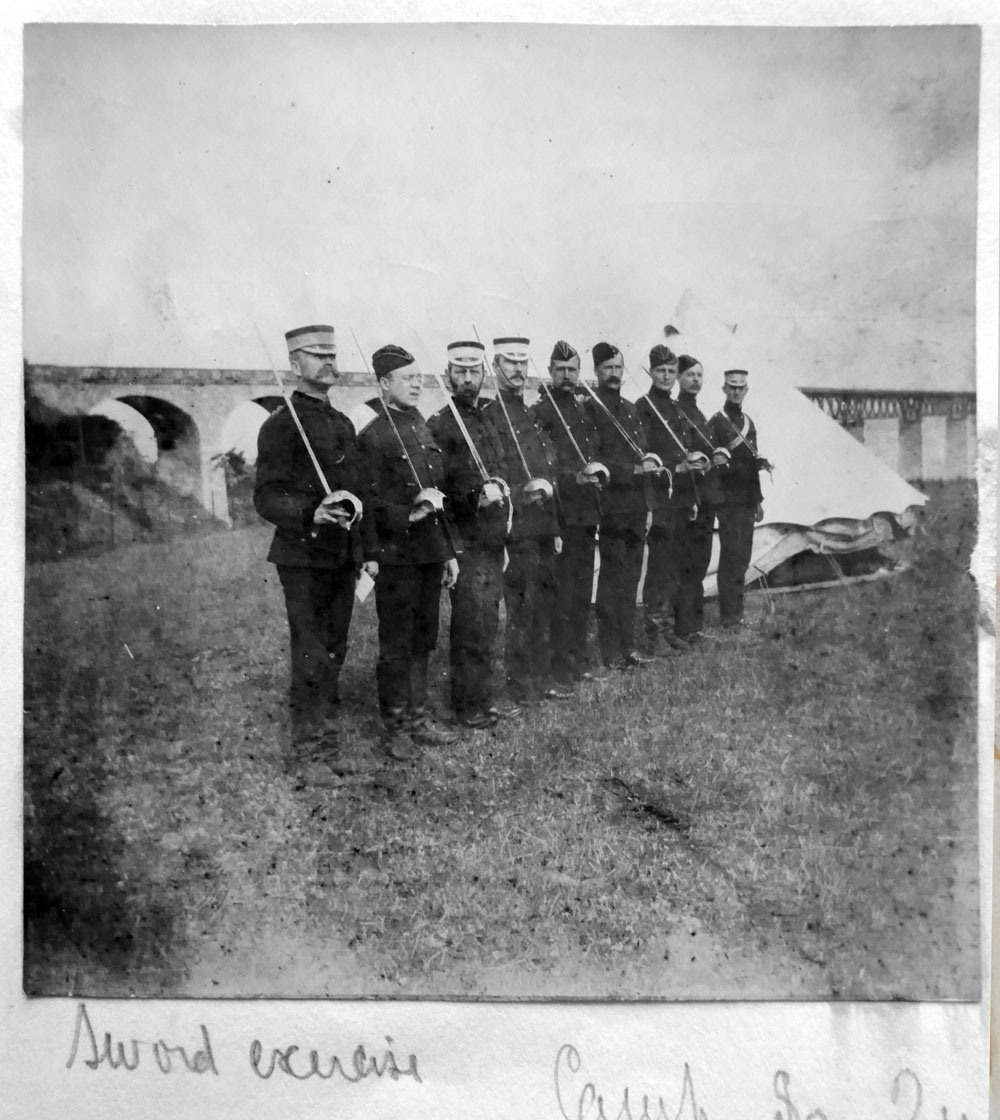
Sword Exercise
Camp South Queensferry 1898
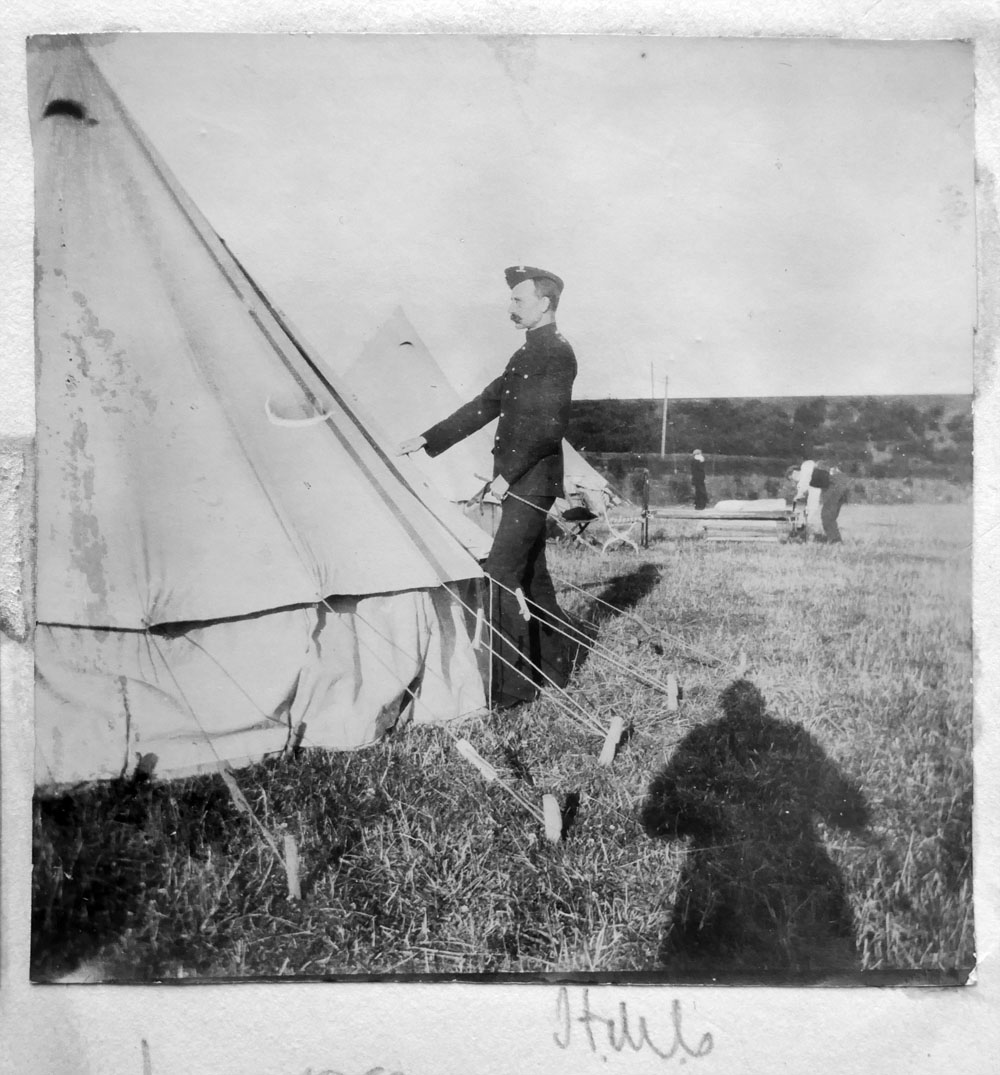
H.M.C. [H. M. Cadell]
Camp South Queensferry 1898
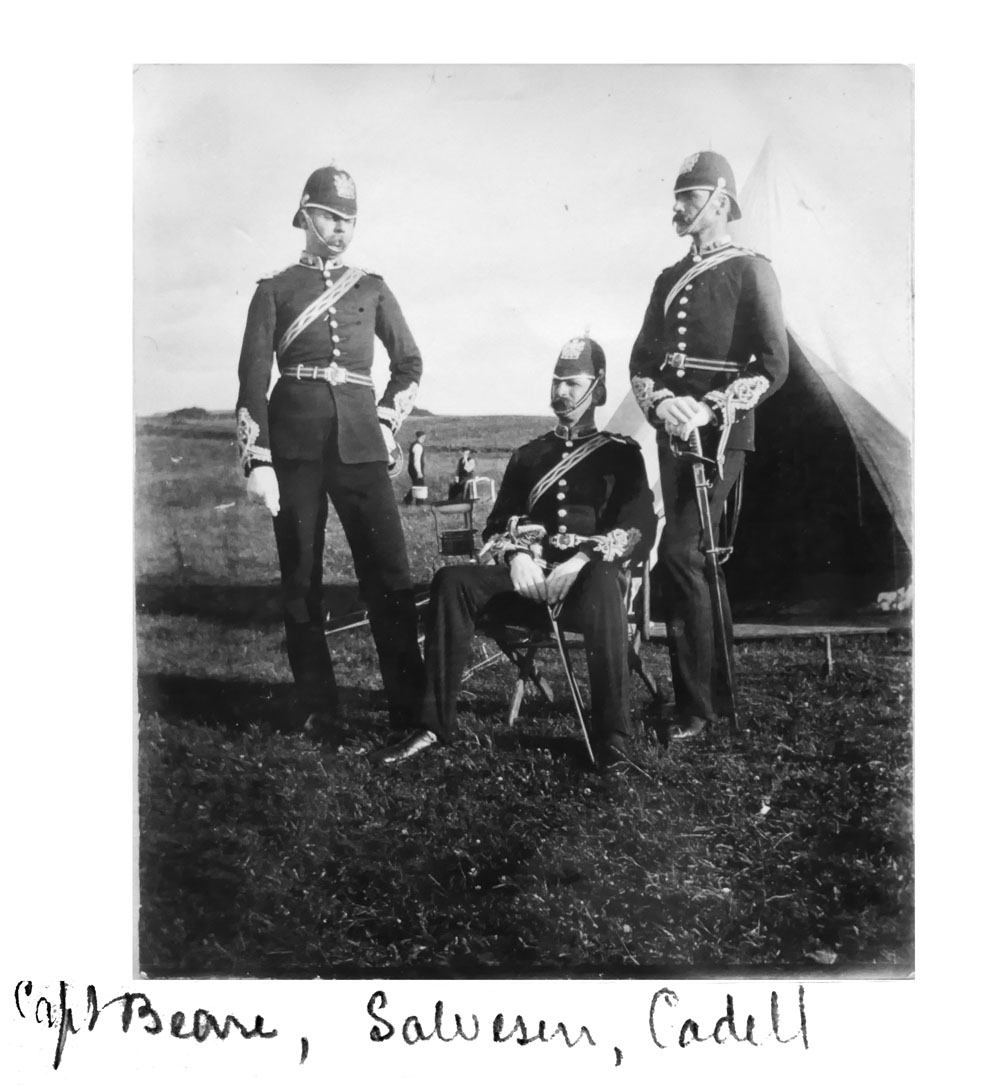
Capt Beare, Salvesen, Cadell
Camp South Queensferry 1898
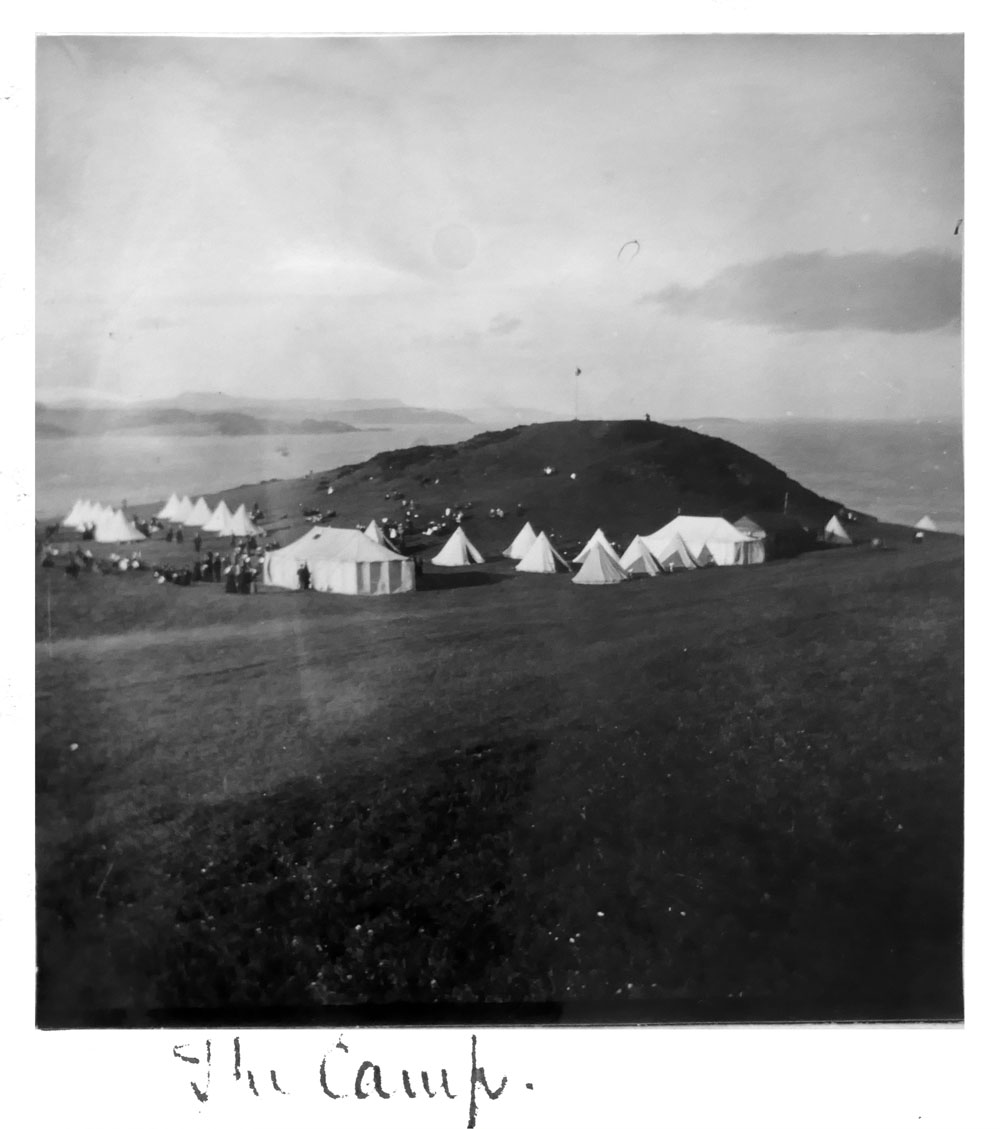
The Camp
Camp South Queensferry 1898
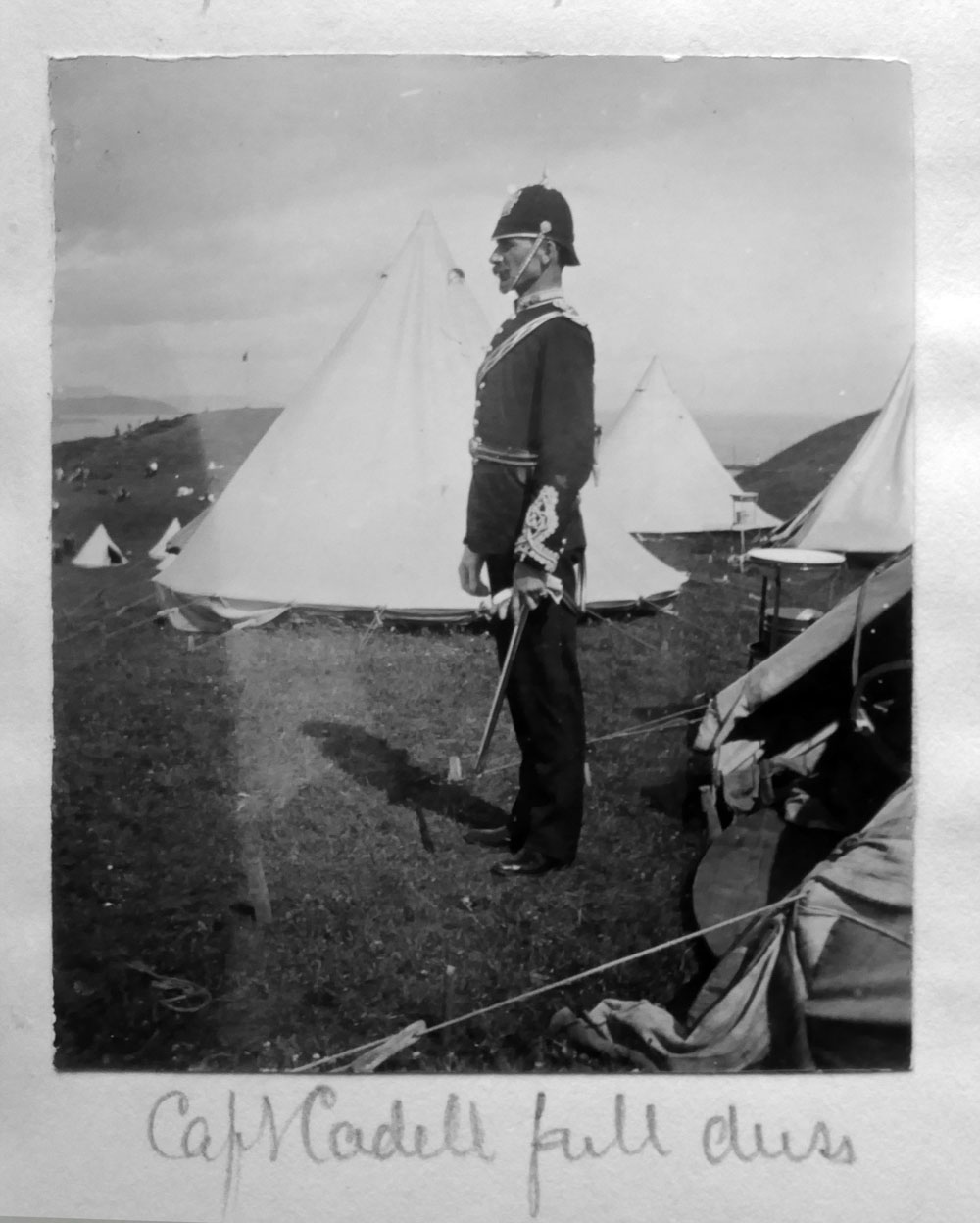
Capt Cadell full dress
Camp South Queensferry 1898

Capt Salvesen
Camp South Queensferry 1898
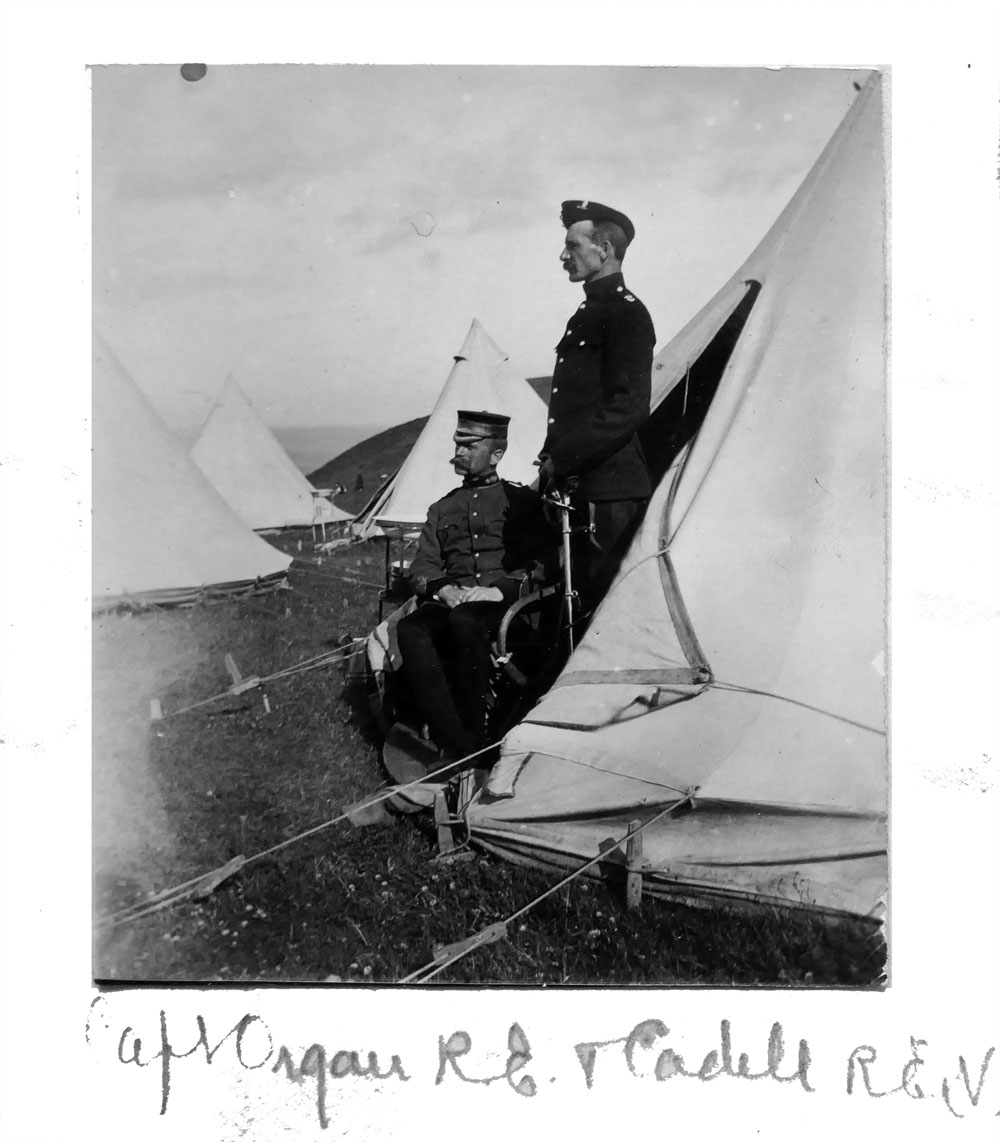
Capts Organ RE & Cadell R.E.V.
Camp South Queensferry 1898
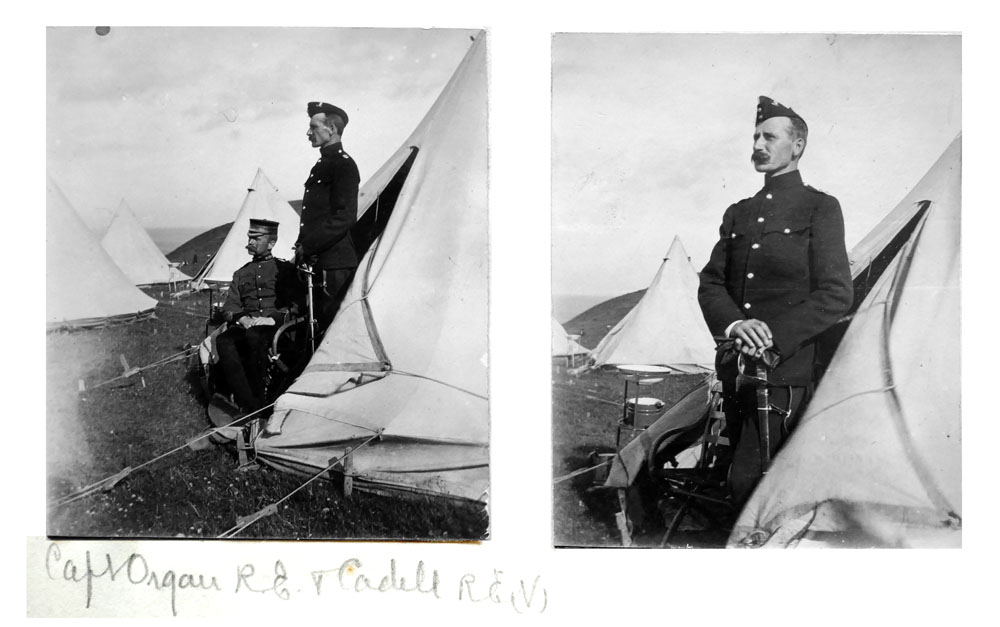
Capts Organ RE & Cadell R.E.V.
Camp South Queensferry 1898
1898 – The Second Company Song
In 1898, Captain Cadell published a second Company Song.
You can sing along to a Karaoke version on YouTube HERE.

HAIL TO THE THIEF
1
Hail to the thief o’er the sea who advances
To steal a march on us if ever he can;
If his home in big Russia or Turkey or France is,
Spain, Portugal, Germany, Greece, or Japan,
Fair breezes attend him,
Across the streak send him,
Astride the white horses that leap o’er the brine
To every such jumper
We’ll empty our bumper,
And bump his old rump on a submarine mine.
2
Hail Caledonia! thou land of strong liquors,
The dew of the mountains that kiss the grey sky;
Land full of cogies and barrels and bickers,
With spirits inside them that potently lie;
But we’ve a fierce licker
Bunged up in a bicker,
To broach our wild admiral all who’s design,
Get a lick for their trouble
That crumples them double –
A bump on the rump with a submarine mine.
3
There are mines that are sound, and far more that are rotten,
Supposed to be brimming with silver and gold;
But the mines that can sound and are crammed with gun-cotton
Are solid investments for Britain to hold.
Let a thief come to burgle,
They’ll soon make him gurgle,
And spread him in splinters far over the brine;
Dispose of him variously,
Very precariously,
Bump his old rump on a submarine mine.
4
Hail to the thief as he soars in the atmosphere!
Vast his velocity! Oh, what a lark!
Thought he was safe, when he got such a smack severe,
Safe as a sailor in old Noah’s ark.
The bits, let him pick them up,
Fishes will gaily sup,
Garvies and herring will handsomely dine
On all that remains still hot
Of the bold thief who got
A bump on the rump with a submarine mine.
5
Like pines in forest close clustered together,
With roots in the shingle and stems in the brine,
That sway like this saplings and bend to the weather,
With garlands of tangle around them to twine;
Flowers of the ocean bed,
Painted both green and red,
Signals of safety or danger malign.
Ye foes full of enmity
think with solemnity
Of a bump on the rump with a submarine mine.
6
Row, sappers, row, for the pride of old Scotland!
‘Gainst robbers and pirates put forth all your strength;
Whate’er they may do, there’s one thing – they must not land,
Or steal a march on us a single foot’s length.
Plant the mines thickly then,
Lay them out quickly then;
Join the long cables of copper-cored twine.
Let the foe see our coast, and then
Drink his last toast and then
Bump his old rump on a submarine mine.
H. M. CADELL,
Capt. Forth Div R.E.(V.) Sub. Miners.
cogie – a small bowl
bicker – A vessel for containing liquor for drinking, properly one made of wood
The front cover shows a mine exploding in the Forth, and a mine laying boat – presumably the Dundas.
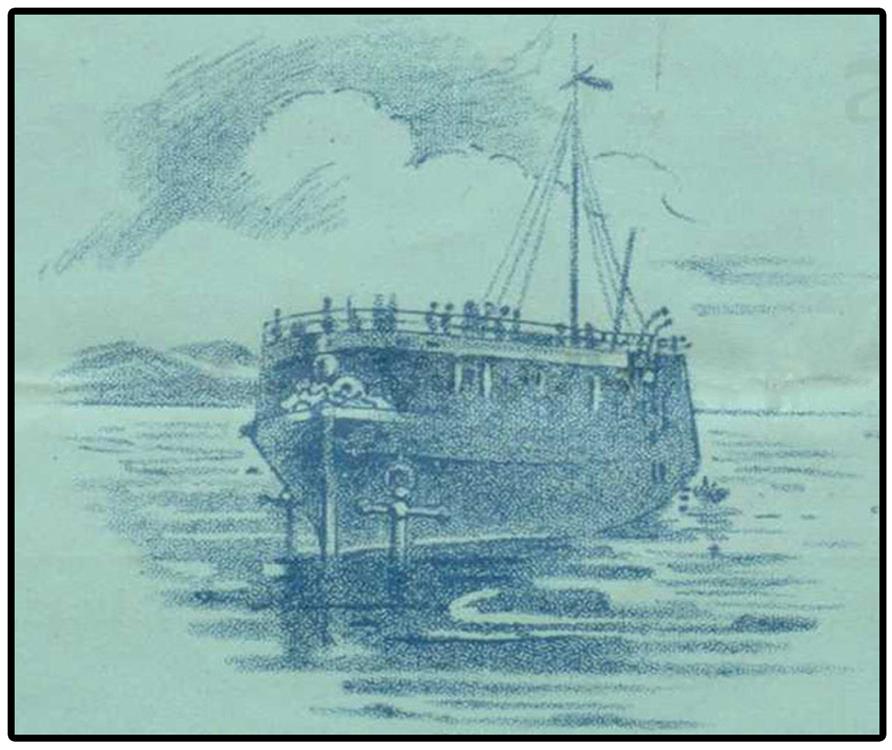
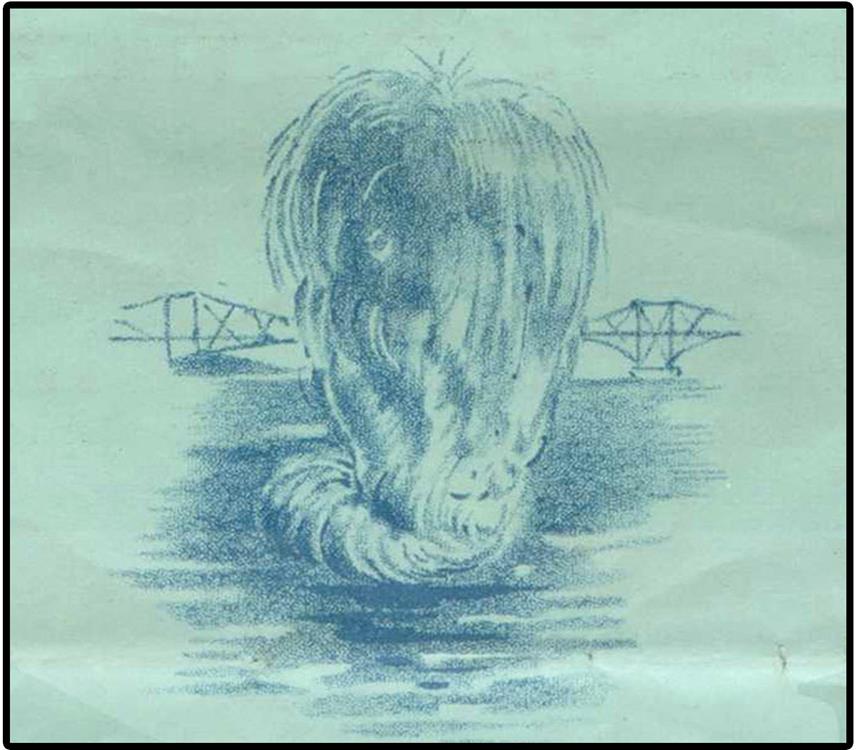
The last verse of the song explains the duties of the sappers – plant the mines thickly, lay them out quickly, join the long cables of copper-cored twine.
1900 – The move to North Queensferry
The traditional British Naval bases were spread along the south coast of England from Plymouth to the Medway. They provided excellent access to the English Channel and the Atlantic coats of Europe, the historic source of sea-borne threats.
At the end of the 19th century, a new potential threat was growing from Germany’s High Seas Fleet, based in Wilhemshaven across the North Sea.
The Admiralty decided to match this threat with new naval bases along the East Coast. Scapa Flow in Orkney, Invergordon and Rosyth on mainland Scotland, and Immingham and Harwich in England.
Scapa Flow was earmarked for battle ships and Rosyth for battle cruisers.
The submarine mining operation in the Forth now had a higher priority. It would soon be defending a naval base.
The decision was taken to move the base to a new home in North Queensferry, and to build new gun batteries at Carlingnose and Dalmeny.
This move may also have been prompted by the increased efficiency when the camp was at South Queensferry, and had access to a decent harbour to land mines and equipment.
In 1900, the Submarine Miners held their annual camp at North Queensferry (they may have also been there in 1899.)
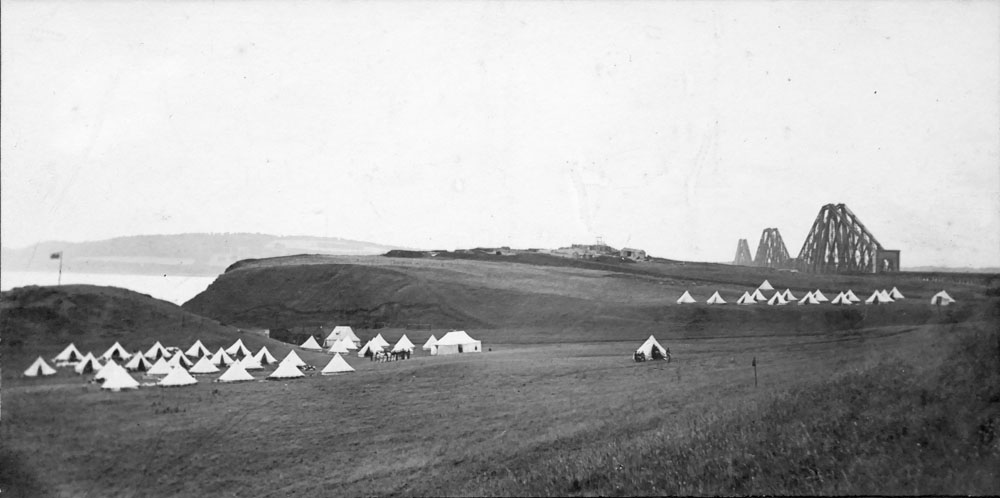
Forth Division R.E. Submarine Miners Camp North Queensferry 1900

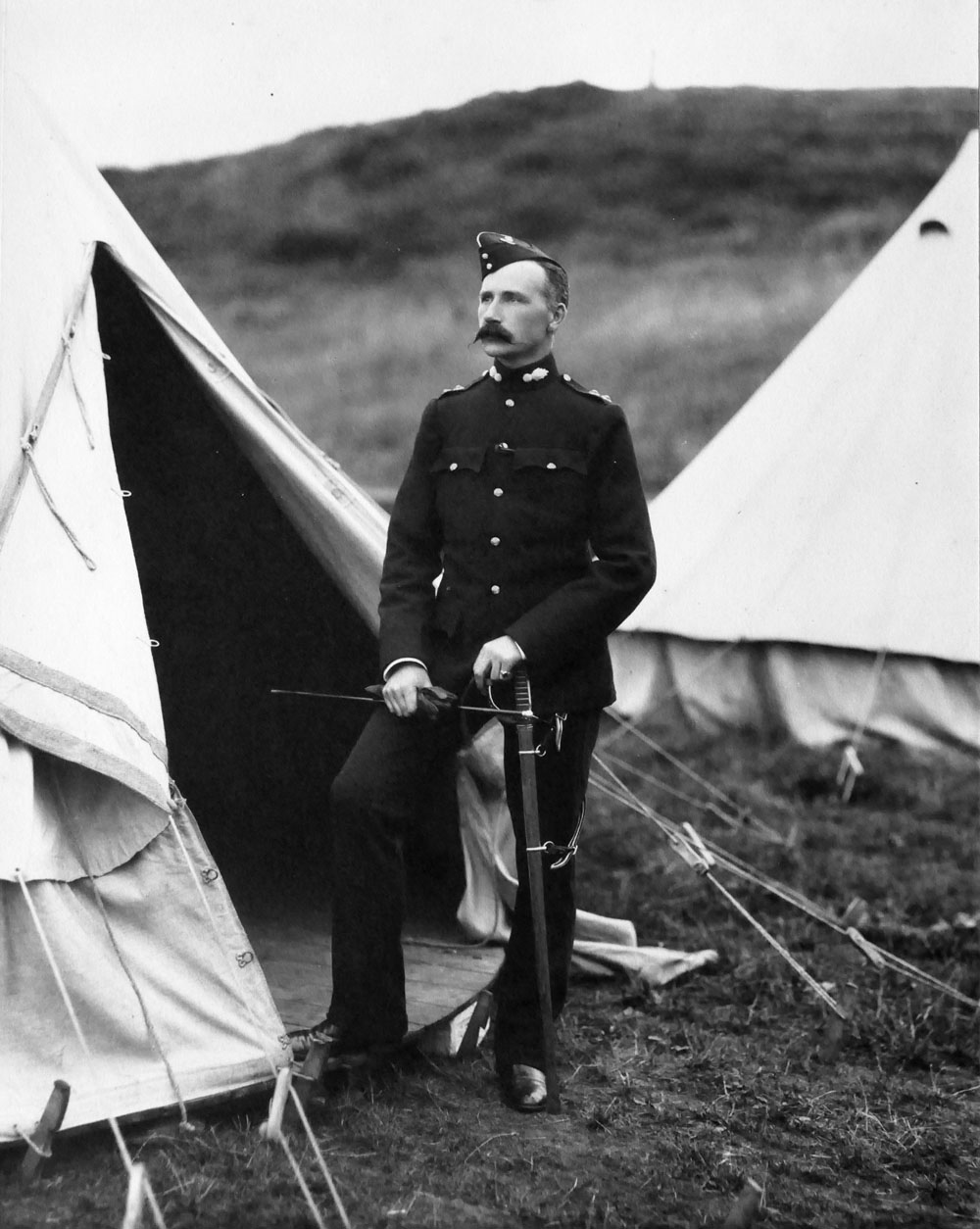

While here, Henry Cadell conducted test drillings at Port Laing, to establish the suitability of the site for a new permanent Submarine Mining Station.
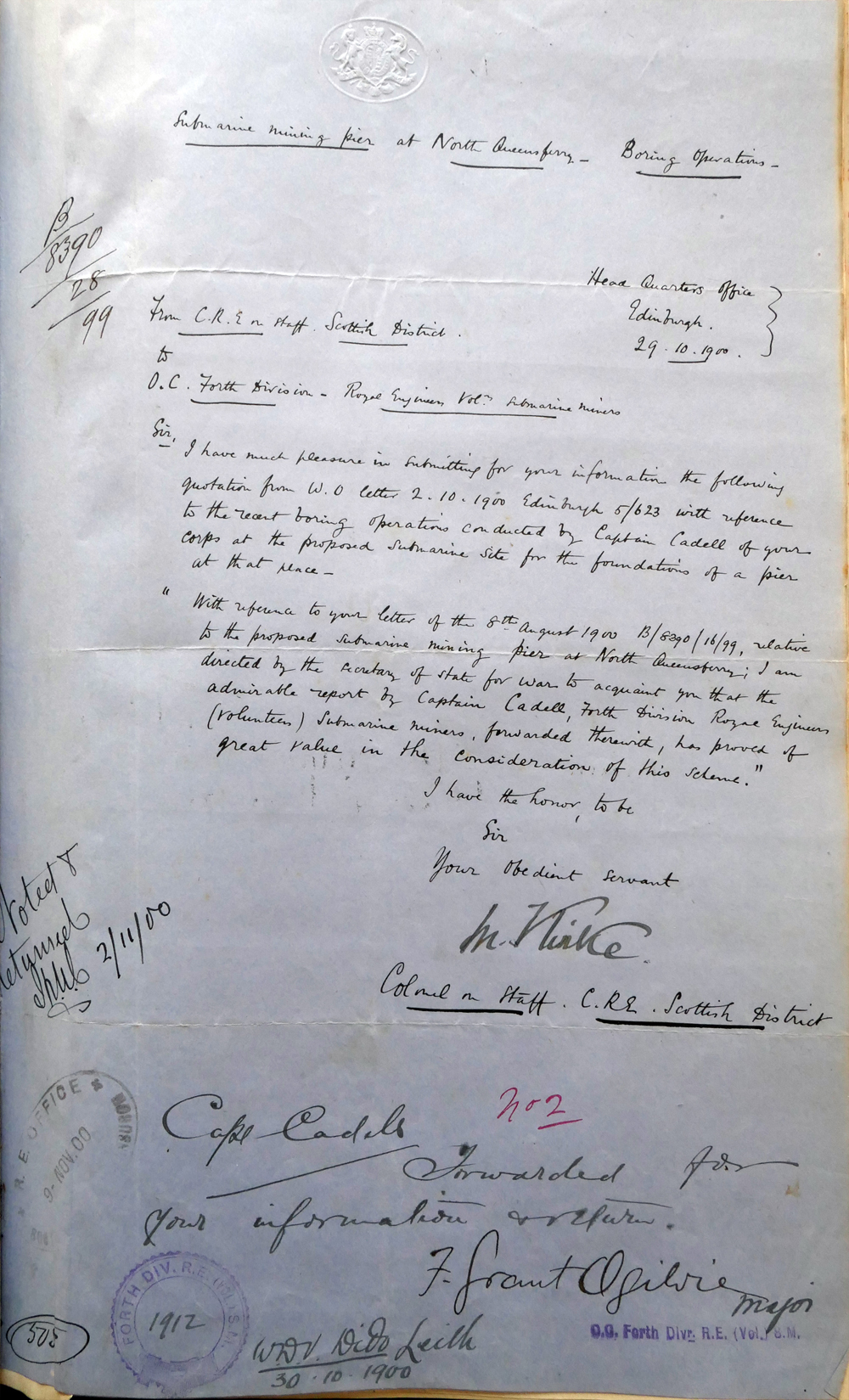
Submarine Mining at North Queensferry – Boring Operations
Head Quarter Office
Edinburgh
29 10 1900
From CRE on staff Scottish District
to
O.C. Forth Division Royal Engineers Vol. Submarine Miners
Sir,
I have much pleasure in submitting for your information the following
quotation from W.O. letter 2. 10. 1900 Edinburgh 5/623 with reference
to the recent boring operations conducted by Captain Cadell of your
corps at the proposed submarine site for the foundation of a pier
at that place.
“With reference to your letter of the 8th August 1900 B/8390/16/99,
relative to the proposed Submarine Mining Pier at North Queensferry,
I am directed by the Secretary of State for War to acquaint you that the
admirable report by Captain Cadell Forth Division Royal Engineers
(Volunteer) Submarine Miners, forwarded therewith, has proved of
great value in the consideration of the scheme.”I have the honour to be,
Sir
Your Obedient Servant
M Kirke
Colonel in Chief CRE Scottish District
Capt Cadell
Forwarded for your information and reflection
F Grant Ogilvie – Major
Forth defences from Port Laing to Dalmeny
The result of Cadells’ survey was the construction of the “Guv’y Pier” with narrow gauge railway linking the pierhead to the new submarine mining station on the shore at Port Laing.

Above Port Laing, Royal Engineers constructed Carlingnose Barracks and Carlingnose Battery – fitted out with two 6 inch guns, which could swivel through 360 degrees, to protect the site from any land-borne intrusion, as well as covering the Firth of Forth. New electric searchlights were installed at the existing Coast Guard Battery
Gun batteries and searchlight stations were built on Inchgarvie and at Dalmeny, with a further battery at Hound Point.
These guns and lights could all focus on any enemy ships attempting to sail through the friendly channel, where they could also be attacked by observation mines.
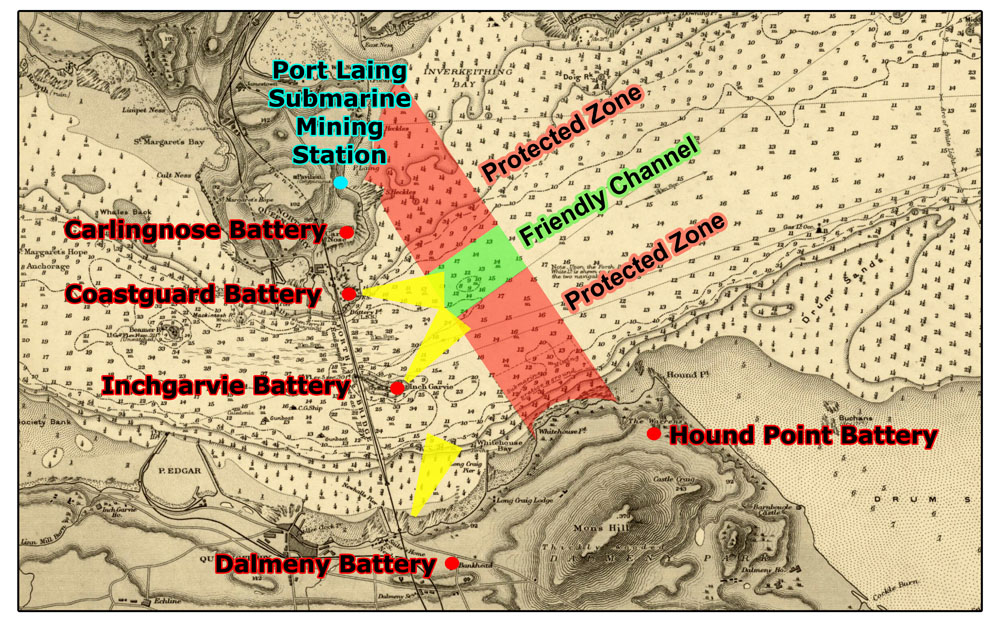
This diagram is our estimate of the likely layout of the minefield
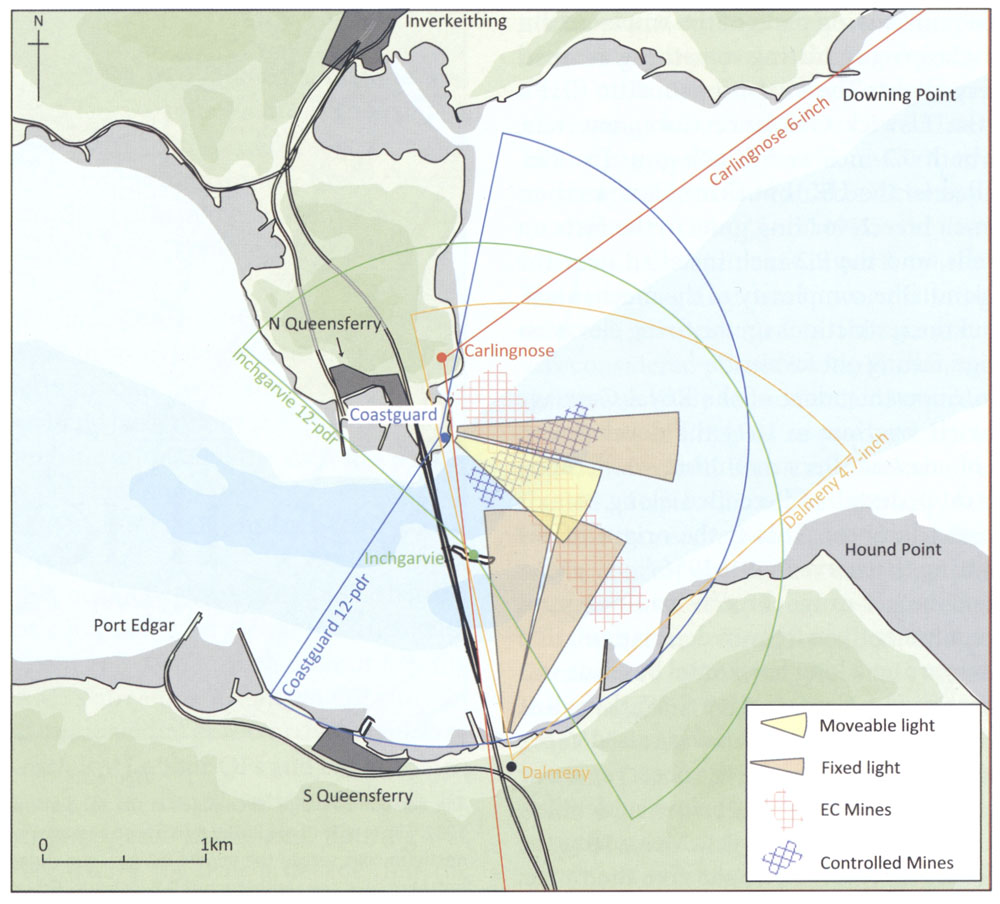
This second diagram is from “The Fortification of the Firth of Forth 1880 – 1977” by Gordon Barclay and Ron Morris- p31. It is redrawn from WO 75/5179.
We were rather pleased with the accuracy of our estimate!
1903 Rosyth Naval Base
Government this year bought from Lord Linlithgow his estate of Rosyth @ £80 an acre including Rosyth old Castle and a long piece of foreshore for a new Naval Base on the Firth of Forth. This promises to be a place of great importance by and by, but it will be several years before much use can be made of the place.
The beginning of the end
Having installed the gun batteries, searchlights, barracks and a permanent submarine mining Station all to beef up the defences of the Forth and protect the new Royal Navy Dockyard at Rosyth it seemed like the Submarine Miners had a rosy future with new improved facilities, but there were clouds on the horizon.
19th century naval arms race
When the Submarine Mining service was first established in the 1860s the state of the art in naval warfare was the Ironclad as represented here by HMS Warrior.
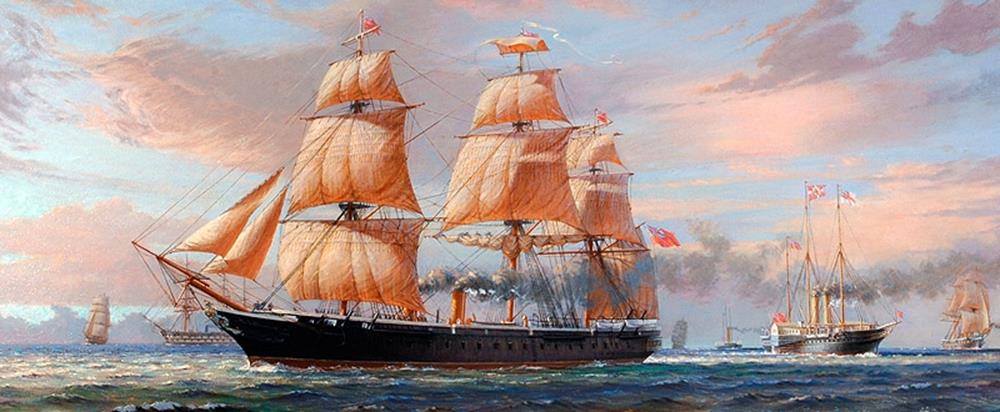
HMS Warrior – 1860
She was an evolution of the sailing ships which fought at Trafalgar in 1805, developed in response to similar innovations in the French Navy, adding steam power to sail, and an iron-cladding over her wooden hull. Armament was still side-facing gun-ports, she would engage the enemy at close quarters and exchange broadsides.
Pre-dreadnoughts
By the 1890s sail had given way to steam, and a new class of battleship was introduced.
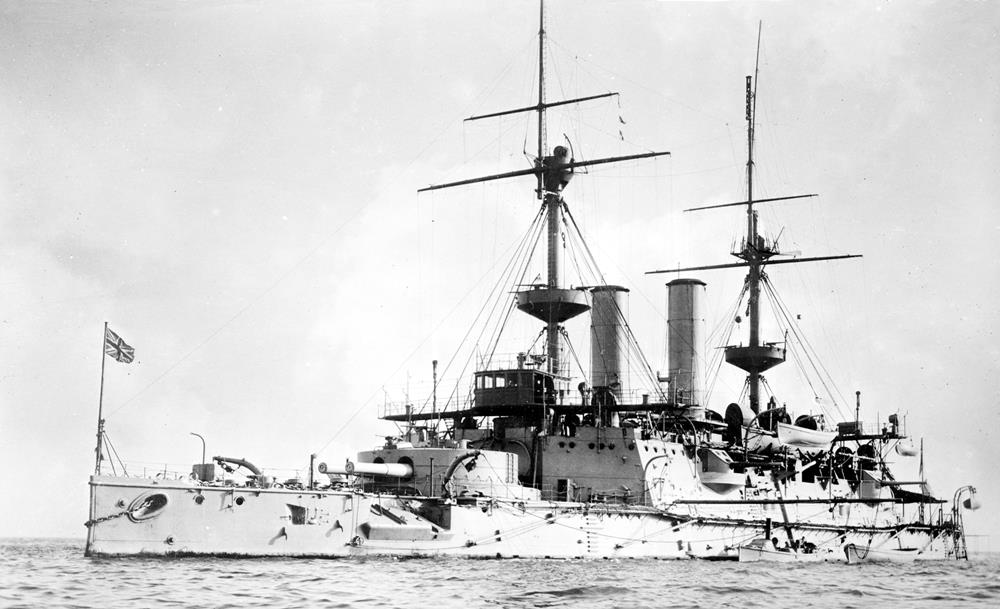
HMS Hood of 1891
Built from steel, and protected by hardened steel armour, pre-dreadnought battleships carried a main battery of very heavy guns in barbettes supported by one or more secondary batteries of lighter weapons. The heavy guns could penetrate the armour plating of enemy ships at a range of up to 5,000 yards. The ships were powered by coal-fuelled triple-expansion steam engines.
In contrast to the chaotic development of ironclad warships in preceding decades, the 1890s saw navies worldwide start to build battleships to a common design as dozens of ships essentially followed the design of the British Majestic class. The similarity in appearance of battleships in the 1890s was underlined by the increasing number of ships being built. New naval powers such as Germany, Japan, the United States, and to a lesser extent Italy and Austria-Hungary, began to establish themselves with fleets of pre-dreadnoughts, while the navies of Britain, France, and Russia expanded to meet these new threats.
The Dreadnoughts
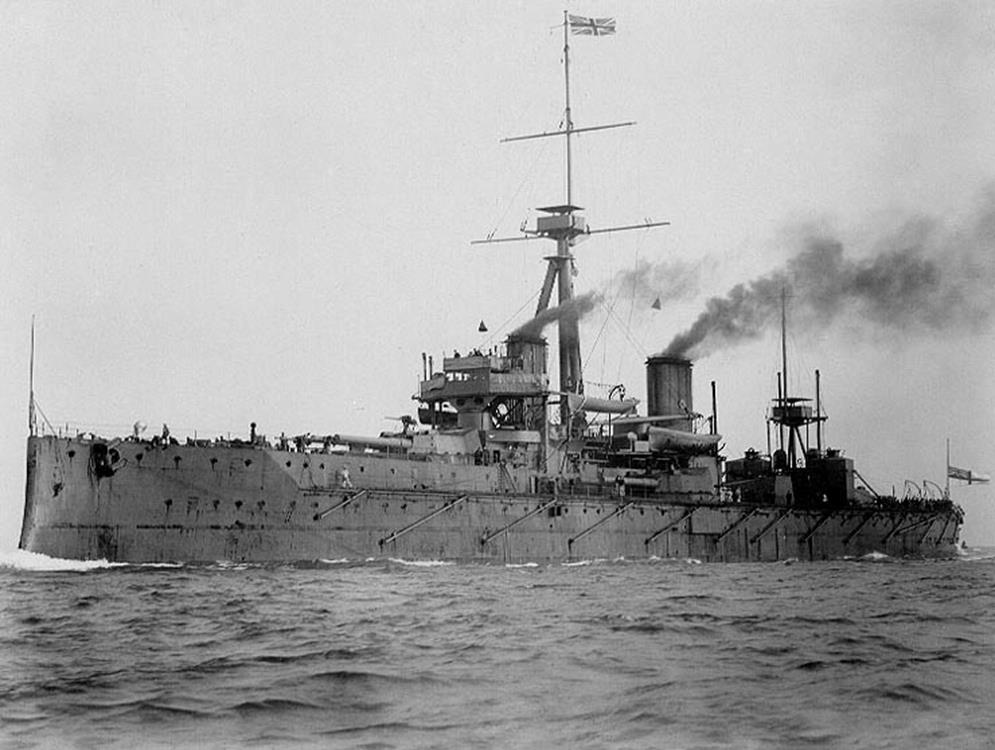
HMS Dreadnought was a battleship built for the Royal Navy that revolutionised naval power. Dreadnought’s entry into service in 1906 represented such an advance in naval technology that its name came to be associated with an entire generation of battleships, the “dreadnoughts”, as well as the class of ships named after it.
The dreadnoughts made all previous generations of ships obsolete. Admiral Sir John “Jacky” Fisher, First Sea Lord of the Board of Admiralty, is credited as the father of Dreadnought. Shortly after he assumed office in 1904, he ordered design studies for a battleship armed solely with 12-inch (305 mm) guns and a speed of 21 knots (39 km/h; 24 mph).
Dreadnought was the first battleship of her era to have a uniform main battery, rather than having a few large guns complemented by a heavy secondary armament of smaller guns. She was also the first capital ship to be powered by steam turbines, making her the fastest battleship in the world at the time of her completion. Her launch helped spark a naval arms race as navies around the world, particularly the German Imperial Navy, rushed to match it in the build-up to World War I.
Her guns had a range of 16,000 yards, so she could sit off-shore and bombard targets far from the dangers of a minefield.
Submarines
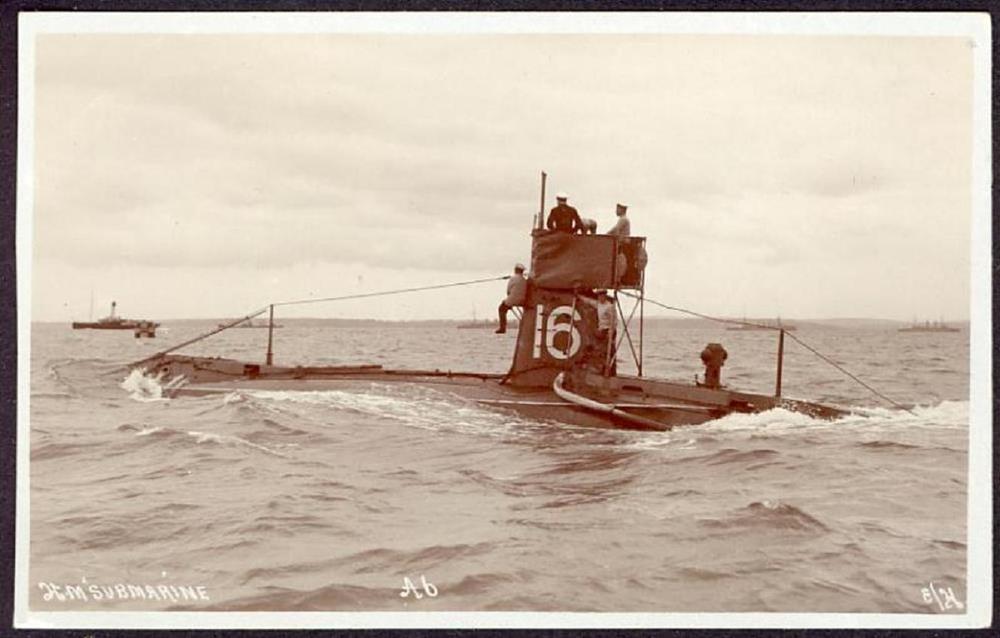
The final blow to the submarine mining service came from the submarine! Submarines were first used successfully during the American Civil War in the 1860s.
Armed with the Whitehead torpedo they could sail unobserved through the friendly channel of a minefield, attack shipping in a port and sail out again.
The Royal Navy was initially reluctant to adopt submarines, but in 1902 the first British submarine was launched, an American Holland class design. A series of new designs followed in the years up to WWI.
A submarine could creep unseen up an estuary, observe friendly ships passing through the safe channel and then slip through this unseen, to potentially wreak devastation then slip back out again.
The whole concept of submarine mining depended on being able to see enemy ships.
The last camp at North Queensferry was held in 1905
1905 The last Camp at North Queensferry
This was practically my last year as a Volunteer. I succeeded to the command of the Corps after Lt Col Salvesen retired in end of 1904. In beginning of 1905 intimation was sent us that submarine mining by land forces was to be abolished and all stores handed over to the Navy. It was not stated what was to become of the personnel of the various corps and pending instructions from the War Office as to our final destination we held our annual training at North Queensferry, and practised various useful subjects including running the electric searchlights outside the Forth Bridge, shelter trench work and signalling. I was complimented on the condition of the corps by the Inspecting Officer Col. Hippisley CB RE and the following notice appeared in the newspaper
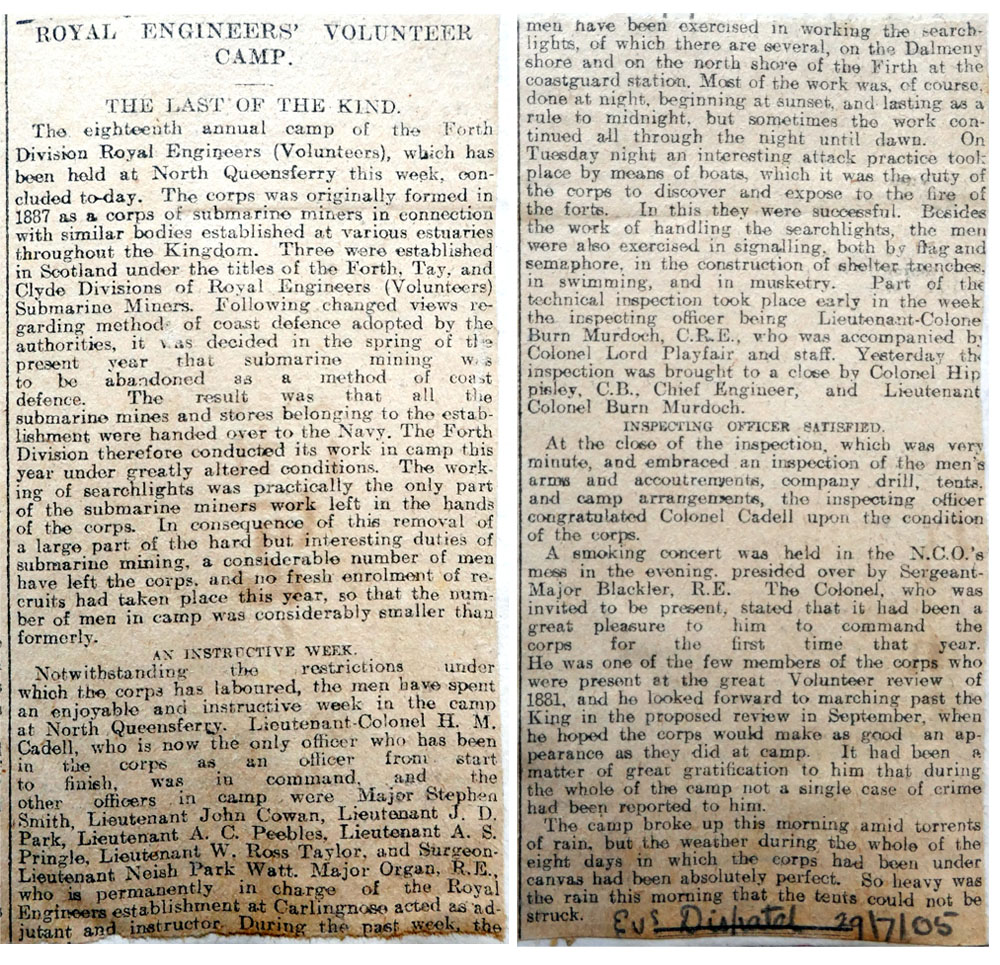
ROYAL ENGINEERS’ VOLUNTEER CAMP
THE LAST OF THE KIND
The eighteenth annual camp of the Forth Royal Engineers (Volunteers), which has been held at North Queensferry this week, concluded today. The corps was originally formed in 1887 as a corps of submarine miners in connection with similar bodies established at various estuaries throughout the Kingdom. Three were established in Scotland under the titles of Forth, Tay and Clyde Divisions of Royal Engineers (Volunteers) Submarine Miners. Following changed views regarding methods of coast defence adopted by the authorities, it was decided in the spring of the present year that submarine mining was to be abandoned as a method of coast defence. The result was that all the submarine mines and stores belonging to the establishment were to be handed over to the Navy. The Forth Division therefore conducted its work in camp this year under greatly altered conditions. The working of searchlights was practically the only part of the submarine miners work left in the hands of the corps. In consequence of this removal of the hard but interesting duties of submarine mining, a considerable number of men have left the corps, and no fresh enrolment of recruits had taken place this year, so that the numbers of men in camp was considerably smaller than formerly.
AN INSTRUCTIVE WEEK
Notwithstanding the restrictions under which the corps has laboured, the men have spent an enjoyable time and instructive week in North Queensferry. Lieutenant Colonel H. M. Cadell, who is now the only officer who has been in the corps from start to finish was in command and the other officers in camp were Major Stephen Smith, Lieutenant John Cowan, Lieutenant A. C. Peebles, Lieutenant A. S. Pringle, Lieutenant W. Ross Taylor, and Surgeon-Lieutenant Neish Park Watt. Major Organ, R.E. who is permanently in charge of the Royal Engineers establishment at Carlingnose acted as adjutant and instructor. During the past week, the men have been exercised in working the searchlights of which there are several on the Dalmeny shore and on the north shore of the Firth at the coastguard station. Most of the work was, of course done at night beginning at sunset and lasting as a rule till midnight, but sometimes the work continued all through the night until dawn. On Tuesday night an interesting attack practice took place by means of boats, which it was the duty of the corps to discover and expose to the fire of the forts. In this they were successful. Besides the work of handling the searchlights, the men were also exercised in signalling, both by flag and semaphore, in the construction of shelter trenches, in swimming and in musketry. Part of the technical inspection took place early in the week, the inspecting officer being Lieutenant-Colonel Burn Murdoch C.R.E., who was accompanied by Colonel Lord Playfair and staff. Yesterday the inspection was brought to a close by Colonel Hippisley, C.B., Chief Engineer, and Lieutenant Colonel Burn Murdoch.
INSPECTING OFFICER SATISFIED
At the close of the inspection, which was very minute, and embraced an inspection of the men’s arms and accoutrements, company drill, tents and camo arrangements, the inspecting officer congratulated Colonel Cadell upon the condition of the corps.
A smoking concert was held in the N.C.O.’s mess in the evening, presided over by Sergeant-Major Blackner, R.E. The Colonel, who was invited to be present, stated that it had been a great pleasure to him to command the corps for the first time that year. He was one of the few members of the corps who were present at the great Volunteer review of 1881, and he looked forward to marching past the King in the proposed review in September, when he hoped the corps would make as good an appearance as they did in camp. It had been a matter of great satisfaction that during the whole of the camp not a single case of crime had been reported to him.
The camp broke up this morning amid torrents of rain, but the weather during the whole of the eight days in which the corps had been under canvas had absolutely perfect. So heavy was the rain this morning that the tents could not be struck
Evening Dispatch – 29th July 1905
The end of the Submarine Mining Service
In 1906, the submarine mining service was disbanded.
Mines were handed over to the Navy. Diving was abolished as an Army service and the diving gear transferred to the Navy. The Admiralty took over submarine mining barracks.
The various submarine mining corps were converted to Electrical Engineers, and managed the searchlight facilities.
1906 A New Life for the Forth Volunteers
The Forth Volunteer Division (Submarine Miners) became the Forth Division (Electrical Engineers) (Volunteers), in 1906. In 1907 the Haldane Reforms led to a major reorganization of the British Army, with all volunteer units being combined into the Territorial Force (TF). The Forth Division was retitled as the City of Edinburgh (Fortress) Royal Engineers.
By World War I, the unit’s organisation was as follows:
City of Edinburgh (Fortress) Royal Engineers
• HQ at 28 York Place, Edinburgh
• No 1 Works Company
• No 2 Electric Lights Company
The Territorial Force was demobilised at the end of WWI, then reinstated in 1926, as the Territorial Army.
Other work performed by the Submarine Mining Service.
As well as managing minefields, and their associated electric lights, the Submarine Mining Division of the Royal Engineers also engaged in three other activities.
Clearing wrecks
A fairly obvious use of their expertise in underwater explosives was to clear any wrecks which were a danger or nuisance to shipping and could not be raised. Wrecks were cleared in the Thames, Spithead, Calcutta, Karachi and Rangoon.
Diving
Demolition work required divers to place the charges, and divers were also used at some minefields as an alternative to raising mines and junction boxes for inspection.
In the early 1880s there was a great demand for divers for various civil works in progress, including the Tay and Forth Bridges; the attractions of higher pay proved too much for the Royal Engineer divers. It was therefore found necessary to withhold the diving course completion certificate until the men had completed their time of service.
The Brennan Torpedo
The third activity was to sponsor the development of the wire-guided Brennan Torpedo. As explained earlier, torpedoes were initial explosive charges on long spars projecting from the bow of a torpedo boat. The torpedo was rammed against enemy ships. A later development was the self-propelled torpedo which could be launched from a ship, or later a submarine.
During the 19th century, an anonymous officer of the Austrian Marine Artillery conceived the idea of using a small boat laden with explosives, propelled by a steam or an air engine and steered by cables to be used against enemy ships. On his death, his papers came into the possession of Captain Giovanni Luppis, who commissioned a model of the device. It was powered by a spring-driven clockwork mechanism and steered remotely by cables from land. Dissatisfied with the device, which he called the “coast-saver”, in about 1850, Luppis asked Robert Whitehead to develop this design into a self-propelled underwater torpedo.
Whitehead was born in Bolton, England, and trained as an engineer and draughtsman, at the Mechanics Institute in Manchester. His was employed at shipyards in Toulon, Milan and Trieste, before moving to Fiume in present-day Croatia. There he became the manager of a company making marine steam boilers and engines, with the Austrian Navy as one of their customers.
Whitehead developed a torpedo propelled by compressed air and carrying an explosive warhead, with a speed of 7 knots (13 km/h) and the ability to hit a target up to 700 yards (640 m) away. By 1870 Whitehead’s torpedoes were running at 17 knots (31.5 km/h). In 1896, Whitehead bought the rights to a patented gyroscope gear which kept the torpedo on track regardless of wind or wave action.
In 1890 Whitehead opened a UK manufacturing and test site in Portland Harbour, Dorset. When Whitehead retired, the Whitehead family sold the company to two large British armaments companies, Vickers and Armstrong-Whitworth. Thus the company remained under British control until the First World War.
In 1877, Louis Brennan, an Irish-born Australian inventor resurrected the idea of a torpedo which was steerable from the launch station. The Brennan torpedo was propelled by two contra-rotating propellers that were spun by rapidly pulling out wires from drums wound inside the torpedo. Each drum carried several thousand yards of high-tensile steel wire. The wires were pulled by a steam-powered winch on the launch station, and the torpedo could be steered by varying the winding speed on each wire.
The torpedo attained a speed 27 knots (31 mph), could hit a target at a range of 200 yards, and could be turned 180 degrees to hit a target from the off side.
By 1879, Brennan had established the Brennan Torpedo Company assigning half of the rights from his patent to his partner John Ridley Temperley, in exchange for much-needed funds. Brennan and Temperley travelled to Britain, where the Admiralty examined the torpedo and found it unsuitable for shipboard use. However, the Royal Engineers could see its potential for shore defences.
In 1884 Brennan received a letter from the War Office stating that they had decided to adopt his torpedo for harbour defence. The Brennan torpedo became a standard harbour defence throughout the British Empire and was in use for more than fifteen years.
In 1891 a report to the Director of Artillery stated: We have now completed or in progress 7 installations viz. Thames, Medway, Portsmouth, Plymouth, Cork, Malta (2 sites). Further sites are proposed as funds become available at Plymouth, Milford Haven, Clyde, Forth, Falmouth, Hong Kong, Singapore and St Lucia.
The first seven and the one at Hong Kong were completed, but in 1905 the Committee on Armaments of Home Ports issued a report in which they recommended the removal of all Brennan torpedoes from fixed defences due to their comparatively short range and the difficulty of launching them at night.
Manufacture of the Brennan torpedo finished in 1906.
Mines deployed in anger
In all the years of the service from 1863 to 1906, the ability to deploy defensive minefields was a powerful deterrent.
Only once, in 1885, was the threat of war (with Russia) sufficient to trigger the readiness of mine defences.
In Singapore, the mines were loaded with gun-cotton, primed and made ready for immediate deployment.
In the Australian ports, the mine defences were actually laid out. This was the only recorded instance of this being done in any British port.
Mines deployed by the Royal Navy during WWI
Although the submarine mining service was disbanded in 1906, that was not the end of submarine mining. The Navy took over the activity again in 1914, and deployed controlled minefields in both WWI and WWII.
During World War I, the Navy deployed electrically-controlled defensive minefields at Scapa Flow, the Tay and in the Forth.
Controlled Mining in WWI
From “The Fortification of the Firth of Forth 1880 – 1977” by Gordon Barclay and Ron Morris- p57
“When, towards the end of 1914, it was realised that shipping was at severe risk from attack by submarines or raiders, the Admiralty proposed to revive the former system of controlled minefields, but this time under naval control. A new unit was raised within the Royal Marines, based on a cadre of retired former Royal Engineer Submarine Miners. The Royal Marine Submarine Miners came into existence on February 1915, with HQ in Newcastle-upon-Tyne.”
The introduction of hydrophones – 1915
One of the reasons for the withdrawal of the submarine mining service in 1906 was the growing threat of submarines, which could slip undetected through the “friendly channel” in a controlled minefield. Various experiments were carried out to detect submerge submarines, including the use of aircraft.
Experiments were conducted from Carlingnose Royal Naval Air Station in 1913 which proved that a submerged submarine could be detected from an aeroplane by the wake which it created on the surface.
Further downstream at Aberdour, an anti-submarine experimental station was created at H.M.S. Tarlair. It focussed on detecting submarines using hydrophones – underwater microphones to detect the sound of a passing submarine. Hydrophone stations were established on Oxcars, Inchcolm and at Elieness in early 1915. However they were withdrawn later that year as they gave too many false alarms.
Experiments continued, technology advance, and by 1916, hydrophone stations were deployed on Inchkeith and Fidra and at Elieness, Crail and Seacliff.
Detector Loops
Another experiment conducted in 1915 at H.M.S. Tarlair detected submarines when their magnetized steel hulls passed over a submerged loop of cable. This proved to be very successful, but a report from HMS Tarlair was mis-understood, and it was not until 1917 that detector loops were deployed in anger.
The combination of a detector loop and a controlled minefield led to the sinking of a German Submarine off Scapa Flow in 1918.
Scapa Flow
From “Shield of Empire – The Royal Navy and Scotland” by Brian Lavery – pp212
“The first minefield in the base [Scapa Flow] was laid off Croo Taing, off South Ronaldsay, at the end of 1914, and it was intended to help close Water Sound to the east in conjunction with the sunken ships to seaward. It was made up of five rows comprising 166 electro-contact or EC mines. These could be detonated by a ship striking a mine, but could be made safe by electrical means from a watch-hut on shore.
The Cantick Field was laid the following month, across the passage between Hoy and the island of Switha. It had four rows, each of 18 EC mines.
Both these fields proved to be very difficult to maintain, because of strong tides. The electrical cables to the mines were constantly chafed as they went slack in falling tides, while on one occasion more than half of the Croo Taing field was accidentally detonated by strong currents.
A third EC minefield was laid at Roan Head in September 1916, at the northern end of the main entrance to the harbour.
The Houston Head field was laid out in the middle of 1915, across the eastern entrance to the Flow. It too was electrically controlled, but on a different principle. A hydrophone was used to detect submarines by the noise of their propellers and engines. An observer on shore would then press a button to detonate a group of the mines.
It had nine lines arranged in two rows. Each line had six mines and could be detonated separately.
A third row was laid across Houton in February 1916.
The second Observation minefield of this type was laid in December 1915, across Hoxa Sound, the main entrance for the battleships and cruisers. It was the most complex of the fields with three sections entitled X, Y and Z|, each with three rows which could be fired separately. Each row consisted of eight or nine lines of six mines, making a total of 156. It was the only one to see any action during the war. At midnight on 12-13 April 1917 the hydrophone station at Stanger Head reported a submarine, which was also heard at 2.30 am from Hoxa. At 9.20 next morning it was reported that the intruder was passing through the barrier and six mines of Y2 line were detonated; but no wreckage was ever found and no submarine was lost by the Germans.
At 10.21 in the evening of 28 October 1918 the Stanger Head hydrophones had another contact. Hydrophones suffered from the difficulty of being non-directional, so that the operator could not tell exactly where the submarine was; but in this case six operators in different stations worked as a team, comparing the intensity of sound that they heard. At 11.32 line X1 was fired and afterwards the wreck of UB-116 was found. This was the only concrete success by any British [electrically-] controlled minefield during the war, though there is no doubt that they acted as a deterrent to the enemy and gave reassurance to the ships anchored behind them.”
[Lavery cites his source as “Lockhart Leith, compiler, History of British Minefields 1914-1918, London c. 1920 ]
The Tay
From “Shield of Empire – The Royal Navy and Scotland” by Brian Lavery – pp250
“a controlled field of eighteen mines, which could be made live by an operator on shore, was laid across the relatively narrow entrance to the Tay at Broughty Ferry. It was done in too much of a hurry and they had to be raised in March 1915, and twenty-four larger mines were laid in their place in five lines.”
Firth of Forth
From “The Fortification of the Firth of Forth 1880 – 1977” by Gordon Barclay and Ron Morris- p54
Three, or possible four, controlled minefields were established in the Forth controlled from Inchcolm and Inchmickery.

From “Shield of Empire – The Royal Navy and Scotland” by Brian Lavery – pp267
Clearing the minefields
“The observation fields were no problem, for they could be detonated by pushing a button, and the lines of mines at Houton Head, Hoxa, Mortimer Deep and Inchmickery were detonated for experimental purposes during February 1919, though two mines at Inchmickery failed to explode.”
The minefields at Inchmickery and Mortimer Deep were probably associated with the hydrophone station at Hawkcraig, Aberdour.
[Lavery cites his source for all three articles as “Lockhart Leith, compiler, History of British Minefields 1914-1918, London c. 1920 ]
The evolution of the Forth Defences
The Forth defences evolved into a multi-layered set of anti-submarine defences, with anti-submarine nets strung across the river at several locations, and gun batteries further downstream.
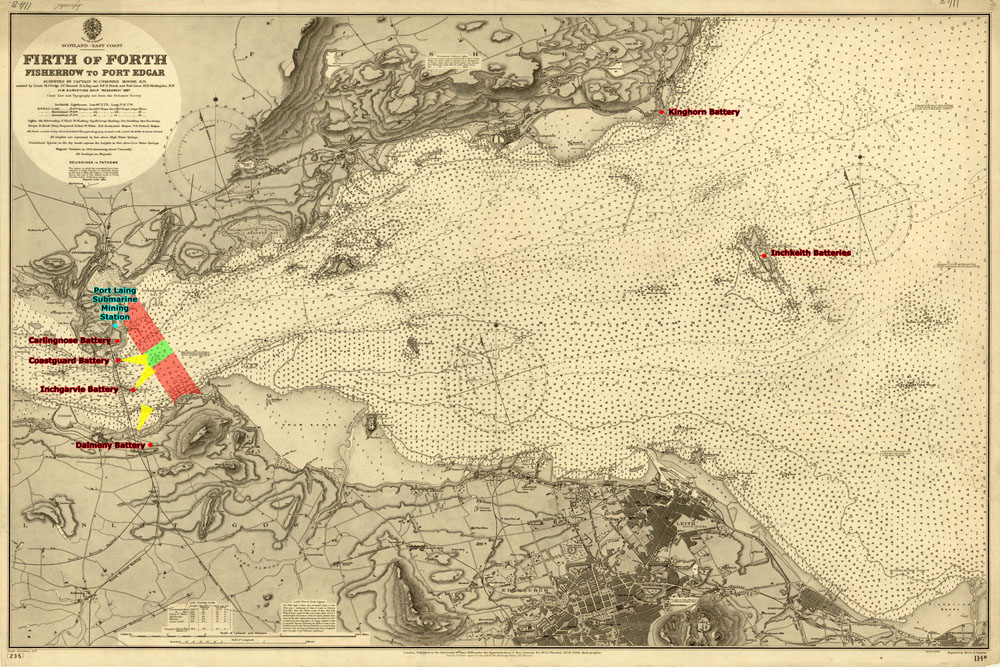
Forth Defences in 1901
Anti-Submarine nets were hung from the spans of the Forth Bridge, and strung across lines of dolphins further downstream. Gates in the net could be opened by armed trawlers.
The battery on Carlingnose Point was built between May 1899 and July 1901 at a cost of £7856 1s 9d. Two 6-inch guns were mounted in 1902 and remained in place until 1916. Following a large scale revision of the defences of the Forth it was decided that the two 6-inch guns should be moved to the new battery at Pettycur, Kinghorn, and the guns were transferred in November 1916.
Two Maxim .303 machine guns remained to defend the battery, which continued to be the site of the Fire Control Post of the Inner defences of the Forth.
The battery at Inchgarvie was built for two 12-pounder guns, between June 1900 and October 1901, at a cost of £2826. It took the form of a single block of buildings to the west, with the two guns on the same overall platform to the east. This was the armament of the island on the outbreak of war in 1914.
In April 1914 proposals had been approved to increase the armament of the battery to four 4-inch guns, with three defence Electric Lights – large searchlights to illuminate targets for the guns at night.
Two new gun emplacements were added to the east of the existing pair, and a new engine room was to be built at the west of the existing block of buildings. The two 12-pounders remained in position until the 4-inch guns were ready, and then they were replaced by two further 4-inch guns on special mountings to fit on the 12-pounder emplacements [The National Archives WO 192/108]. This was done by September 1915.
The two 12-pounders went to the Coast Guard battery.
In 1916, the 4-inch guns (Mk IIIs) were moved to Inchmickery and replaced by four 12-pdr Quick Firing (18cwt) guns. The fort had two .303 Maxim machine guns for close defence against enemy troops.
In the end (1917), the island was armed with four 12-pounders. It also finally had five Defence Electric Lights, although running more than four at once would overstrain the generating engines.
The guns were removed and returned to store in May 1920.
The battery had an establishment, on mobilisation, of 4 officers and 61 other ranks, which rose to about 90, with a detachment of 44 Royal Engineers for working the Defence Electric Lights and the telephone. Medical cover was provided by a RAMS Orderly from Edinburgh Castle.
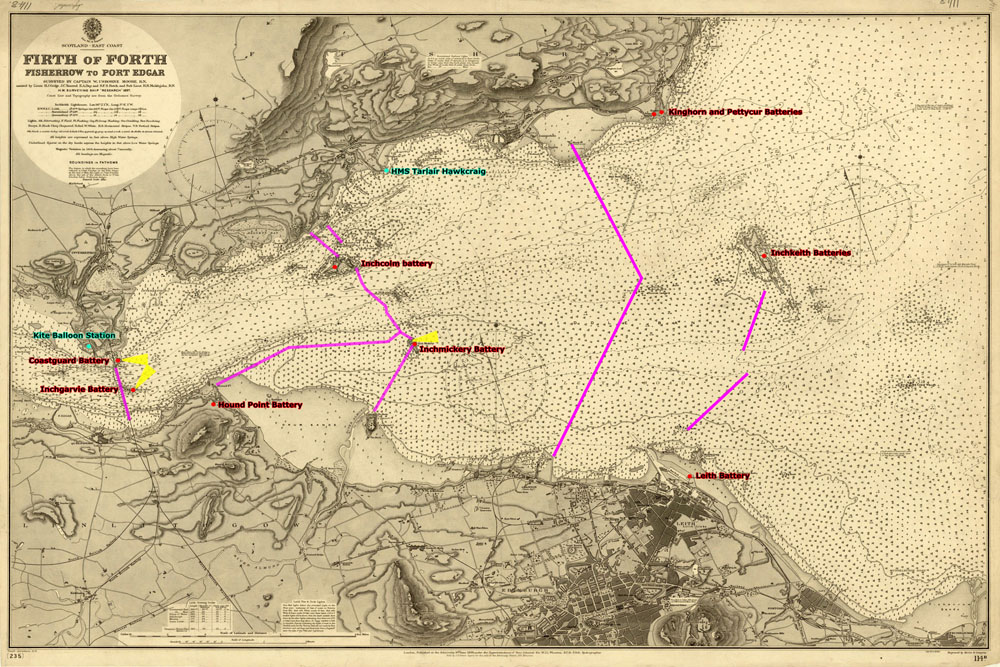
Forth Defences in 1918
1919 – 1938 Development of Submarine Mining Technology
From “The Fortification of the Firth of Forth 1880 – 1977” by Gordon Barclay and Ron Morris- p69
In 1928 and again in 1932, the area between Canty Bay on the East Lothian coast and the Bass Rock was used to test new developments in controlled mining. NO controlled minefield or detector loop had been laid since the end of the war, and officers and ratings had little practical experience. . . By the end of 1931 these experiments showed that loops and mines laid by trained personnel could obtain a high level of detecting efficiency.
This led to the introduction of a “Controlled Mining Handbook” in 1938, which recommended that mines were laid in a “standard 16-mine-loop”, consisting of a string of mines laid within a detector loop.
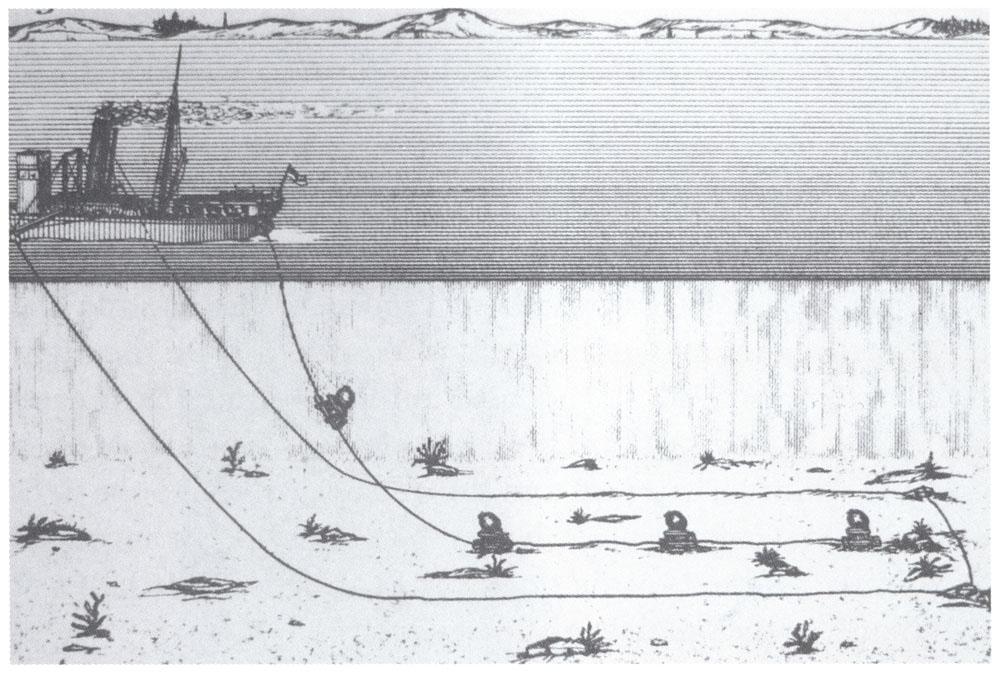
This diagram shows how the mines and detector loops were laid.
Many of these loops were deployed in the Forth by 1942
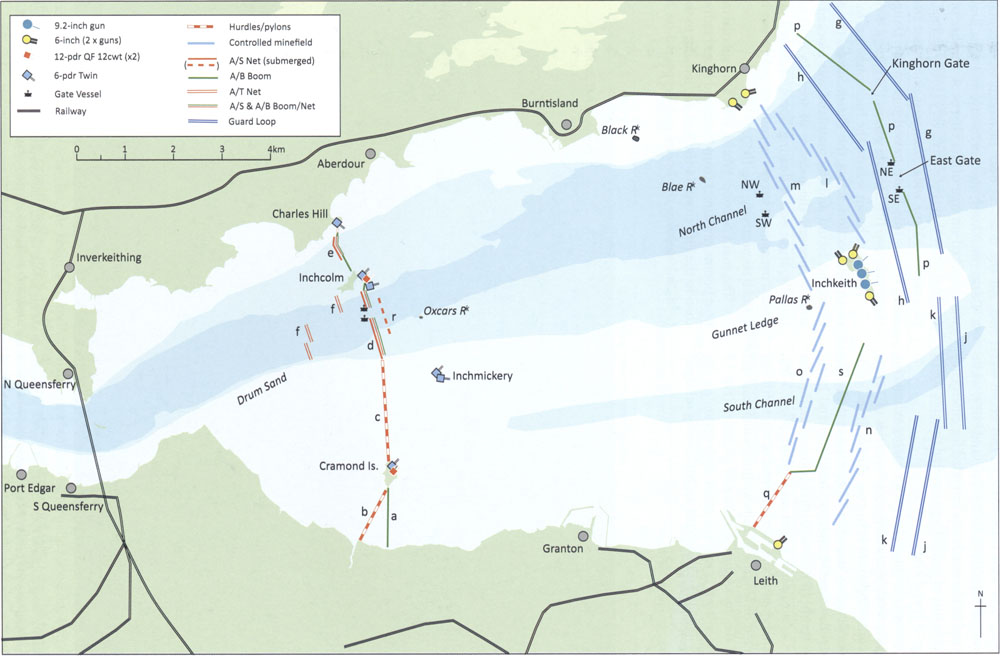
They were controlled from portable control stations consisting of a control hut, a power hut containing engines and batteries, and a telephone.
A rather different set-up to the pre-1906 station at Port Laing.
The Submarine Mining Station at Port Laing
The most obvious remains are those of the Guvy Pier . . .
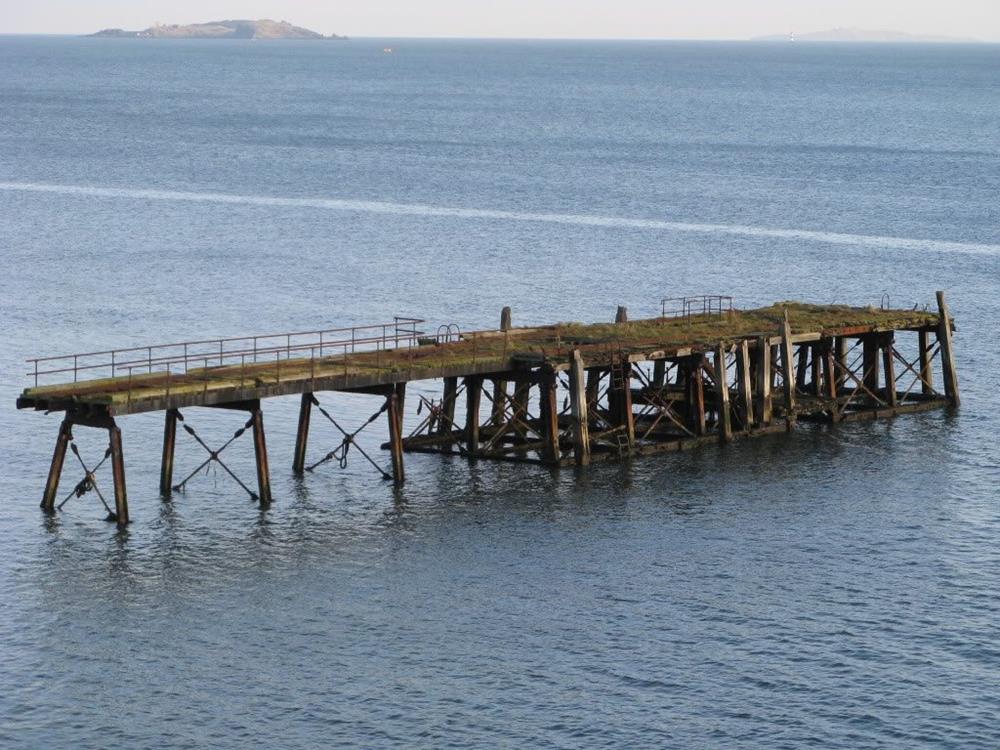
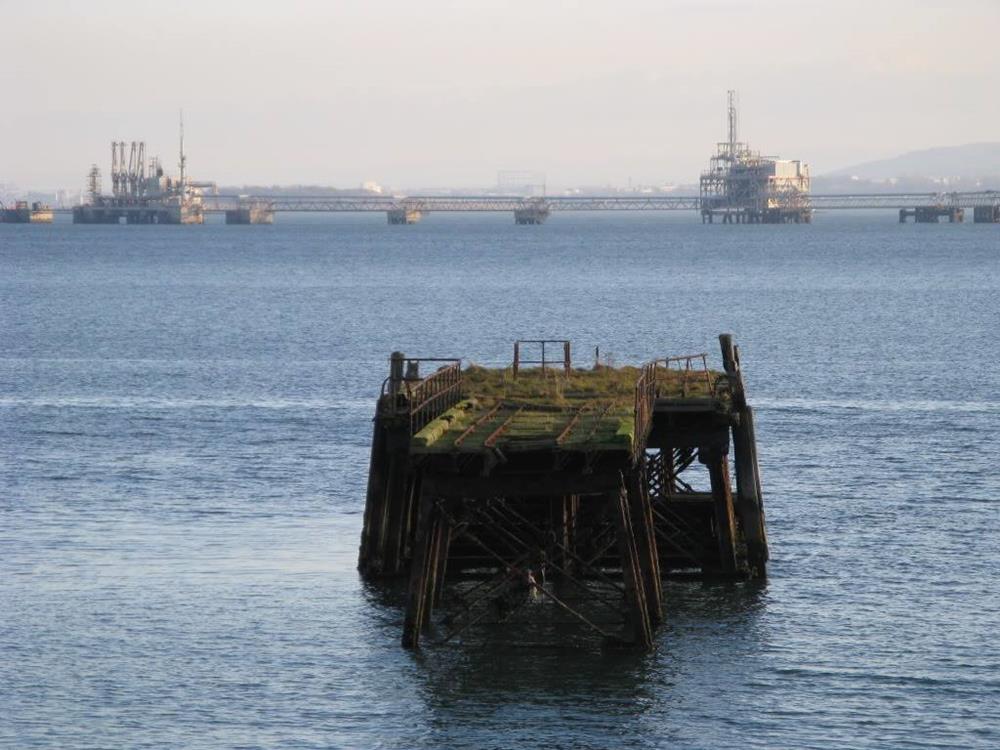
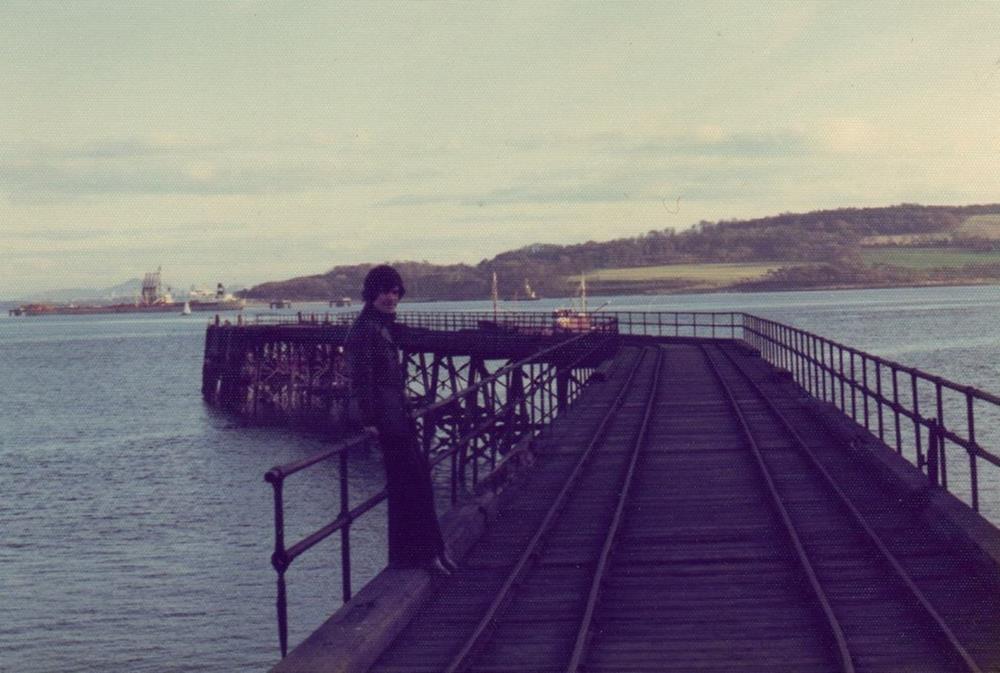
. . . which once carried a twin-track narrow gauge railway line.
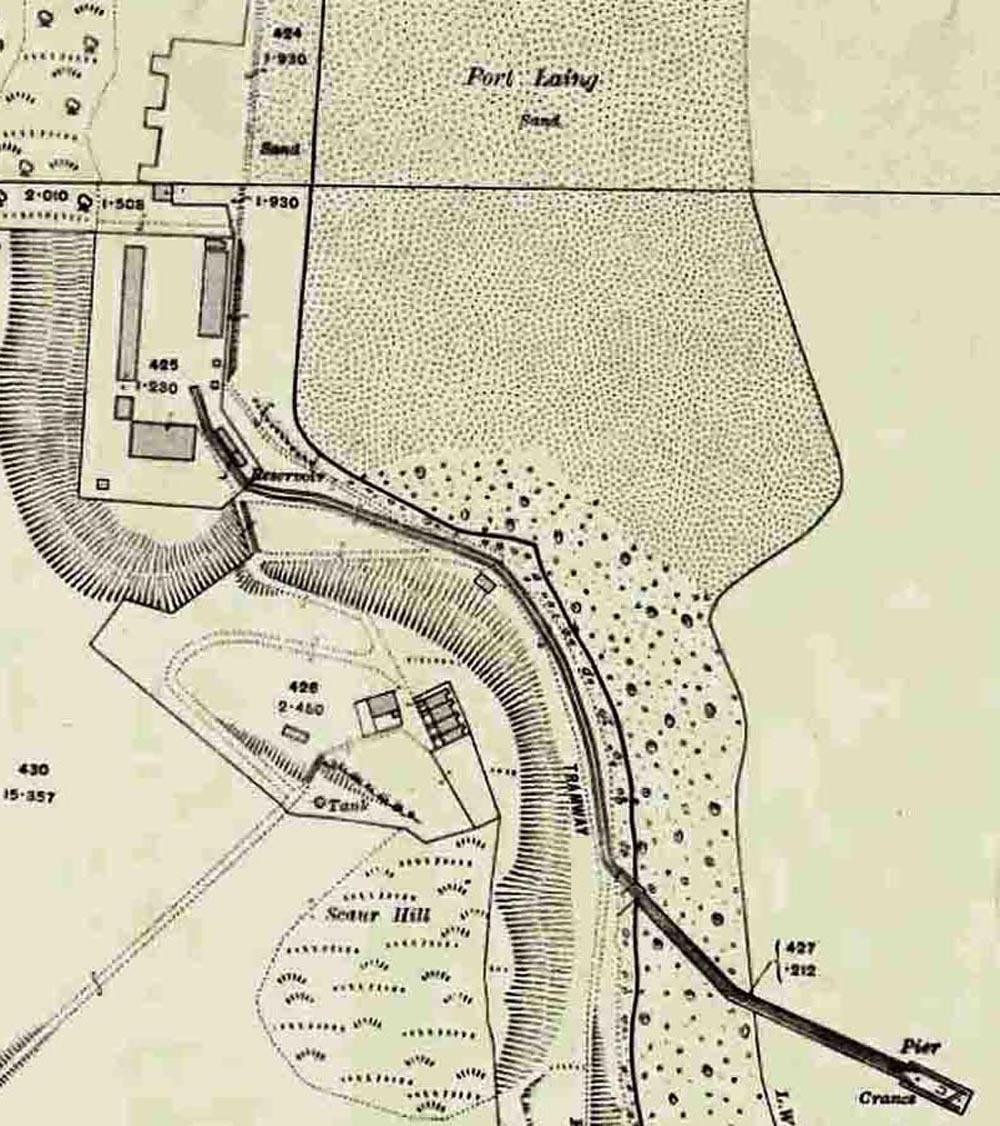
The 1915 OS map shows the railway running along the shore to a group of buildings just off the sand at Port Laing beach.
This aerial photograph from 1937 shows the site in a wider context.

There were gun batteries at Carlingnose, and on Inchgarvie – manned by Royal Engineers from the Carlingnose Barracks. There was also a gun battery at the Coastguard Station. This was all in alignment with the directives:
1. Mines should only be placed under the protection of the guns of ships or forts.
2. They should be placed about 1000 yards in front of these guns.
There were search lights on Inchgarvie and at the Coastguard station, and perched on the cliff top above the pier was an Observation Post.
Port Laing Buildings
The group of buildings at shore level must originally have been the workshops, stores and control room for the Submarine Mining Station. [They were later converted to other military purposes and finally demolished when the whole site was sold in lots by the War Department in September 1960.] The small block of buildings about half way to the pier were later used as married men’s quarters.
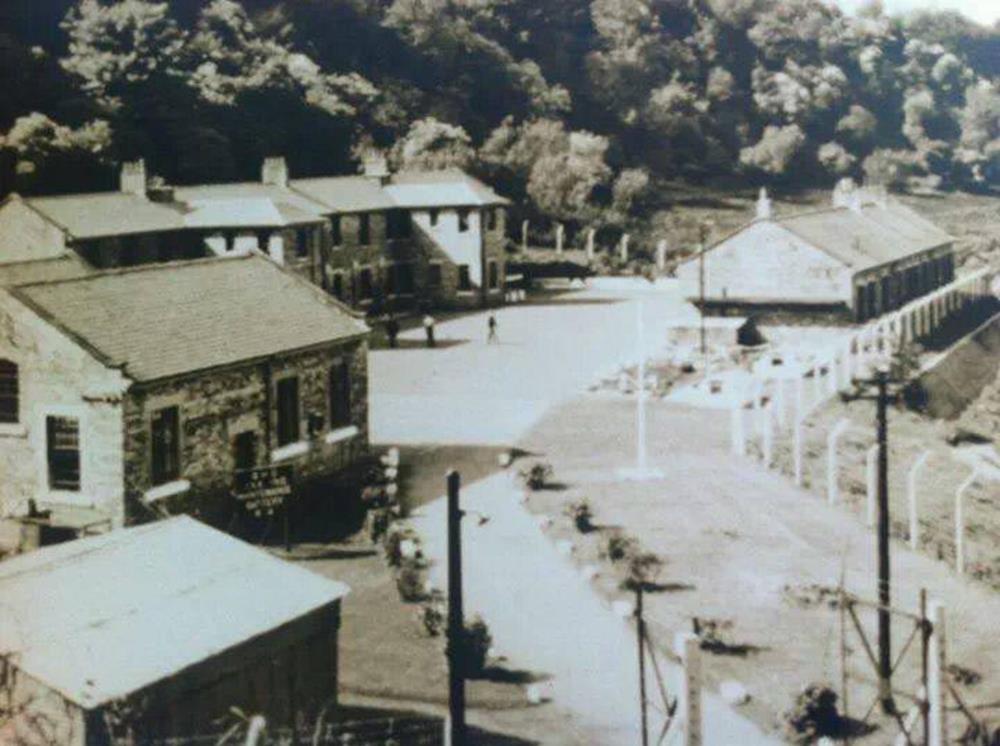
This a much later view of the site on the shore, showing more details of the buildings.
The railway track has gone, it ran along the line of the road.
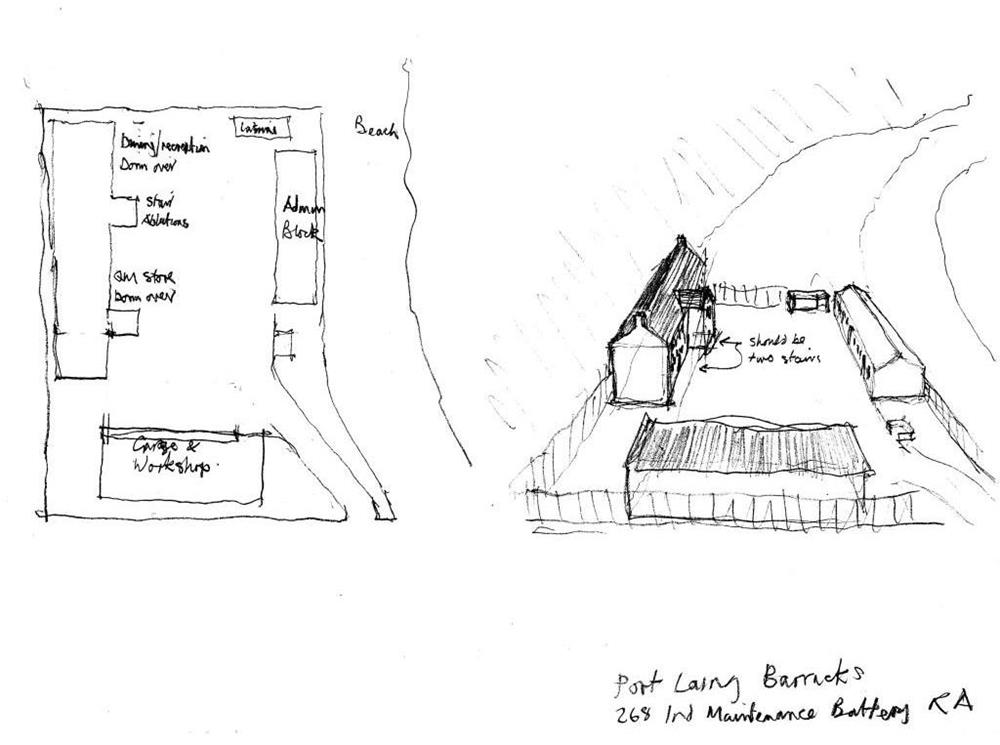
This sketch was provided by Laurie Alexander, a bombardier in the Royal Engineers, who was the last man to leave the site when it closed in March 1957.
The Garage and Workshop were probably the mine store and workshop.
The Admin block may have been the Control Room – with a row of windows looking over the Forth.
The two-storey block was a dormitory upstairs with Quarter Master Stores and Dining / Mess Room downstairs. Were these the “handsome Officers’ Mess” referred to by Cadell?
The buildings no longer exist, but they sat on a solid concrete base, which still exists under these modern houses at Port Laing.
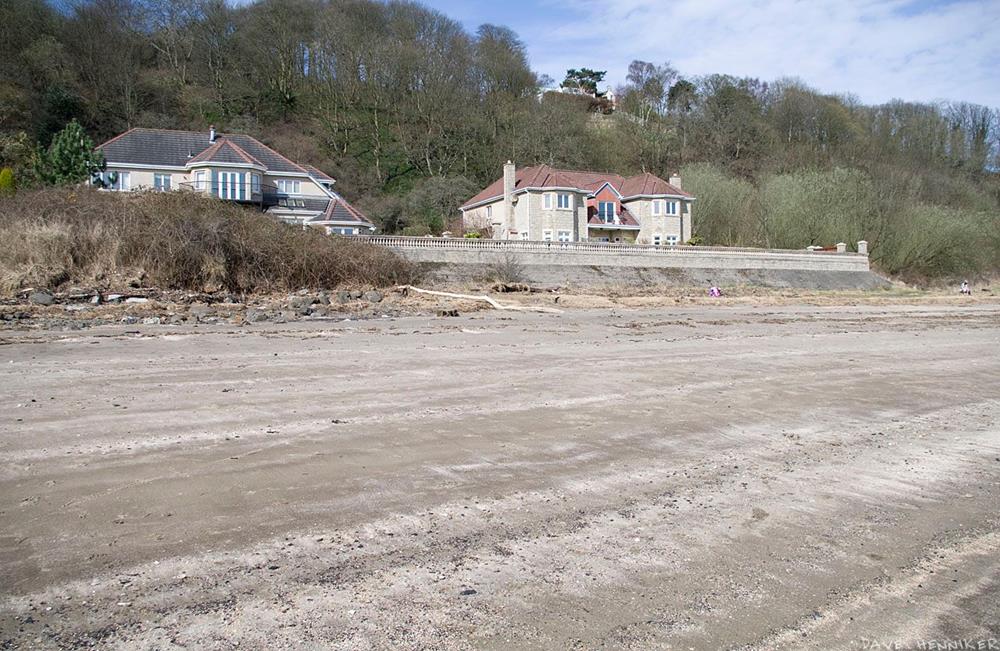
The Carlingnose Battery and Submarine Mining Observation Station
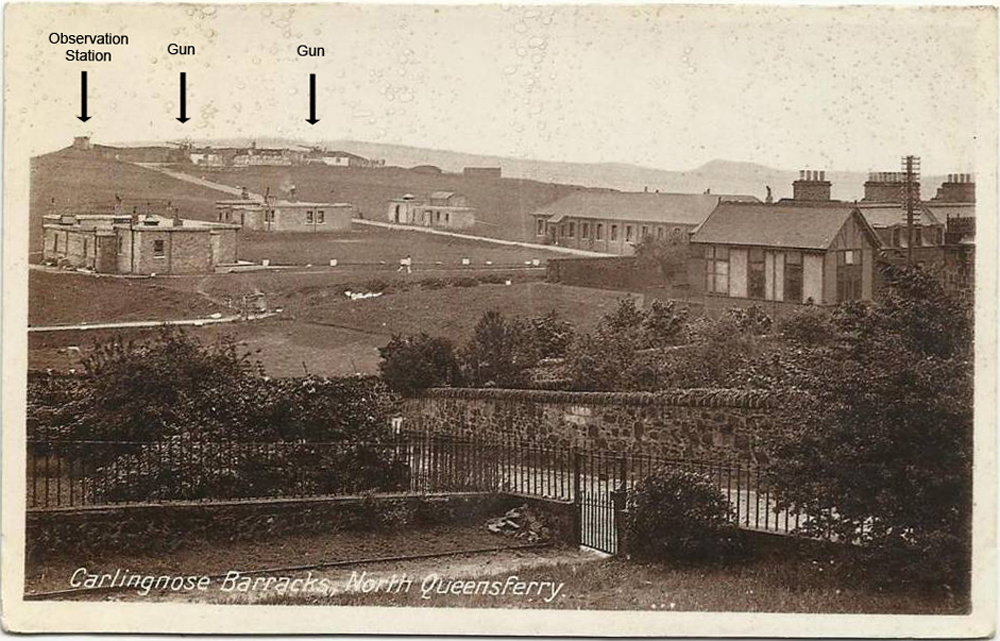
The Carlingnose battery is at the top left of this view across the barracks. You can just see the gun barrels pointing down the river. The observation station is perched to their left.
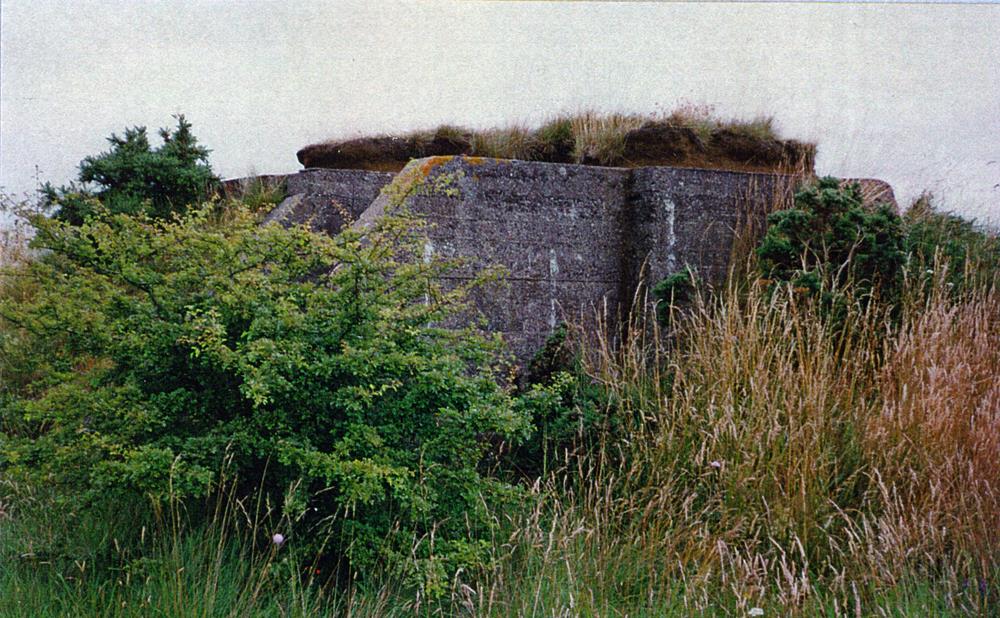
This image of the Observation Post is from Fife World War One and Two Defenses Volume 1. A survey by John Guy 1992 – 1994.
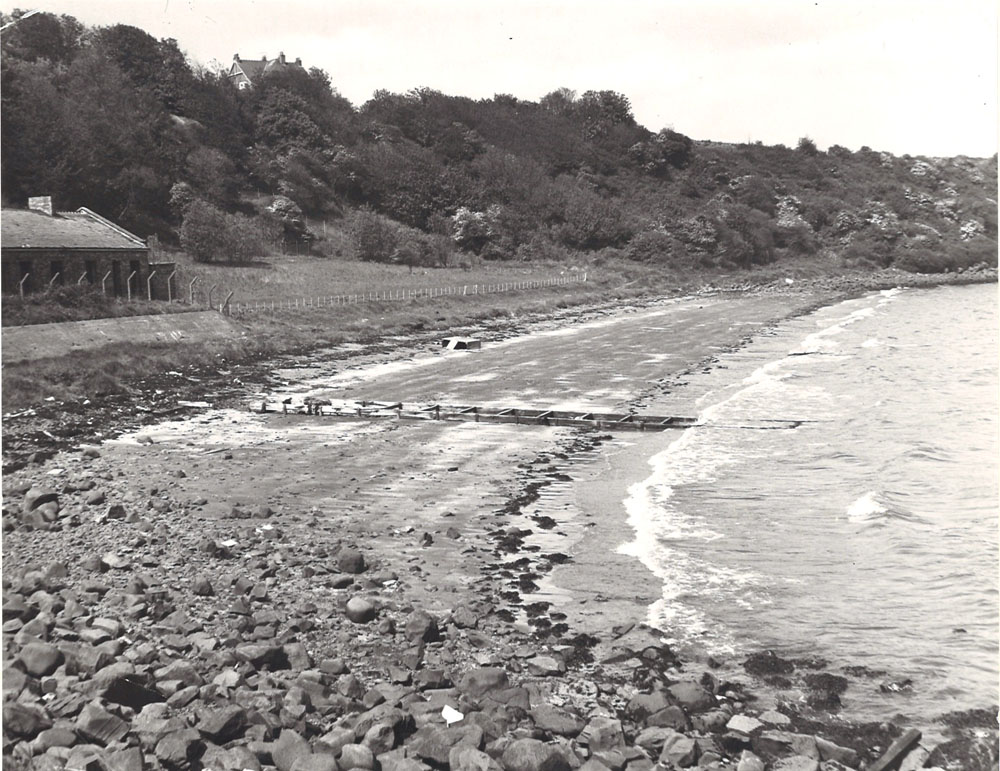
Finally, this image which was supplied by Dunfermline Carnegie Library, and is reproduced by permission of DC Thomson & Co Ltd, is probably from the early 1900s. It shows the shore station at Port Laing, with a wooden “walkway” running across the beach. I suspect that this was a cable tray that held the cables running from the control room to the minefield, and protected them from chafing as the tides ebbed and flowed.
Electrical control of a mine
Both observation and contact mines were detonated using electricity. The power was supplied by sets of batteries in the shore station – no national grid! Each mine was connected to the shore station by a single electric cable, with the return path being through the “earth” i.e. the surrounding sea-water.
To detonate a mine, an electric current was passed through the cable to a platinum-wire fuse in the mine.
The fuse heated up, became incandescent, and ignited a surrounding layer of detonating explosive (fulminate of mercury) the detonating charge.
This in turn then ignited a primer of 4 ½ lb (2 kg) of gun-cotton. These inner components – fuse, detonator and primer charge, were contained in a sealed steel container, call the apparatus.
The detonation of the primer charge ignited the main charge of guncotton.
For a Contact Mine, moored on cable to float just beneath sea level at low tide, the main charge was 100lb (45 kg) of gun cotton. In contrast Observation Mines sat on the sea bed, so required a larger charge, 250 lb (113 kg) in water at a depth of less than 36 feet (11 m) or 500lb (227kg) in water of less than 60 feet (18m.)
The whole thing was of course contained in a steel outer casing.

This is the simplest configuration for an observation mine. On spotting an enemy ship over the position of the mine, the shore switch is closed. Current flows from the battery through the fuse in the mine, and back via the earth return path – through the sea water. The fuse heats up and the mine explodes.

A contact mine requires an additional trigger switch in the mine, which is closed when the mine is struck. During the day, the shore switch is open, so no electricity will flow even when the trigger switch is closed. At night, with the shore switch closed, the mine is active and will explode when struck.
In practise, life was inevitably more complicated.
If a cable was broken, by snagging on the sea-bed, being dragged by passing ships, or even sabotage, the connection would be “open-circuit” so current could not flow and the mine would not explode.
If the cable insulation was damaged, sea-water would short-circuit the connection, the current would not pass through the fuse and the mine would not explode.
Electrical Cable
Cable technology was still in its infancy, no popping in to B&Q or Screwfix for a reel of plastic insulated power cable!
The cable was the longest in the world at the time.
From The Scotsman Tuesday 23rd January 2018]
Each mine was connected to the shore station using a single-core cable. This core was made up of seven strands of copper, each strand being tinned, to protect the copper from the corrosive effects of the insulation.
The copper core was then insulated using Hooper’s Material. This consisted of an inside coating of pure India rubber, then a separator layer which was another coating of India rubber combined with zinc oxide, and finally an outside coating of India rubber combined with sulphur. The separator prevents any damage to the conducting wires by the action of the sulphur. The three coatings were then baked for some hours at a very high temperature, which fused the whole into a solid mass, and vulcanised the outer coating.
This created a tough outer layer of vulcanised rubber, and a flexible inner layer of insulating pure India rubber. The cable was then wrapped in a protective sheath of hemp, followed by a steel-wire armour layer to guard against cable damage by the action of currents, or snagging on rocks, and a final outer sheath of braided hemp.
This was Cadell’s “long cable of copper-cored twine” from the Company Song.
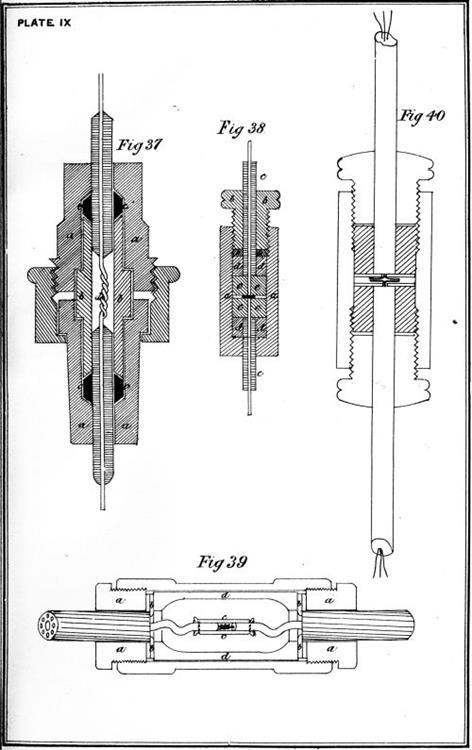
The return path for the electric current from each mine was by “earth” i.e. through the surrounding sea-water.
The cables were laid in sections, necessitating joints which could withstand immersion in sea-water.
This was not straightforward.
Soldering was used at first, but this is difficult in an open boat at sea, and a simple twisted joint proved to be satisfactory.
Insulation of the joint involved wrapping it in layers of India rubber, stuck together with India-rubber solution.
The joint was then encased in a protective junction box.
Once the cable was connected from the mine to the shore station, it was necessary to test the connection on more or less a daily basis to ensure that the cable had not broken, or that sea-water had not intruded, which would short circuit the connection.
In fact this single strand cable connection had to serve three purposes:
1. to test the connection from shore station to the mine.
2. to signal from the mine to the shore station that a mine had been struck
3. to detonate the mine from the shore station.
These three functions were achieved with some clever electro-mechanical pieces of equipment. (long before the days of electronic valves and transistors!)
The details of the electrical systems are covered in an appendix.
Layout of a Minefield

As described earlier, a typical minefield consisted of a 400 yard-wide friendly channel, guarded with observation mines, and flanked by electro-contact (EC) minefields.
Lots of experiments were undertaken to determine the optimum spacing of both types of mine.
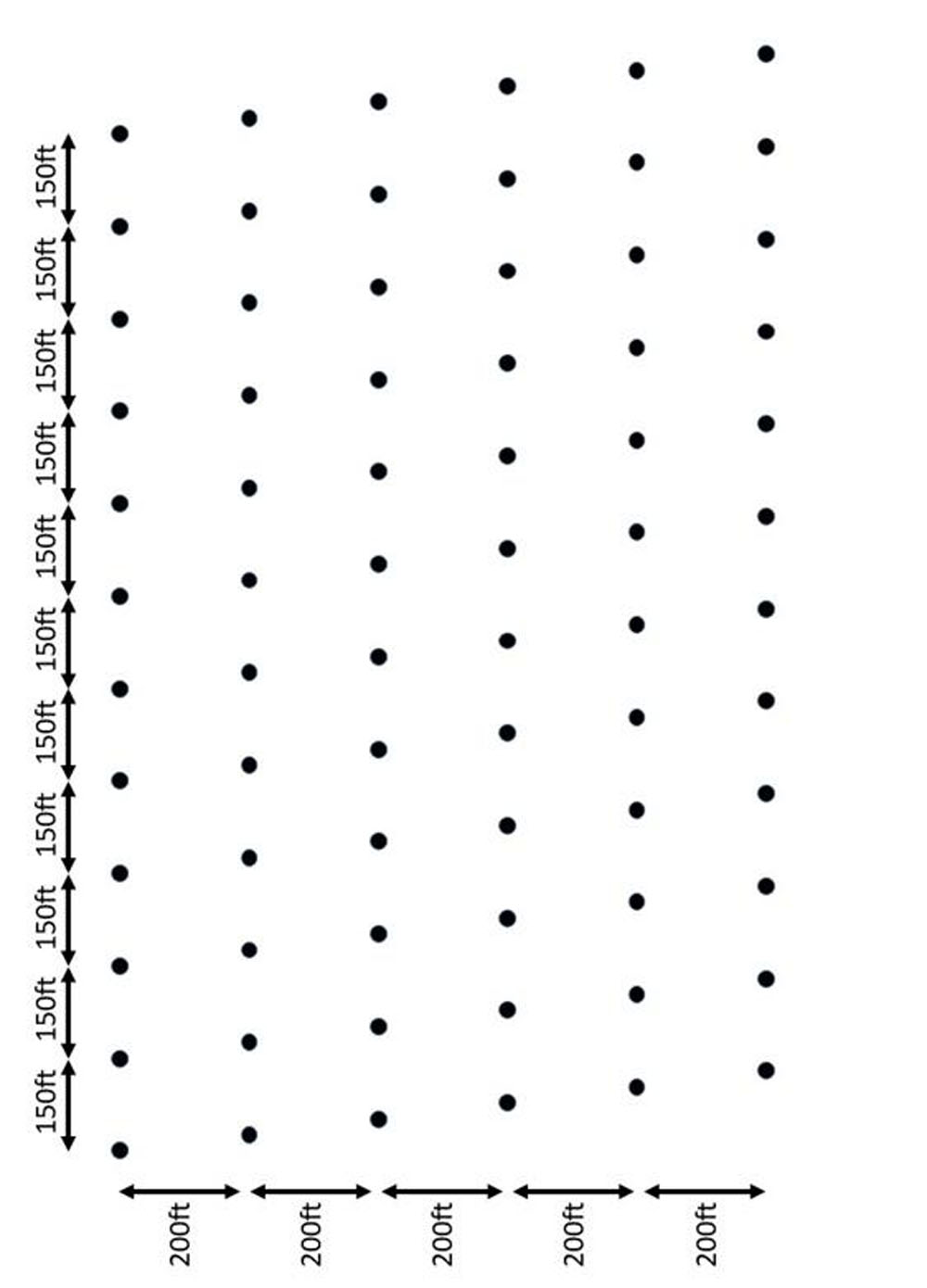
The electro contact minefield was laid out so that there was effectively one mine every 25 feet across the estuary.
However, the mines could not simply be laid out like beads on a string, because the explosion of one mine would then trigger the detonation of adjacent mines and ultimately blow up every mine in the minefield.
It was determined that these mines had to spaced at least 100 feet apart to prevent this sympathetic detonation. So the Electro Contact minefield was laid out in six rows 200 feet apart, with the mines in each row 150 feet apart.
This gives the desired effective spacing of 25 feet between mines across the estuary.
Connecting up the EC mines
The earliest form of Electro-Contact mine, as described above, used a momentary-action contact-closer in the mine (i.e. the switch was only closed for a moment when the mine was bumped) and needed a dedicated cable to connect each mine to its associated shutter box in the shore station.
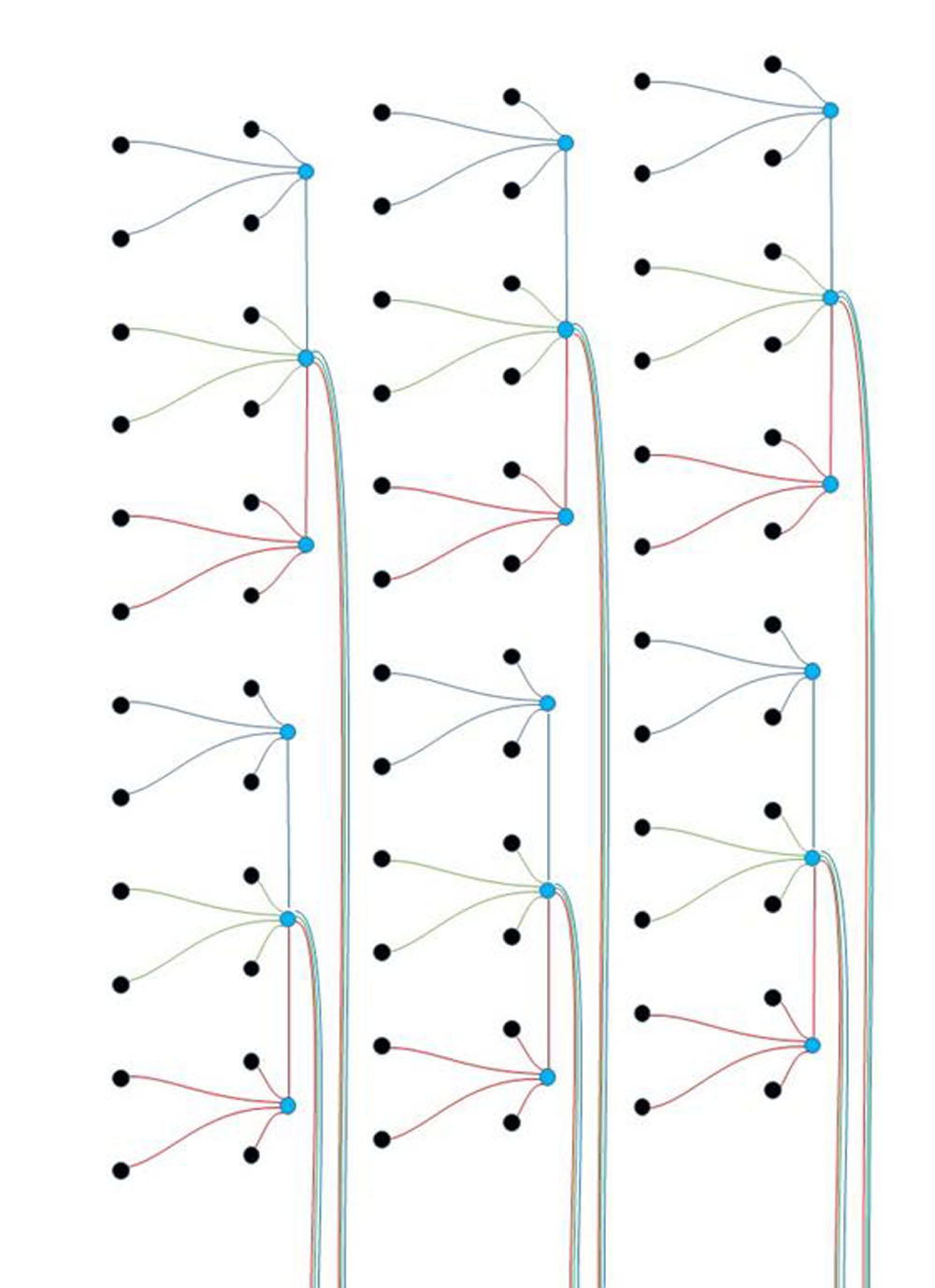
A later version used a “polarized relay” in the mine. This acted as a “latching switch” i.e. when the mine was bumped, the switch closed, and stayed closed.
This new design allowed four mines to be connected to one cable, and managed by one shutter box.
Connecting Observation Mines
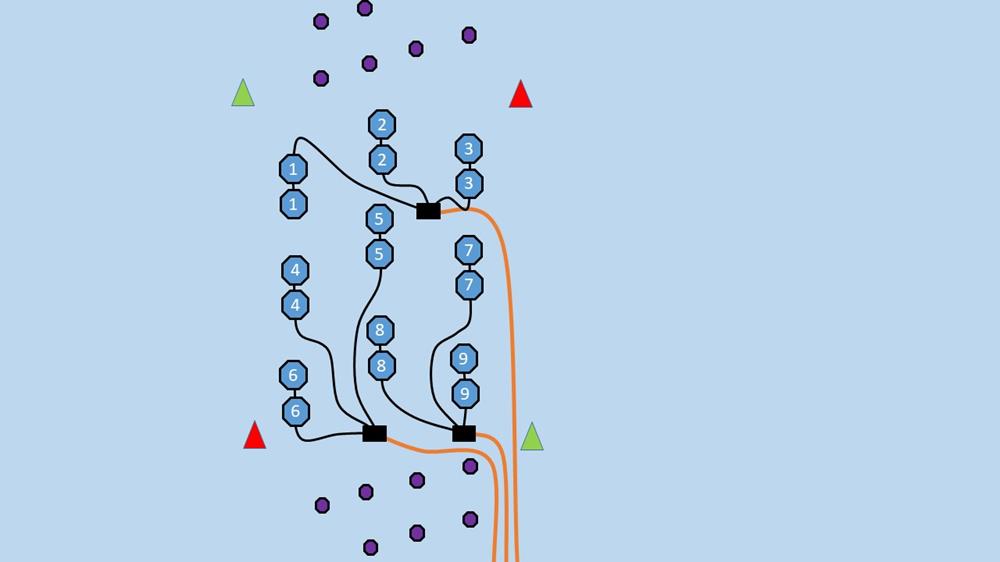
This diagram shows how observation mines were laid in the friendly channel. They are spaced so that it is impossible for a ship to thread a safe passage between the mines. The observation mines were deployed in pairs, each connected to one firing switch.
Two smaller mines fired together gave the same coverage width as one much larger mine. Two smaller mines were easier to deploy, and also the smaller blast radius made them less likely to affect other mines in the vicinity – especially contact closer mines outside the friendly channel.
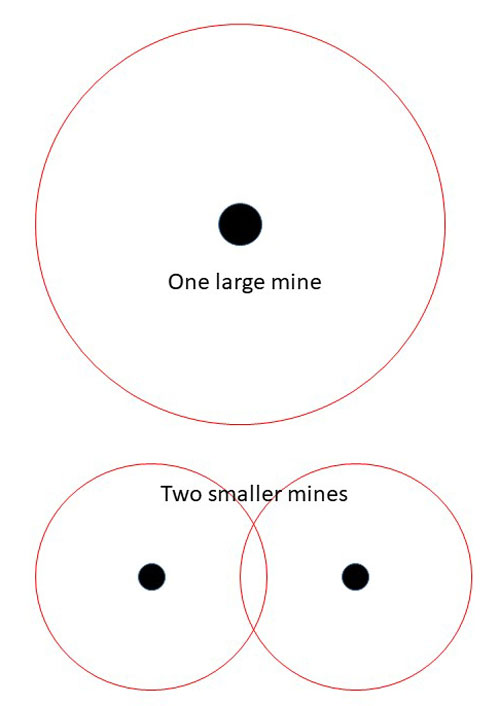
The observation mines were connected to the shore station through a four-core cable which terminated in a submerged junction box.
From each junction box, three single-core cables each connected to a pair of mines. One of the cores in the four-core cable was left as a spare in case of faults in manufacture or damage on installation.
Observation stations were placed on shore abreast of the mines, if possible at a height above the water of 1/60 of the distance to the furthest mine.
[The Carlingnose Observation station is about 125 feet above sea level. It is about 7000 feet to the shore at South Queensferry, so the far edge of the friendly channel was perhaps 5000 feet away. The height is then 1/40 the distance to the farthest mine.]
Mooring Observation Mines
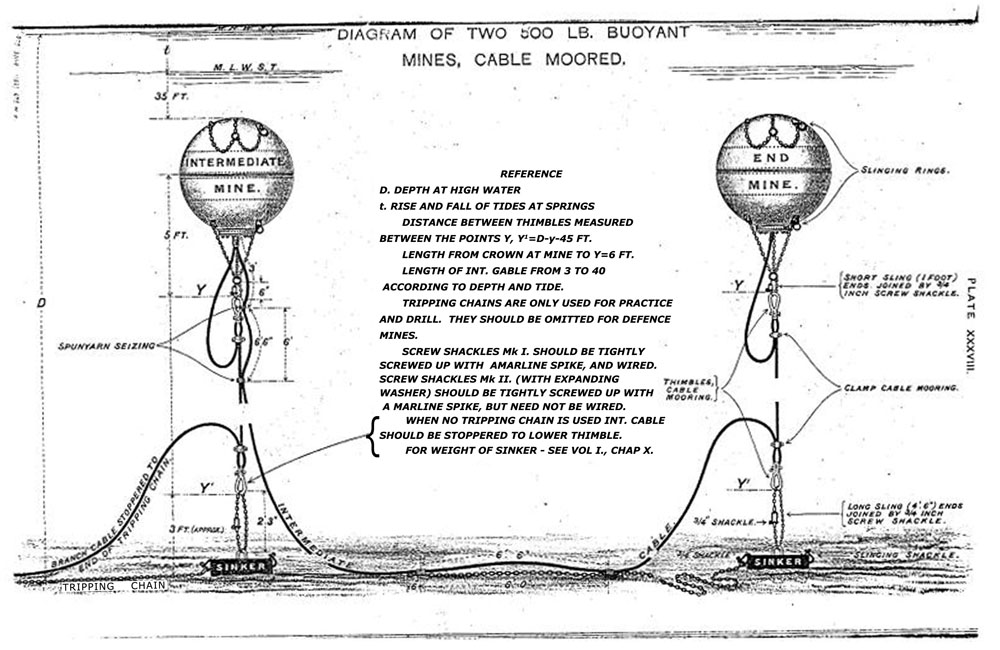
This diagram shows how a pair of observation mines were deployed. These are buoyant mines for use in deep channels. They are moored to sit well below the surface (35 feet or approx. 10.5 metres) so that ships can pass without dragging them out of position. In shallower water, they would sit on the sea bed.
Electro-contact mines were moored in a similar way, but were moored much closer to the surface so that they would be struck by passing ships. During the day, the electro-contact mines could be dragged out of position if friendly ships wandered into the no-go zones. The minefield was tested daily to ensure everything was connected properly. Faulty or suspect mines could be retrieved and replaced, or divers could be sent down to inspect the mines in situ.
The Port Laing Minefield
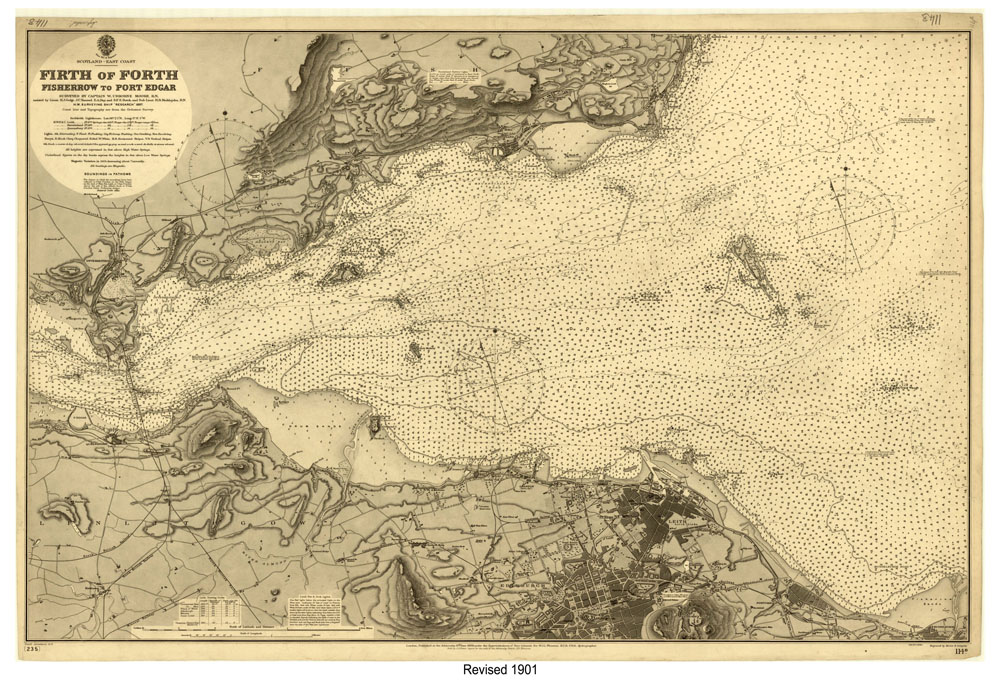
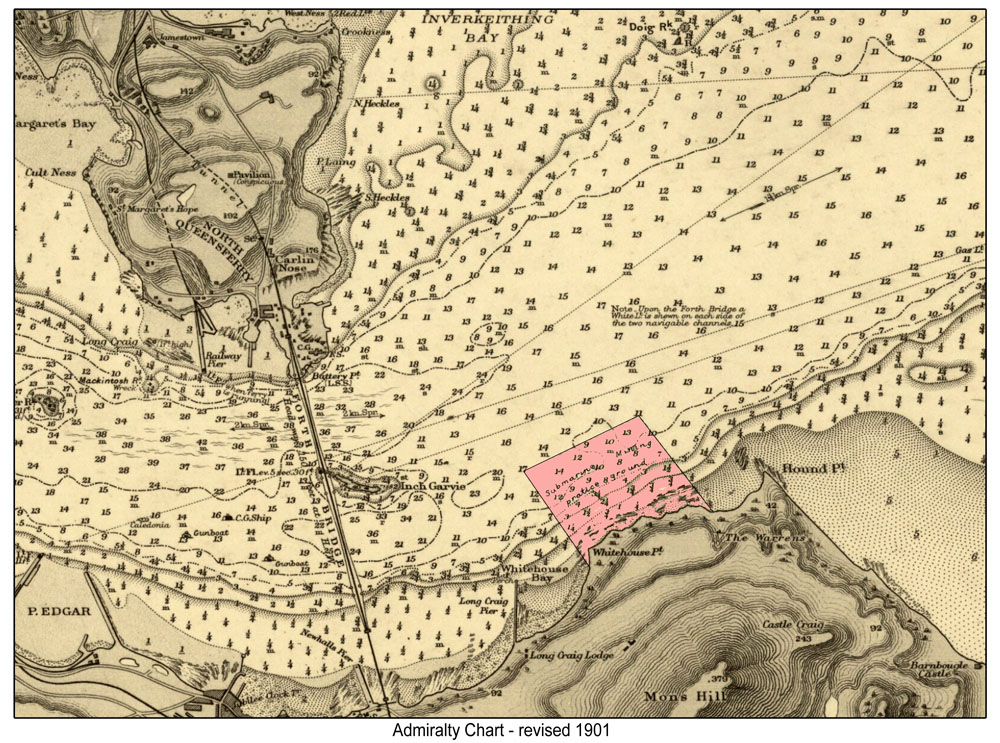
This Admiralty Chart from 1901 shows a Submarine Mining Practice Area on the south shore opposite Port Laing.
The live mine-field was probably deployed from here across the shipping channels to the north shore. [The practice area was normally sited to be part of the main mine field.]
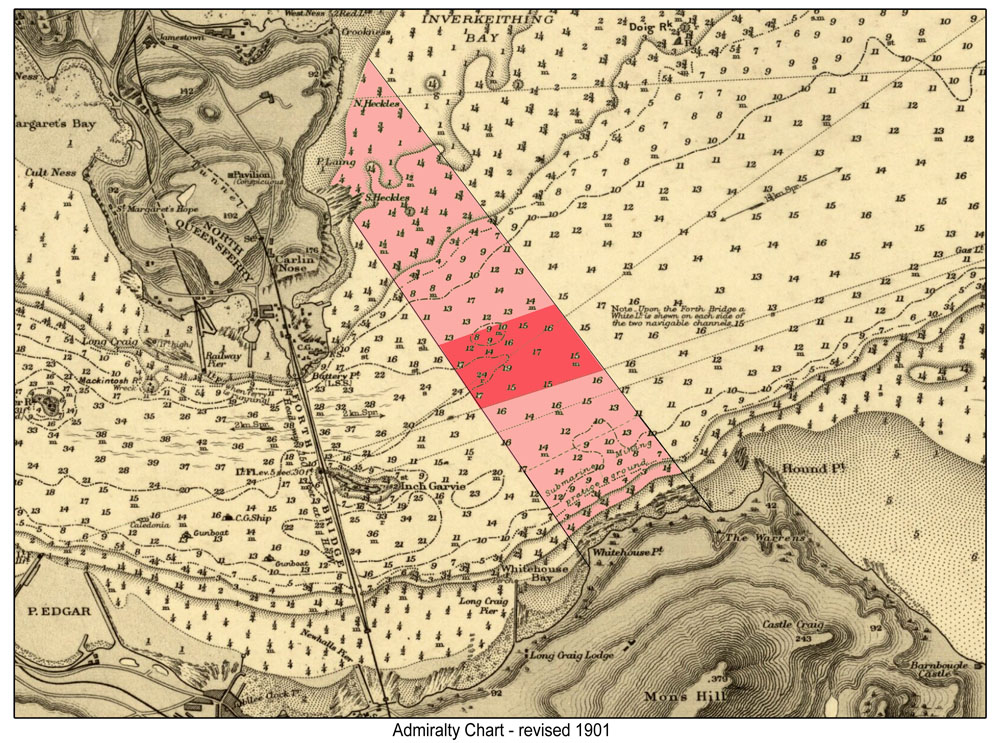
A 400 yard wide friendly channel would be marked with green and red buoys:
Cadell’s “Flowers of the ocean bed, Painted both green and red, Signals of safety or danger malign.”
Mines, Guns and Lights

This chart shows the probable position of the minefield, and the known positions of the gun batteries at Carlingnose, the Coastguard Station, Inchgarvie, Dalmeny and Hound Point, all pointing squarely at the friendly channel, as are the electric lights the Coastguard station, Inchgarvie and Dalmeny.
All three elements – mines, guns and lights – combined to provide a protective screen against an enemy attack.
Deploying the minefield
The red band is the 400 yard wide friendly channel, protected on either side by contact mines in the pink zones. The pink zones run from about the one fathom mark (2 meters) on each shore, on the basis that a ship would run aground closer to shore. The total width of both pink zones is about 6 1/2 cables or about 4000 feet. So about 160 contact mines are needed to provide coverage of one mine for every 25 feet of frontage. The friendly zone needs a further nine pairs of observation mines. So the whole minefield involves the laying of about 180 mines, and more than forty cables from the shore station to submerged junction boxes. [This is an upper limit of estimation, the pink zones probably started in slightly deeper water, especially on the north shore where the water shelves very gently. This could have saved perhaps 40 contact mine bringing the total to around 140 mines.]
Records show that with experienced teams, it was possible for two laying boats and associated parties to deploy a minefield of 100 mines in a 10 hour working day from 7.45 am to 5.45 pm. This performance was considered to be typical.
So the Port Laing minefield could be deployed across the Forth in less than two working days.
That sort of performance required careful planning, detailed logistics, rigorous discipline, and lots of practice for the 16 officers and 243 other ranks who made up the corps in 1904.
The men were assigned duties in a number of specialized parties.
Priming Party – making a final inspection of apparatus, inserting dry primer, and issuing primed apparatus to the mine store.
Mine Store Party – inserting primed apparatus, putting mines on trucks with mooring lines etc., if stored in the mine store.
Fetching Stores Party – bring up mines cables etc. to the connecting up ground, and taking mines and sinkers to the pierhead.
Connecting-up Parties – Connecting cables to mines and arranging moorings.
Pierhead Parties – embarking mines on the laying out vessels.
Laying Parties – slinging and laying mines and cables.
Junction-box Party – making cable connections in each junction boat.
Test-room Party – testing mines and attending to position finder.
Alignment Party – if any alignments of mines are marked by movable poles.
Crews of Vessels – handling the mine-laying vessel. The usual strength of a party was one NCO and six men.
[We don’t have any photographs of mining operations at Port Laing, but the Fort Gilkicker website has several showing these various parties at work.
Given the national basis of the mining service, we can assume that these were similar to the operations at Port Laing.]
All these parties were drilled for rapid work. It was probable that some notice would be given before the mines could be laid out – i.e. a threat was Imminent. In such a case the apparatus would be primed and inserted, cables laid with dormant buoys, branch cables cut, sinkers got to pierhead, and test-rooms and observing stations overhauled.
However assuming the worst case that no notice had been received, the various parties worked as follows.
Shore based parties
The priming parties worked in specially constructed buildings called priming pits, generally built in a corner of the enclosure and protected from the rest of the buildings by traverses. Only one man worked in the pit, and stringent safety precautions were enforced.
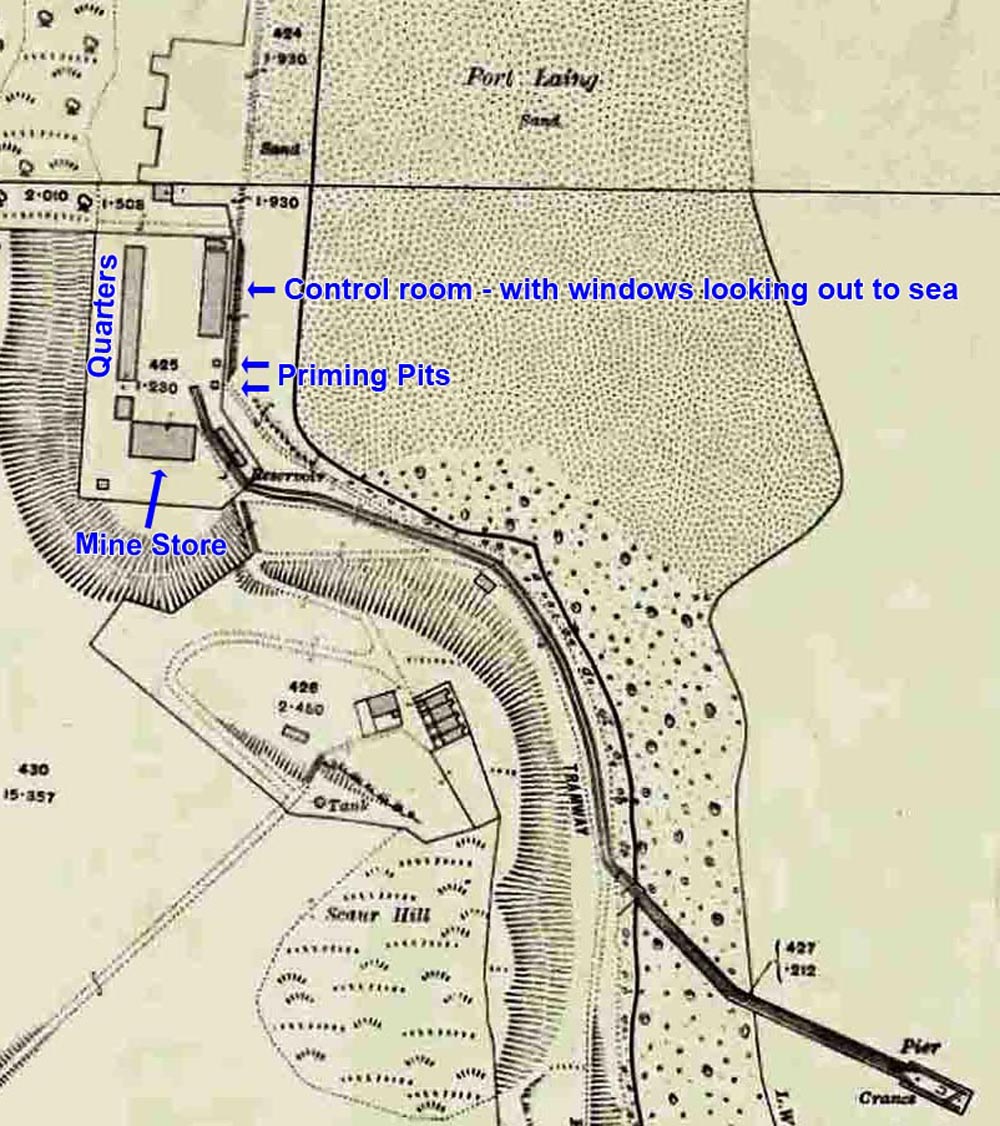
Given the appearance of the buildings, and the layout of the site it is likely that these were the functions of the various buildings
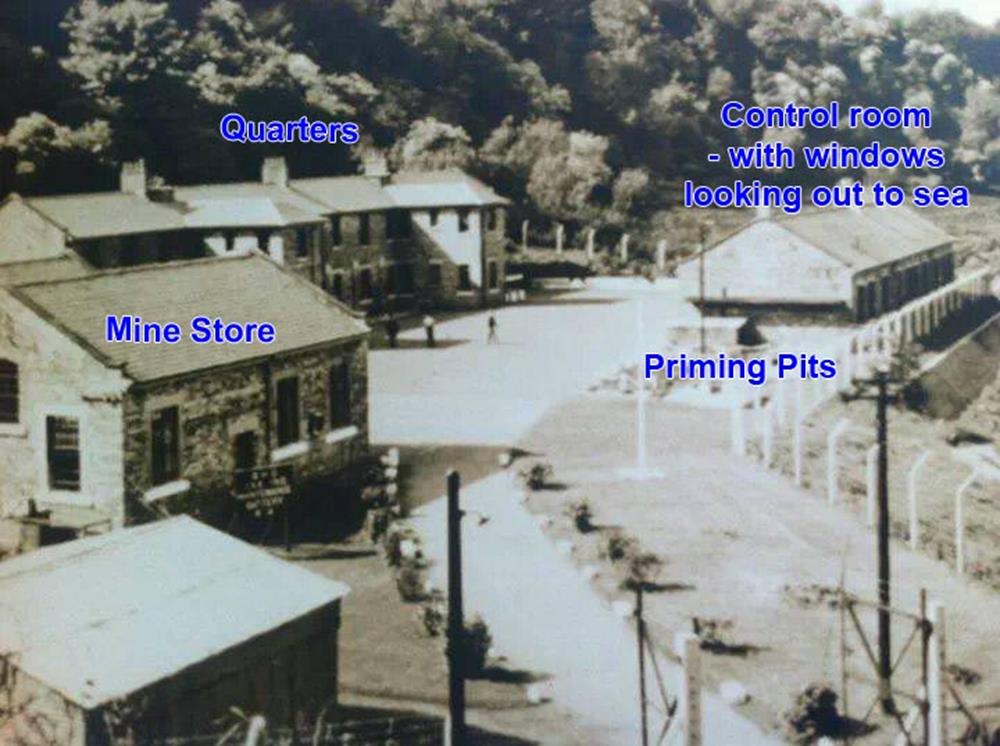
The priming pits are in the corner of the site. The tramway ran where the road is in this later photo.
As soon as an apparatus was primed, it was inserted in the mine by the mine store party. They worked in the loaded mine store which was about 40’ by 20’, and was fitted with an overhead traveller to lift weights up to one ton. An 18” tramline connected to the general system ran down the centre of the building. When the apparatus was inserted, the mines were lifted and placed one or two on a small truck, with their mooring lines and tripping wires if stored in the mine store. They remained on the truck till lifted off at the pier-head. To facilitate working in the mine store, the mines were stored in the order in which they were required by the laying-out party, and this order was known to the NCO in charge of the party.
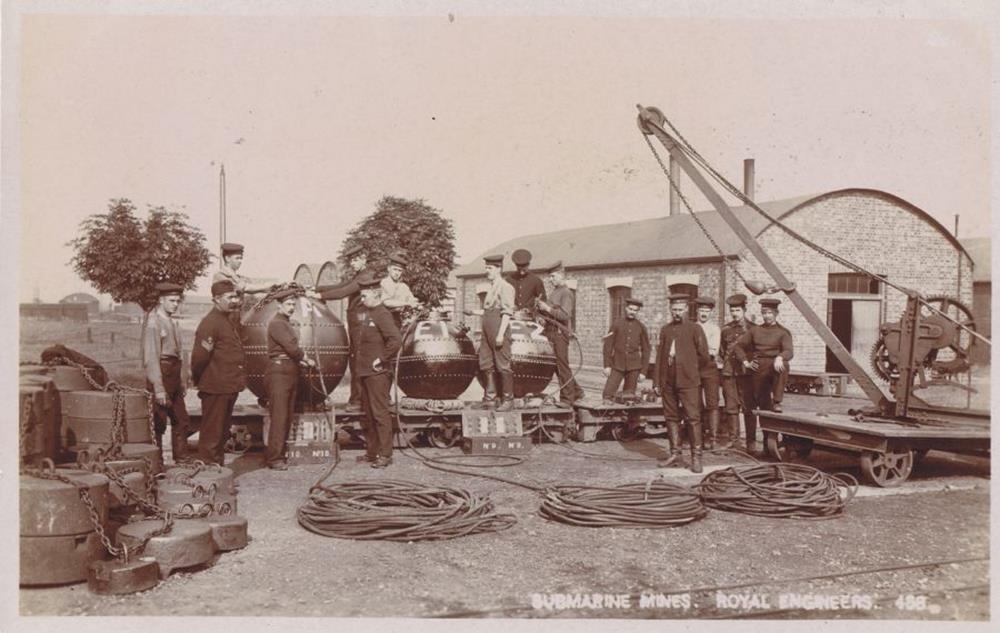
The fetching-stores party had meanwhile been cutting up and crowning cables and laying them out on the connecting-up ground. They also removed the loaded trucks from the mine store and brought in empty trucks.
The connecting-up parties had to first make the joints between the leads of the apparatus and the cable, then connect the mooring cables and stopper cables and mooring together, also fasten the ends of the tripping chain to the cable. Two to four such parties were usually detailed for this purpose. They left all the gear stowed on the truck, so that the mine could be lifted as a whole and put on the deck of a vessel.
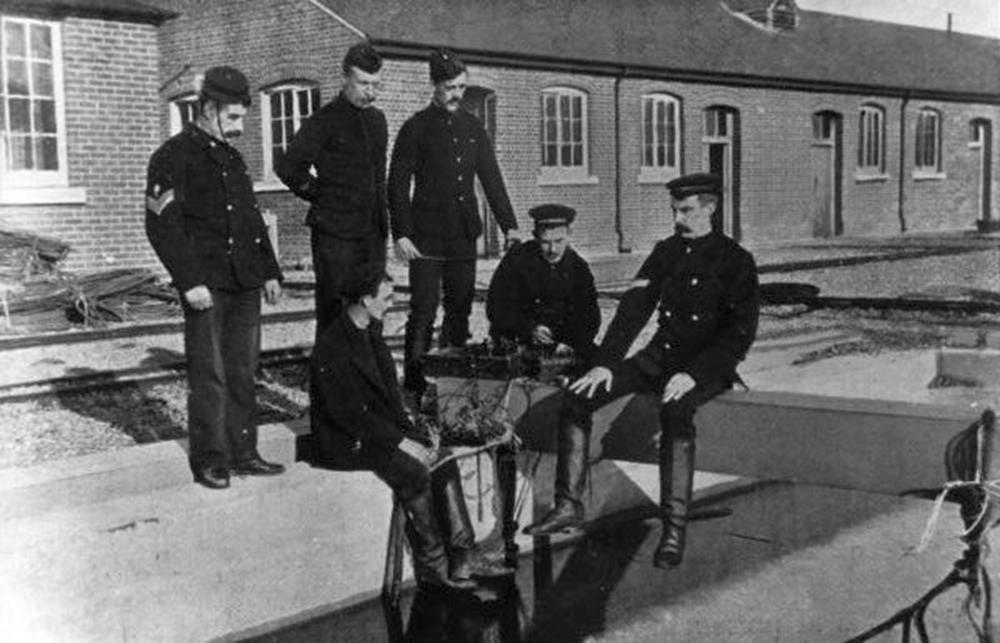
Making up cables and junction boxes – Gosport 1897
The pierhead parties took the mines from the connecting-up ground to the pierhead, lifting them off with the pierhead cranes onto the vessels deck, and sending empty trucks back to the mine store. One party was required for each crane in use, there were generally two on a pier.

Water-based parties
The laying-out parties worked on the vessel’s deck assisted by the crew. There were usually two parties, one on each side of the vessel, and their duties were to receive the mines on deck, sling them out in succession, and lay them out. Loading of the vessel was usually done from the stern, the forward mines being first laid out. E.C. mines [contact closer] were slung on either bow, using the bow and foremost derricks to lift them. Lines of mines [observation mines] required more space than E.C. mines [they were larger, and deployed in pairs.] Slinging was effected by short manila ropes passed through a ring of the mine or sinker, with both ends made fast on board.
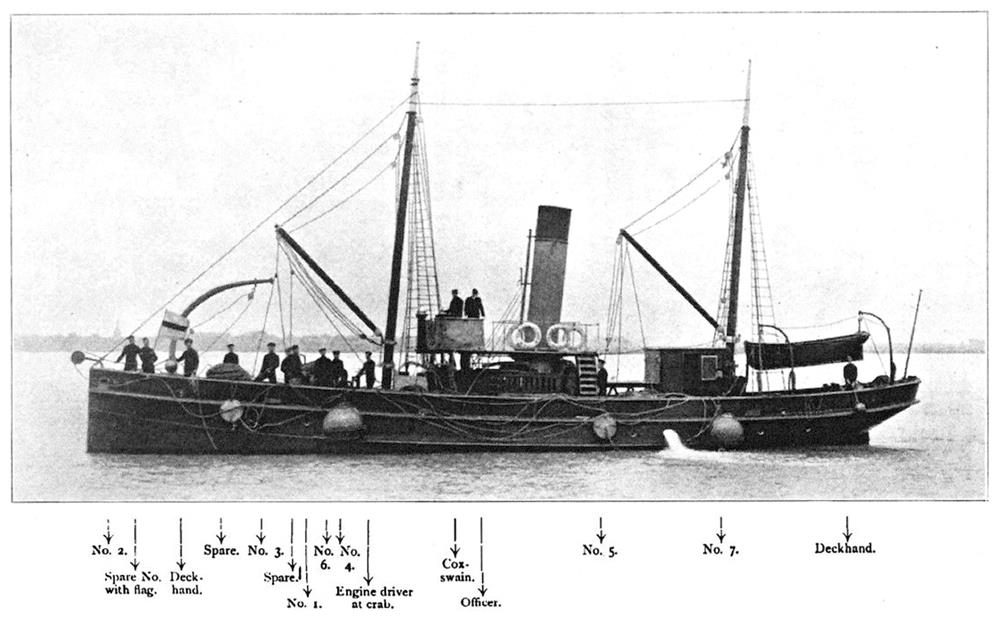
A mine-laying vessel, with a pair of mines, along with their connecting cables and sinker weights slung alongside before deployment.
The sinker or mine lay outside the vessel against the rubbing streak, and on reaching the position of the mine, one end of the short manila rope was let go and the weight slid down into the water. Sufficient cable was slung outboard to enable the weight to reach the bottom, and the remainder of the cable laid was laid out in a coil [to be managed by the junction-box party], latterly this coil was placed in a vertical wooden drum, designed by Capt. Organ of the Coast battalion, which facilitated paying out the cable.
A skilled crew was needed to get the boat into the right position relative to the planned position of the mine, the location of the adjacent junction boat, wind, tide, and the side of the vessel on which the mine was slung. The ideal was that when the mine was let go, the vessel would drop down gently next to but not touching the junction boat, pass over the cable from the mine, then go ahead to the location of the next mine.
The junction-box party consisted of two men capable of making joints, and one or two boatmen. They had to make the necessary joints, and any connections required when making tests, then lower the junction boxes without fouling any cables. The junction box linked the single-core cable from each pair of mines to four-core cable connected to the shore station. When the junction box was open on board the junction boat, a telephone connection was made to the shore station. Once the box was closed, orders were sent by signal flags.
Once everything was ready, the junction-box was lowered overboard, and final tests completed from the shore station, before the junction-box boat could leave its moorings and proceed to the next set of connections.
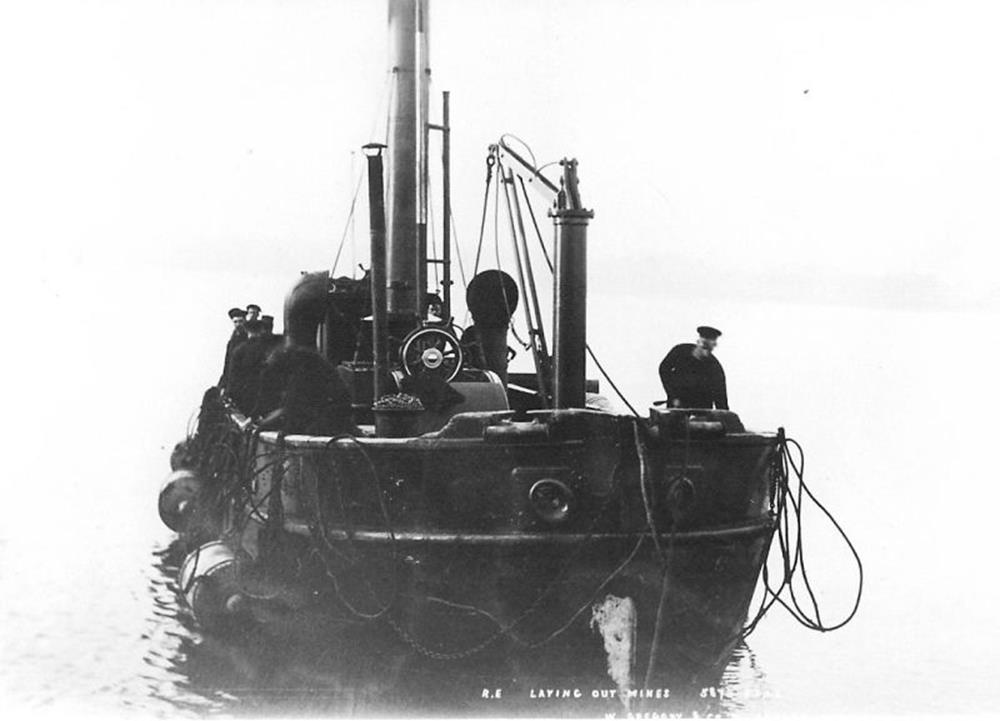
Laying mines in the Solent – 1897
Test room party
There were usually two or three men in the test room, and two men on each position finder, with a signalling party of two men at some prominent point, with a telephone connection to the test-room.

A Test Room – 1880
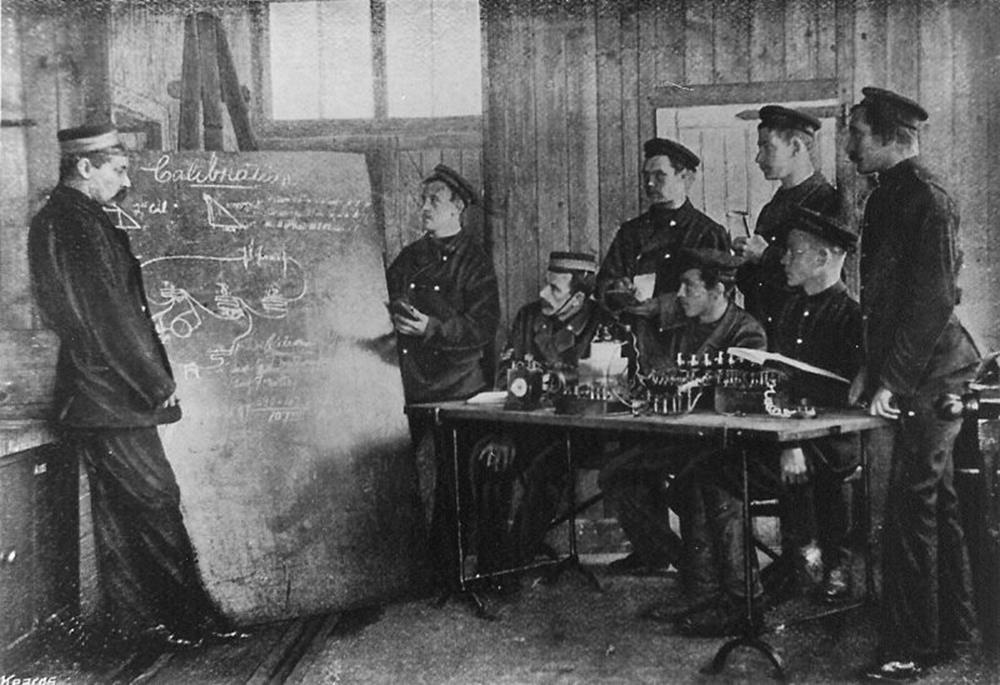
Instruction in the Test Room – 1897
With two laying-out vessels, twenty mines could be laid out in an hour, and as three or four tests were required for each mine, the tester had a busy time.
The alignment parties were usually required to hold up poles or flags in positions marked by pickets or sockets. They communicated with the vessels by flag signalling.
When mines had to be picked up, the order of operations was reversed, and the mines could be picked up very quickly. If any of the cables became fouled, either by mistake, or the action of tides, or if a cable broke, it took a great deal of skill and experience to unravel the knots. An axe was provided as a last resort, but it was considered bad form to have to use it!
Time to deploy a minefield
The average work rate for each operation was as follows:
Priming – four to six apparatus an hour for each pit
Connecting up – one party could connect up a group of EC mines in 20 to 25 minutes.
Embarking – with suitable cranes, four to six groups of EC mines in 20 to 35 minutes.
Laying – about eight EC mines an hour, sometimes ten or twelve, depending on the skill of the coxswain manoeuvring the boat.
Raising mines – four to six EC mines an hour.
With experienced teams, it was possible for two laying boats and associated parties to deploy a minefield of 100 mines in a 10 hour working day from 7.45 am to 5.45 pm. This performance was considered to be typical.
So the 140 to 180 mines needed to span the Forth could have been deployed comfortably in two working days. But only because of constant training and practice by these dedicate teams of volunteers.
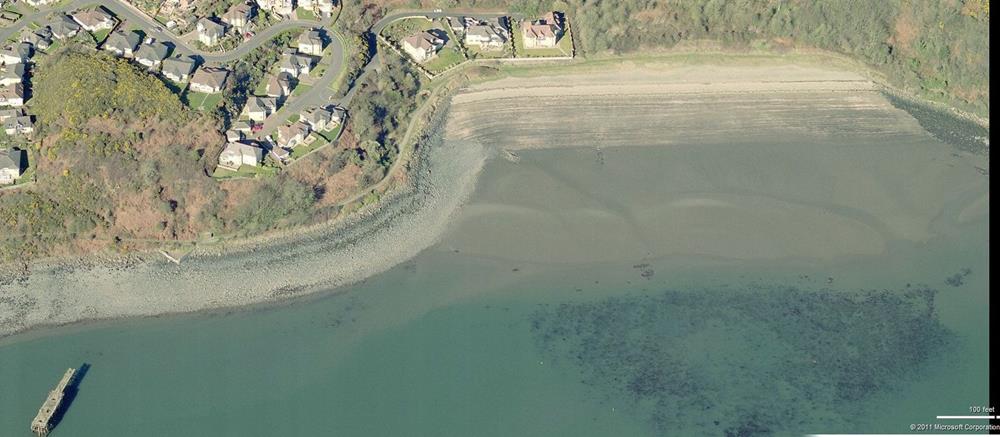
Port Laing beach today, more than a hundred years after the volunteers left. All that remains is the skeleton of the Gov’s pier, and the concrete base that was the foundation for the shore station.
The minefield was never deployed in anger – it was a deterrent weapon, just knowing that it was there was enough to make an enemy think again.
Electrical Control of a Mine
For those with an interest in the engineering behind the mine field, here is a separate Appendix on this subject.
Sources
The general history of the Submarine Mining service is largely drawn from “History of Submarine Mining in the British Army” by William Baker Brown. It is a print on demand book, available from Abe books (among others.)
Brown joined the service in 1885, as an Assistant Instructor in Portsmouth. In 1892 he became Chief Instructor at Chatham, and in 1901 Inspector of Electric Lights. He was in that post when the service closed in 1905.
The photographs of mining operations came from the Fort Gilkicker (near Portsmouth) web site
The details of the various camps on Inchkeith, South Queensferry and North Queensferry from 1888 to 1905 came from the journals and photographs of Henry Cadell, copies of which were very kindly provided by his grandson, William Cadell.
Project Gutenberg’s Torpedoes and Torpedo Warfare, by C. W. Sleeman was a useful source of technical information on the operation of mines
The diagrams and explanation of electrical operation are mine, based on information from the books above, and the patent mentioned in the text.
Admiralty charts are from the National Library of Scotland on-line map section
Gordon Barclay kindly provided the War Office maps related to Carlingnose and Inchgarvie.
Other material came from Wikipedia.
Errors and omissions are all mine.
Acknowledgments
Special thanks are due to William Cadell, who kindly gave me access to his grandfather’s journals and photographs which brought this article to life.
Boyd Williamson – May 2018
top of page
